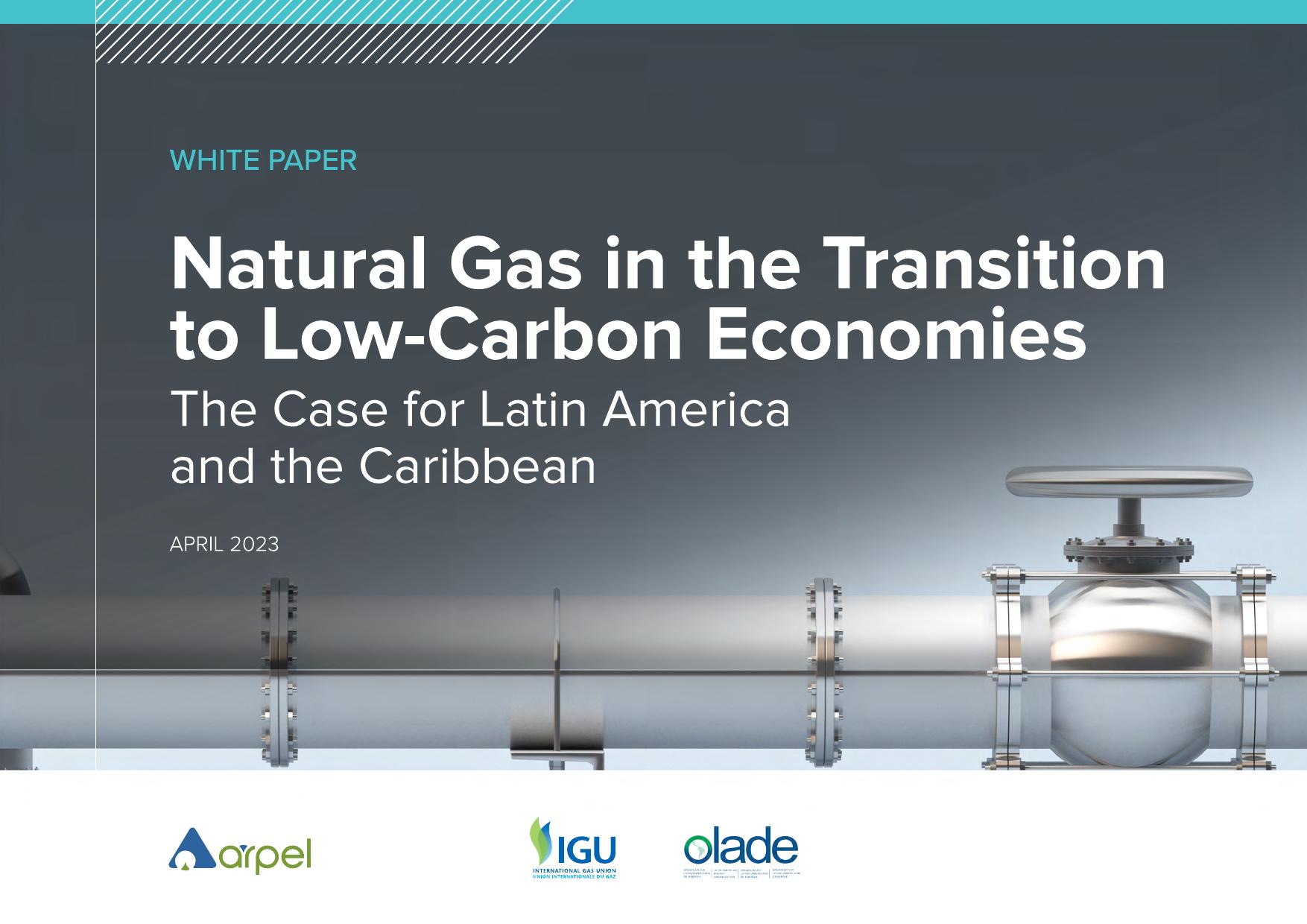TABLEOFCONTENTS1ASSOCIATIONOFOIL,GASANDRENEWABLEENERGYCOMPANIESOFLATINAMERICAANDTHECARIBBEANTABLEOFCONTENTS2Thispaperwaspreparedbythefollowingthreeorganizations:InternationalGasUnion,ARPEL,andOLADE,withthesupportandcooperationofmanyexpertsandleaders.AcknowledgmentsAuthors:MartaGonzálezSeniorAdvisor,PublicAffairsDirectorate,InternationalGasUnion(ProjectLeader)PabloFerragutManagingDirector,ARPELGuillermoKoutoudjianActingDirectorofIntegration,Access,andEnergySecurity,OLADELiYalan,President,InternationalGasUnionandthePresidencyteamAndreaStegher,VicePresident,InternationalGasUnionMiltonCatelin,SecretaryGeneral,InternationalGasUnionLesleyColdham,PublicAffairsDirector,InternationalGasUnionCarlosGaribaldi,ExecutiveSecretary,ARPELMiguelMoyano,SeniorManagingDirector,ARPELMaríaEugeniaGuzmán,CommunicationsManager,ARPELJanetCésar,RegionalCoordinator,ARPELAlfonsoBlancoformerExecutiveSecretary,OLADEAndrésRebolledo,ExecutiveSecretary,OLADEGuidoMaiulini,ChiefofStaff,OLADEFabioGarcía,AssociateSpecialistOLADEThethreeorganizationscoordinatedthepreparationofthispaperwithspecialacknowledgmentsto:Specialcollaboratorsandcontributors:ABEGAS(AssociaçãoBrasileiradasEmpresasDistribuidorasdeGásCanalizado)IeadaGomesYell,HonoraryMember(SeniorVisitingFellowOxfordInstituteforEnergyStudiesandSeniorAdviserFGVEnergia,Brazil)ABIOGAS(AssociaçãoBrasileiradoBiogás)LetíciaLorentz,TechnicalCoordinator.TamarRoitman,ExecutiveManagerAGN(AsociaciónGasNaturalChile)–CarlosCortésSimón,ExecutiveChairman(RegionalCoordinatorIGU)ATGAS(AssociacaodeEmpresasdeTransportedeGás)–RogérioManso,ChiefExecutiveOfficerAVPG(AsociaciónVenezolanadeProcesadoresdeGas)–TitoBonnadonna,ExecutiveDirectorCBHE(CámaraBolivianadeHidrocarburosyEnergía)–StevoOstoic,BoardMemberIAPG(InstitutoArgentinodelPetróleoyGas)–ErnestoLópezAnadón,President//EduardoAbriata,TechnicalManagerOil&GasIBP(InstitutoBrasileirodePetróleoeGás)–Sylvied’Apote,ExecutiveDirector-NaturalGas//FelipeBotelho,SpecialistNaturgas(AsociaciónColombianadeGasNatural)–LuzStellaMurgas,President.CamiloMorales,SecretaryGeneralColumbiaUniversity’sCenteronGlobalEnergyPolicy–DiegoRiveraRivota,ResearchAssociate.LeonardoBeltranRodriguez,DistinguishedVisitingFellow(ExecutiveFellowTheSchoolofPublicPolicy,non-residentFellowInstituteoftheAmericas,BoardMemberSEforALL,FormerDeputySecretaryofEnergyMexico)energiE–JuanAndrésVergara,MarketsDirector.DanielSalazar,AssociateDirector.GlobalCCSInstitute-RuthIvory-Moore,PolicyandAdvocacyManager,AmericasRystadEnergy–VitorSanchez,SeniorClientSuccessManager.ErnestoDiaz,SeniorVicePresidentLatinAmericaWoodMackenzie–ViniciusDinizMoraes,ResearchAssociate.MelissaTarver,AccountDirector-EnergyStrategics.AdrianLara,PrincipalResearchAnalyst.JulieWilson,DirectorEnergyResearch.Manyseniorgovernmentofficialsandinternationalexpertsandmorethan60organizations,amongthemNOCsofLatinAmericaandtheCaribbean,IOCs,energycompanies,consultancycompanies,thinktanks,financialinstitutions,andglobalorganizations,providedinputduringtheFirstStakeholderDialogueinRiodeJaneiro,andreviewedthepreliminarydraftsofthereporton23Februaryand23March.Theircomments,suggestions,andcontributionswereofgreatvalue.Editor:MarkBlacklockDesigner:FernandaAretaTABLEOFCONTENTS3Disclaimer:Thedenominationsusedinthemapsandthewayinwhichthedatatheycontainarepresenteddonotimply,onthepartofIGU,ARPEL,andOLADE,anyvaluejudgmentregardingthelegalstatusandthepolitical-administrativedivisionofthecountries,territories,cities,orareas,oroftheirauthorities,norregardingthedelimitationsoftheirfrontiersorlimits.Theinformationcontainedinthispaperisbasedonglobalenergydatabasesandtools,publicinformation,industryreports,andothergeneralresearchandknowledgeheldbytheorganizations.TheinformationcontainedhereindoesnotnecessarilyrepresenttheviewsoftheMembersofIGU,OLADE,andARPEL.Thepaperissubjecttorevisions.IGU,OLADE,andARPELdisclaimanyresponsibilityorliabilityforcontenterror.Theyarenotresponsibleforanyactionstakenbythe“Recipient”oranythird-partybasedoninformationcontainedinthispaper.Nothingcontainedinthispaperconstitutesanoffertobuyorsellsecuritiesorinvestmentadvice.Thispaperdoesnotprovideacomprehensiveanalysisofthefinancialpositionorprospectsofanycompanyorentity,andnothinginitshouldbetakenasacommentregardingthevalueofthesecuritiesofanyentity.Copyright©IGU,ARPEL,andOLADE2023Thispublicationmaybereproducedinwholeorinpartinanyformforeducationalornon-profitpurposeswithoutspecialpermissionfromthecopyrightholders,aslongasacknowledgmentofthesourceismade.NouseofthispapermaybemadeforresaleorforanyothercommercialpurposewhatsoeverwithoutpriorpermissioninwritingfromIGU,ARPEL,andOLADE.TABLEOFCONTENTS4Acknowledgement...........................2Disclaimer...................................3Foreword....................................5ExecutiveSummary........................7Section1IntroductionandRationaleIntroduction..................................15Rationale....................................18Section2NaturalGasScenarios.....................19Section3LatinAmericaandtheCaribbeanOverviewSocio-EconomicOverview....................28EnergyandGHGEmissionsOverview..........37Section4KeyDriversforNaturalGasDevelopmentandDecarbonizationGasResourcesDevelopmentforEconomicProsperity..................................48Gas-to-Power...............................55Hard-to-AbateSectors........................61Enablinglow-carbonsolutions�(CCUS,Hydrogen,Fertilizers,�Biogas,andBiomethane)...........67OtherKeyStrategicIssues(EnergySecurity,RegionalIntegrationandESGPerformance)......81Section5Countries’InsightsArgentina...................................95Bolivia......................................99Brazil......................................104CentralAmericaandTheCaribbean...........112Chile.......................................116Colombia..................................122Ecuador...................................126GuyanaandSuriname.......................130Mexico.....................................133Peru.......................................137Trinidad&Tobago...........................142Venezuela..................................146Section6FinalRemarks...........................150Annexes...................................153Glossary....................................154Abbreviations...............................157TableofcontentsTABLEOFCONTENTS5ForewordTheoilandgasindustryofLatinAmericaandtheCaribbeansharesthecommunalsenseofurgencyforcurbingtheprojectedeffectsofglobalclimatechange,bytransitioningourregionalprimarymatrixtobeingevenfurtherweightedbyrenewableandlow-emissionenergysources.ARPELhasundertakenasamissiontodrivethenecessarytransformationofthesectorinthisregionandhasincorporatedrenewableenergyintoitsscope.Beinganeclecticregion,wealsounderstandthattransitionsneedtobejustandbespoketonationalandevenlocalenergystructure,development,andpovertysituations.Thesetransitionpathsarenaturallyhinderedbycomplexitiesanduncertainties,suchasassuringenergysecurityandsovereigntyinascenarioofgrowingpopulationsandeconomies,diverselevelsofvulnerabilitytoclimatechange,anddifferinghierarchiesofnationalandsocialpriorities.Asitnamesimplies,transitiondoesn’tmeanabruptreplacement.Itentailshavingthenecessaryrealismandpragmatismtoseeksynergiesand“quickwins”towardsthedecarbonizationgoals.Naturalgasisthusanidealtransitionfueltofillthegapbetweenenergydemandandrenewableandlowemissionssupply:bygraduallydisplacingcoalandheavierpetroleum-derivedfuels;byextrapolatingitscompetenciesandinfrastructuretoCCUS,biomethaneandhydrogen;andbyprovidingasynergisticuninterruptible,CarlosGaribaldiExecutiveSecretaryARPELtechnologicallyavailableanddeliverable,reliable,andeconomicallyaccessiblebasistosolarandwind,forexample.Wherethereisnorain,sunshineorwind,ournaturalgaswillstillbethere.Thisdocumentprovidesanoverviewoftheroleofnaturalgas,complementedbylowercarbon/greengases,intheenergytransitioninthespecificcontextofLatinAmericaandtheCaribbean.Itaimstocontributetotheinternationalenergydialogue,tohelpintheunderstandingofthecriticalbenefitsthatgasescanbringtotheenergytransition,andtoprovideevidenceandinsightstoinformenergystakeholdersabouttheuniqueopportunitiesandchallengesofthisimportantregion.Theglobalenergyandfoodshortagesofthepastyearhaveshownthatthemarketwillrespondquicklytopricesignals–forexamplebyrapidlyincreasingLNGexportstoWesternEuropeby66%in2022–butthosehighpriceshavebeendevastatingtoconsumersatalllevels.Factorieshaveclosed,businesseshavecutbackactivity,individualsandfamilieshavehadtoresorttofoodbanksinunprecedentednumbers.Onelessonfromlastyearhasbeenthatpolicymakersneedtopaycloserattentiontobalancingtheclearneedforclimateactionwiththeimperativesofenergysecurityandenergyaccess.Renewablescertainlyneedmoreinvestment,butitisconcerningthatwhilegovernmentsarenotmakingthoseinvestmentsattherateandscalerequired,theyarealsoneglectingindigenoussuppliesofnaturalgasthatcouldfuelpovertyalleviation,andbusinessandcommunitydevelopment.Withtheworld’spopulationestimatedtoexpandbymorethan2billionpeopleby2050energydemandisindangerofgrowingfasterthanlow-carbonenergydeployment,resultinginmorecoalconsumptionandfarhighergreenhouseemissionsofbothcarbondioxideandmethane.Thechallengeforcountriesinthisregionismuchgreaterthanforthoseinthedevelopedworld.Firstly,intermsoffinancingcostsandsecondly,becausethedistributionofsubsidiestotechnologiesthatarenotreadybankable,competeswithotheressentialpriorities,suchashealth,educationandpensions.MiltonCatelinSecretaryGeneralIGUEnergypolicyfortheregionthereforeneedstobecomemorepragmaticthanithasbeen,withgreaterfocusonlongtermsecurityofsupplybalancedagainsttheurgencyofajustenergytransitionthatrecognizesintra-regionaldiversity.Naturalgas,andotherlowcarbongasesareinvaluabletoolsfortheregiontoreachanetzerofuture,whileavoidingvolatilityandeconomichardshipandinvestmentinnewsupplymustnotonlycontinue,butgrow.TABLEOFCONTENTS6IGUIGUwasfoundedin1931andisaworldwidenon-profitorganizationrepresentingmorethan150gasandrelatedserviceindustrymembersworldwideonallcontinents.ThemembersofIGUarenationalassociationsandcorporationswithinthegasindustryandrelatedservicesworldwide,coveringover90%oftheglobalgasmarketandworkingineverysegmentofthegasvaluechain,fromthesupplyofnaturalanddecarbonizedgas,renewablegas,andhydrogen,throughtheirtransmissionanddistribution,andallthewaytothepointofuse.IGUholdsthestatusofUNFCCCnon-governmentalorganizationobserverattheUNClimateChangeConferences(ConferenceoftheParties)andhasparticipatedineveryconferencefromCOP1toCOP27.ARPELARPEL,isanon-profitassociationgatheringoil,gas,andrenewableenergysectorcompaniesandinstitutionsinLatinAmericaandtheCaribbean.Foundedin1965asavehicleofcooperationandreciprocalassistanceamongsectorcompanies,itsmainpurposeistoactivelycontributetoindustryintegrationandcompetitivegrowth,andtosustainableenergydevelopmentintheregion.ItsmembershipcurrentlyrepresentsahighpercentageoftheupstreamanddownstreamactivitiesinLatinAmericaandtheCaribbeanandincludesnationalandinternationaloperatingcompanies,providersoftechnology,goodsandservicesforthevaluechain,andnationalandinternationalsectorinstitutions.Since1976,ARPELhasheldSpecialConsultativeStatuswiththeUnitedNationsEconomicandSocialCouncil(ECOSOC).In2006,theassociationdeclareditsadherencetotheUNGlobalCompactprinciples.OLADEOLADE,theintergovernmentalbodyofcooperation,coordinationandtechnicaladvisoryoftheenergypublicsectorofLatinAmericaandtheCaribbeanwasestablishedin1973bythesigningoftheLimaAgreement,ratifiedby27countriesinLatinAmericaandtheCaribbean,withthefundamentalobjectiveofpromotingtheintegration,conservation,rationaluse,commercialization,anddefenseoftheregion’senergyresources.ThisworkseekstoprovideanoutlineoftheroleofnaturalgasandotherlowcarbongasesinthedifferenttransitionsthataretakingplaceinLatinAmericaandtheCaribbean.Transitions,asaplural,isakeyconcepttoacknowledgethediversityofourregionalcontext.Naturalgasis,forsomecountriesinourregion,theprivilegedwaytowardsalowercarbonmatrix.Energytransitionstowardscleanerenergysystemshavenaturalgasasakeyresourceinordertoachievethereductionofgreenhouse-gasemissionsandtheimprovementoftheairqualityofourcitieswithoutpenalizingconsumption,productionandemploymentineconomieshardlyhitbythepandemicandtheglobalenergycrisis.ThecomplementationthatexistingnaturalgasinfrastructureprovidestotheintermittenceofrenewableenergysourcesisparamounttothelongtermenergysecurityofLatinAmericaandtheCaribbean.Advancingregionalintegrationinnaturalgaswithnewinfrastructurewillonlystrengthenthereliabilityanddependabilityofourenergysystems.Ourregionstillstruggleswithpoverty,lowgrowthandinvestmentandlackofenergyaccess.Naturalgascanprovidealow-costenergysourcethatenhancescompetitivenessandbringsabouthigherratesofeconomicgrowthwhileextendingthereachofcleanfuelsforcookingandreducingemissionsofgreenhousegasesandparticulatematerial.AndrésRebolledoExecutiveSecretaryOLADETABLEOFCONTENTS7TABLEOFCONTENTS8GASWHITEPAPERLAC/EXECUTIVESUMMARYGASWHITEPAPERLAC/EXECUTIVESUMMARYTheworldneedsamassivetransformation,andnaturalgasisessentialforitCollaboration,pragmatism,andputtingpeoplefirstareparamounttoacceleratingthetransitionNaturalGas�intheTransition�toLow-Carbon�EconomiesTheCasefor�LatinAmerica&theCaribbeanExecutiveSummaryTheworldneedstotransitiontolow-carboneconomiestoreduceglobalwarmingwhilecontinuingtopromotesustainablesocio-economicdevelopmentforagrowingglobalpopulation.Achievingthismassivegoalrequiresaradicaltransformationinhowenergyissuppliedandusedworldwide,as73%ofglobalgreenhousegas(GHG)emissionsaregeneratedbyenergyuse,particularlybyburningfossilfuels,representingroughly80%oftheworld’sprimaryenergysupply.Transformingtheenergysectorattheneededscaleandpaceisaherculeantask,towhichalltheplayersintheenergylandscapemustcontribute,whilerecognizingthatthetransitionwillrequiredifferentpathwaysandoptionsfordifferentconditions,thusbeingindeed“transitions”ratherthanauniquelinearsequence.Additionally,widespreadpovertyandpopulationgrowthurgeustolookatenergysecurity,foodsecurity,andaffordability1.Transitionsuccessisbasedonbothdecarbonizationandsocio-economicdevelopment;2.Thetransitionisacomplexprocessthatneedsprofoundsocial,economic,andtechnologicalcountry-specifictransformations;ascornerstonesofthecurrentdebate,wheresocio-economicdevelopmentisanessentialaspectindevelopingandlow-incomecountries;allofthemarebeingnegativelyaffectedbytheongoingcrisis.Thiswhitepaperprovidesastrategicapproachtotheroleofandcriticaldriversforthedevelopmentofnaturalgastoday(complementedbylower-carbon/greengasesinthemediumterm)intheenergytransitioninthespecificcontextofLatinAmericaandtheCaribbean.Itaimstocontributetotheinternationalenergydialogue,tohelpintheunderstandingofthecriticalbenefitsthatnaturalgascouldbringtotheenergytransition,andtoprovideevidenceandinsightstoinformenergystakeholdersabouttheregionalsituationinparticular.3.Thereisnosingletransitionpathway,andthisprocessmustbejust(linkedtostartingpointcircumstance)andpeople-centeredtobeacceptableandsuccessful;4.Definingbalanced,timely,effective,andconsistenttransitionpathwaysneedscollaborationbetweenallstakeholdersandhighlevelsofpragmatism.Thefourmainpillarsthiswhitepaperisfocusingonarethefollowing:TABLEOFCONTENTS9GASWHITEPAPERLAC/EXECUTIVESUMMARYGASWHITEPAPERLAC/EXECUTIVESUMMARYNaturalGas�intheTransition�toLow-Carbon�EconomiesTheCasefor�LatinAmerica&theCaribbeanExecutiveSummaryThefutureoftheenergymixisdeeplyuncertainThefutureofenergyisthushighlyuncertain.Whilethedrivingforceofclimatechangeandtheconsequentneedtotransitiontoalow-carbonenergysystemareevident,thenatureofthemixinthedecadestocomelooksmuchmoreindeterminate,mainlybecauseitisnotpossibletoaccuratelypredicthowandwhenalternativetechnologieswillmature,reachthecommercialstage,andachievewide-rangingdeployment.Thispaperconsidersthescenariospreparedbythemostreputableinternationalorganizationstoshedsomelightonthefutureofnaturalgas.Someofthekeymessagesextractedfromthisglobalscaleanalysisarethefollowing:•Energydemandwillmostlikelyincrease,drivenbypopulationgrowthcompoundedbyeconomicdevelopment,evenconsideringimprovementsinenergyefficiency;•Regardingtheroleofdifferentsourcesinthefutureenergymix,thereisuncertaintyabouthowtofillthegapbetweensupplyanddemand,andthereisnoalignmentonthesharethatnaturalgaswillrepresent.However,uptonow,allthescenariosstillcontemplatetheparticipationofcoalandotherfuelswithaworsecarbonfootprintthannaturalgas,whichdrivesustoenvisionotheralternativescenarios.Additionally,thereistheneedtoevaluatewhat-ifscenarios,mainlyinviewofnewconstraintsofmineralsandmetalsintermsofbothenhancedsuitablesupplyanddiversification;•Somealmostcertainthingscanbestated;firstly,therewillbeadvantagesforthedevelopmentoflow-carbongasessuchasbiomethane,hydrogen(blue,green,andturquoise),andnaturalgaswithcarboncapture,utilization,andstorage(CCUS)aspartofallscenarios,withagrowingcontribution;•Theroleoffertilizerswillbeheightenedinthecomingyearsbypopulationgrowthandinparticular,bynitrogenfertilizersusinghydrogenasfeedstock.Ontheotherhand,thepossiblerolesofhydrogenasacarrieranditsuseinbiofuelsandsyntheticfuelsopenanewcompetitionfrontforthefertilizerindustry.Inbrief,tokeepfoodpricesaffordable,alllow-carbonhydrogentechnologiesshouldbeconsidered;•Furthermore,thenaturalgasindustryshouldstriveto“green”naturalgas,developingnewalternativesandreducingthecarbonfootprintofcurrentoperations,especiallybyreducingmethaneemissions,whichisawin-winbothfromtheclimateandtheeconomicperspectives;•Besides,naturalgasdemandwillmostlikelygrowinthedevelopingworld,particularlyinAsia.Incontrast,thedevelopedworldisexpectedtodeceleratefossilfueldemand,drivenbymorestringentclimatepolicies;•LNGtradeandinfrastructureareexpectedtogrowfurther,addingflexibilityandsecuritytotheenergysupplywhileopeningopportunitiesfordevelopingothermarkets,suchasbunkering.LatinAmericanandCaribbeancountriescouldtakeadvantageofthecurrentwindowofopportunitytofosterthecreationofaregionalmarketbypromotingtheappropriateconditionsforinvestmentinexplorationandproduction(E&P)andgasinfrastructurestosupportmarketneeds.IncountriesenjoyingnaturalgasresourcesintheLatinAmericaandCaribbeanregion,thepromotionofbestpracticesforadditionalE&Pinvestmentscouldalsobeastronglevertosupportpublicfinanceequilibrium.TABLEOFCONTENTS10GASWHITEPAPERLAC/EXECUTIVESUMMARYGASWHITEPAPERLAC/EXECUTIVESUMMARYGASWHITEPAPERLAC/EXECUTIVESUMMARYNaturalGas�intheTransition�toLow-Carbon�EconomiesTheCasefor�LatinAmerica&theCaribbeanExecutiveSummaryThetransitionmustbeaccelerated,butasalternativeoptionsarenotyetfullyscalable,thereareconsiderablerisksofunintendedconsequencesAsstatedabove,energydemandisexpectedtogrowinthecomingdecades,openingagapbetweenenergysupplyanddemandthatmustbefilledwithdifferentenergysources.Howthisgapwillbebridgedisfarfrombeingneutral.Whilerenewableenergieshavebeenrapidlygainingmarketshareintheglobalenergysupply,mainlyinthepowersector,thesealternativelow-carbonsolutionsarenotyetmatureenoughtofilltheexpectedgapbetweensupplyanddemandformanyverywell-knownreasons,suchastechnologyreadiness,infrastructuredevelopment,orpotentialsupplychainbottlenecks.Whileinvestmentshouldbefosteredtoovercomethesechallenges,itshouldbeacknowledgedthattheywillnotbesolvedattheneededpace,sopartofthegapwillneedtobecoveredwithnaturalgasasasubstituteforcoalandincreasinglylower-carbongases.Acceptingthisfactwouldleadtomorebalanced,pragmatic,realistic,andthuseffectivetransitionpathways,asputtingtoomuchpressureonunrealisticpathwayscouldleadtobottlenecksthatmayfinallyfavormorecarbon-intensivealternatives,thusdelayingthetransition.Besides,thechallengefordevelopingandlow-incomecountriesismuchgreaterthanfordevelopedones,firstlyintermsoffinancingcostsandsecondly,becausethedistributionofsubsidiestotechnologiesthatarenotreadybankablecompeteswithotheressentialpriorities,suchashealth,education,andpensions.DecarbonizationinLatinAmericaandtheCaribbeanisnotonlyamatterofenergyTheregioncontributesapproximately8%oftheworld’stotalGHGemissionsannually;however,lessthanhalfoftheseemissionsarederivedfromenergyuse.Energyuseaccountsforonly43%ofLatinAmericanandCaribbeanGHGemissions,adistinctiveemissionsprofile(vis-à-vis73%globally).Thelimitedenergycontributionisdrivenbyelectricitywithlow-carbonintensity,typicallywithamuchlargershareofhydropowerandnaturalgas,thanofcoal.Othersectorssuchasagriculture,averyimportanteconomicactivityinmanycountries,andlandusechanges,mainlybecauseofthedeforestationoftheAmazonrainforest,haveagreaterimpactthanenergyuse,accountingfor45%oftotalGHGemissions.Thisfactgreatlyimpactsenergypolicy,climateaction,anddecarbonizationpriorities.LatinAmericanandCaribbeancountriesmustthusbuildtheirownclimateagendasfortheenergysector,balancingeconomicdevelopmentanddecarbonizationattheglobalscale.TABLEOFCONTENTS11GASWHITEPAPERLAC/EXECUTIVESUMMARYGASWHITEPAPERLAC/EXECUTIVESUMMARYNaturalGas�intheTransition�toLow-Carbon�EconomiesTheCasefor�LatinAmerica&theCaribbeanExecutiveSummaryLatinAmericaandtheCaribbeanfallsbehindintermsofeconomicdevelopment,butmonetizationofnaturalgasresourcescanleadtogreaterprosperityLatinAmericaandtheCaribbeanisavastandheterogeneousregion,wheremostcountriesareratedasmiddletolow-incomebytheWorldBank.Povertyandinequalityarebyfartwoofthemostcriticalsocio-economicchallengesintheregion.AccordingtotheEconomicCommissionforLatinAmericaandtheCaribbean(ECLAC),one-thirdoftheregion’smorethan650millioninhabitantsliveinpoverty,13%inextremepoverty,andtherearehighlevelsofinequality.However,theregionisrichinnaturalgasresourcesandthenaturalgassectoriswell-establishedinmanycountries,makingsignificantcontributionstoGDP,foreigninvestment,jobcreation,andsocialwelfare.Inthispaper,manymonetizationopportunitiesandsuccessstoriesarehighlighted.CountriessuchasTrinidad&Tobago,Peru,andBolivia,haveshowntremendouseconomicgrowthinthelasttwodecadesthankstoexport-leddevelopmentsofnaturalgasresources,thefirsttwointegratedintotheglobalmarketviaLNGandthelatterviapipelinestoneighboringcountries.TheVacaMuertaplay,intheNeuquenbasininArgentina,isamassiveunconventionalreservoirsuccessfullybeingdevelopedthathasattractedUS$20billionininvestmentsandhasthepotentialtomakeArgentinathenextmajorLNGexportingcountry.Brazilshowsopportunitiesinthepre-saltregion,Colombiahasdemonstratedthepositiveroleofastronggaspenetrationandhasexcellentpromiseinitsrecentoffshorediscoveries,whileGuyanaandSurinamearethetworisingstarsoftheoilandgasindustrybecauseofmassivediscoveriesthathavebeenmadeoffshore,openingtheopportunityfordramaticallyboostingtheireconomies.ThereisawindowofopportunitytomonetizenaturalgasresourcesinLatinAmericaandtheCaribbean,contributingtothedecarbonizationofsomesectorsoftheregionandthemainemittingregionsintheworld.Forthispurpose,theroleofpublicandprivatecompanies—localandinternational—iscrucial,asarethecontributionsofpolicymakersandregulators,acceleratingtheregulatorydevelopmentthatcreatesastableframeworktoattractinvestmenttotheregion.Energytransitionsshouldnotbeneutraltotheirimpactsinpovertyandinequality.Justtransitionsneedtobedeployed.ForLatinAmericaandtheCaribbean,thismeanstakingadvantageofnaturalgasresourcestocontributetoeconomicdiversification,sustainablegrowth,andenergytransition.TABLEOFCONTENTS12GASWHITEPAPERLAC/EXECUTIVESUMMARYGASWHITEPAPERLAC/EXECUTIVESUMMARYNaturalGas�intheTransition�toLow-Carbon�EconomiesTheCasefor�LatinAmerica&theCaribbeanExecutiveSummaryLatinAmericaandtheCaribbeannaturalgascanhelptophase-outcoalinpowergenerationgloballyandenablerenewablesintheregionCoalstillrepresents43%oftheprimaryenergysupplyforpowergenerationglobally,mainlydrivenbyfourlargecountries:China,India,theUSA,andRussia.In2021,51%ofadditionalpowergenerationwasproducedbycoal,32%byrenewables,and9%bynaturalgas;so,whilecoalisbeingphasedoutinmanycountries,itisstillthemajorsourcetosupplyelectricitydemandgrowth.Coalemits2.6timesmoreCO2thannaturalgasforpowergeneration,whilenaturalgasprovidesatthesametimeenergysecurityandflexibility,anessentialfeatureforthedevelopmentofintermittentrenewableenergy.Incentivizingamixofnaturalgasandrenewableenergytosubstitutecoalisalow-hangingfruittoacceleratethetransition;naturalgasresourcesfromLatinAmericaandtheCaribbeancouldcontributetosupplyingthegasneededfortheglobalshiftawayfromcoal.AverydifferentsituationexistsregionallyinLatinAmericaandtheCaribbean,wherethepowermixisdominatedbyhydropower,coalplaysonlyamarginalrolewith5%ofthemarketshare,andnaturalgashasmanyfunctionsdependingonthecountryconsidered(baseload,peak-shaving,flexibility,etc.).Thereisroomfornaturalgastoreplacecoalforpowergenerationintheregion,mainlyinChile,whereitrepresentsaroundone-thirdoftheshare,butalsoinCentralAmericaandtheCaribbean,whereexpensive,imported,andhighlypollutingfueloil,dieselorcoalplayacentralrole.LNG-to-powerprojectshavebeensuccessfullydevelopedintheDominicanRepublic,Panama,ElSalvador,andJamaica.IncountrieslikeBrazil,naturalgasiscrucialinprovidingflexibilitytothepowersector.Thiswasevidentduringthelastmassivedroughtin2021whenwaterreservoirshitrecordlows,andLNGimportshitrecordhighs.NaturalgasisthedominantsourceofenergyforpowergenerationonlyinafewcountrieslikeArgentina,Bolivia,Trinidad&Tobago,andMexico.Thispapershowshownaturalgashashelpedtovastlyreduceemissionsinsomecountries.Inbrief,thinkingaboutnaturalgasintheregion’spowersectorimpliesunderstandingthespecificrolethatnaturalgasplaysintheparticularcontextbeingconsidered.Additionally,withamoremedium-termfocus,newcombined-cyclegasturbine(CCGT)powerplantscanconsumebothnaturalgasandhydrogen,thusreinforcingtheroleofgaseousmoleculesinensuringareliableenergysupplyincaseofrenewables’intermittency.TABLEOFCONTENTS13GASWHITEPAPERLAC/EXECUTIVESUMMARYGASWHITEPAPERLAC/EXECUTIVESUMMARYNaturalGas�intheTransition�toLow-Carbon�EconomiesTheCasefor�LatinAmerica&theCaribbeanExecutiveSummaryRoadtransportisaprioritysectorfortheregionInLatinAmericaandtheCaribbean,becauseoftheregion’sgeographyandeconomicsystem,primarilybasedontheexportsofnaturalresourceslocatedinlandatgreatdistancesfromtheports,thetransportsector’sshareofCO2emissionsismuchhigherthaninotherregions,around40%,andreachingapproximately600MtofCO2/perannum(OLADEPanoramaEnergético,2022).Thebulkofgoodsandpeopletransportation(about85%oftonne-km)isdonebytrucksandbusesfueledbyinefficientdieselengines.Combustingnaturalgasproduces27%fewerCO2emissionsthandieselfuelonanenergyequivalentbasis,soshiftingtonaturalgascanbringquickwinsandsustainablesolutionswherenaturalgasisabundant.Thiswillavoidgeneratinglock-insorstrandedassetsinthisverycomplexsector,wheremanytechnologiesarejustemerging(e.g.,electric,hydrogen,etc.).Atthesametime,naturalgasuseisreducingsubstantiallypollutantslikeSOxandNOx,therebyimprovingairqualityinthecitiesandtheregionatlarge.Therearemanysuccessstoriesdetailedinthecountries’insights,suchastheTransmileniobussysteminBogotá,ortherelativelylarge-scaledevelopmentofcompressednaturalgas(CNG)asavehiclefuelinsomecountriessuchasArgentina,Bolivia,Brazil,Colombia,orPeru.MaritimetransportisanothersectorwheremanyevidentopportunitiesariseInternationalmaritimetransportisarelativelyconcentratedmarket,withamandatefordecarbonizationestablishedbytheInternationalMaritimeOrganization(IMO).LNGcanreduceGHGemissionsbymorethan20%inbunkervesselsintheshorttermwithamatureandsafetechnologythatcanpavethewaytonetzero.ThestrategicpositionofthePanamaCanalandincreasingLNGinfrastructurearetwocriticaldriversforsuccess.Whilenotmuchprogresshasbeenmadetodate,asuccessfulLNGshippingexperienceintheRiverPlateishighlightedinthedocument.DecarbonizingnaturalgasisalsoatoppriorityNaturalgascompaniesarestrivingtoreducetheircarbonfootprintbyreducingflaring,venting,andboil-offs,astheserepresentnewcompetitiveadvantages.Whilethereisanoverarchingenergytransition,thenaturalgasindustryisactivelypursuingoptionsforimprovingitsowntransitiontolow-carbongases.ThemainemergingalternativetechnologiesareCCUS,biomethane,andhydrogen;thereareopportunitiesforalloftheminLatinAmericaandtheCaribbean.Someofthemarehighlightedinthedocument,particularlybiomethaneinBrazilorhydrogen,ammonia,andmethanolproductioninTrinidad&Tobago.TABLEOFCONTENTS14GASWHITEPAPERLAC/EXECUTIVESUMMARYNaturalGas�intheTransition�toLow-Carbon�EconomiesTheCasefor�LatinAmerica&theCaribbeanExecutiveSummaryNaturalgascancontributetodecarbonizetheagriculturalsectorinLatinAmericaandtheCaribbeanNewpolesofregionalgasintegrationarenaturallyemergingThecomplexityofthetransitiontolow-carboneconomiesisalsoimpactedbyshiftsinotherkeyproductsandmaterialsforeconomicprosperity.InthecaseofLatinAmericaandtheCaribbean,agricultureisacrucialactivity,anditreliesmainlyonimportedfertilizers.Industrializingnaturalgas,whereabundant,representsanotheropportunityfordevelopment,whichcouldaddmorevaluetothemoleculesandsubstituteimports.NewThedynamicsofnaturalgassupplyandconsumptionpatternshavebeenchangingintheregion,openingnewopportunitiesformutuallybeneficialsolutionsthroughnaturalgasregionalintegration.IntheSouthernCone,wherephysicalintegrationhasexistedsincethe1990s,thedevelopmentofVacaMuerta,theopeningofthenaturalgasmarketinBrazilpromptingsurgesindemand,andtheproductiondynamicsinBolivia,arechangingtheintegrationmapofthesub-region;itcombineswithnewpossibilitiestosupplygasfromArgentinatoBrazil,directlyvianewpipelines,throughLNG,orinanintegratedsolutionincludingBoliviaasaninfrastructurehub.IntheSouthCaribbean,Trinidad&Tobago’sdecliningproductionandconsequentunderusedgasindustrializationandLNGexporttechnologiessuchasCCUS/bluehydrogencanhelptoreducethecarbonfootprintoffertilizerproductionintheshortterm,byutilizingdepletedfields.Themainopportunitiesariseincountrieswithabundantnaturalgasreserves,somelevelofindustrialdevelopment,andvastagriculturalactivity.ThisisveryrelevantforsomecountriessuchasBrazil,theleaderinagriculturalexports.infrastructurecapacitycouldleveragethedevelopmentofneighborVenezuela’snon-associatedoffshoregasreserves.DiscoveriesoffshoreColombia,Guyana,andSurinamecouldcomplementthispicture.Mexico,whichisdevelopinginfrastructuretoexportUSshalegasthroughthePacificBasin,canbeconsideredanotheremergingpoleandalsohasdeepwatergaspotential.Finally,LNGwillalsoplayakeyroleinregionalgasintegrationandenergysecurity,asitcouldprovidetheflexibilitythatpipelinescannotorwheretheyarenotfeasibletobebuilt,suchasintheCaribbeanislands.Insummary,naturalgasisessentialtothesustainableeconomicandsocialdevelopmentoftheLatinAmericaandCaribbeanregion.Itisalsoamaturetechnology,readytocontributeandprovidequickwinsthatareconsistentwithlong-termdecarbonizationobjectives.Collaborationandpragmatismarethekeys.TABLEOFCONTENTS15TABLEOFCONTENTS16Climatechangeisoneofthegreatest,mosturgent,andcomplexchallengesofourtime.AccordingtotheSixthAssessmentReport(AR6),issuedbytheIntergovernmentalPanelonClimateChange(IPCC)1,theaveragesurfacetemperaturehasincreasedapproximately1°Csincethe19thcentury.Thesamereportstatesthatthistrend,mainlycausedbytheincreasingconcentrationofGHGsintheEarth’satmosphere,isunequivocallycausedbyhumanactivity.TheParisAgreement2,signedin2015duringthe21stConferenceoftheParties(COP21)oftheUnitedNationsFrameworkConventiononClimateChange(UNFCCC),andadoptedbyalmostallcountries,isthecornerstoneofclimateactiontoday.Itestablishedthegoaloflimitingglobalwarmingtowellbelow2°C,preferablyto1.5°C,comparedtopre-industriallevelsanddefinedseveralinstrumentsforitsimplementation,suchastheelaborationofNationallyDeterminedContributions(NDCs)andLong-TermClimateStrategies(LTS),amongothers.Undoubtedly,collaborationbetweengovernments,internationalorganizations,andtheprivatesectorareneededtoachievethismassivegoal.Thisisnowevenmoreimportant,followingtheWorldMeteorologicalOrganization(WMO)report3,whichrevisedthepossibilityofreachingthe1.5°Cthresholdinthenextfiveyearsdownto50%.Energyisanessentialinputforanyhumanactivity,andforsocialandeconomicdevelopment.Theuseofcoalfirst,andoilandnaturalgaslater,generatedaleapfroginproductivity,enhancingoverallwelfarelevelsandshapingtheworldasweknowittoday.However,around73%ofglobalGHGemissionsaregeneratedbyenergyuse,particularlybyburningfossilfuels.Forthisreason,decarbonizationandtacklingclimatechangeimplyaradicaltransformationinhowwesupplyanduseenergy.Tokeeptemperaturerisewithinarangethatavertstheworstclimateeffects,allindustrialsectorsandend-usersmusttransformtheirconsumptionpatterns.However,thischangeinbehaviorswillbearealcornerstoneintheachievementofclimategoalsinthecomingyears.Thisisparticularlyso,giventhattheconceptof“hard-to-abate”sectorsisextendedtodaynotonlytothoseindustrialsectorswithtechnicalchallengestoovercome,butalsotosectorswhereasocio-economiccomponentisoneofthemainbottlenecks.Atthesametime,thetransitionmustbejust,aslargenumbersoftheworld’sinhabitantsstilldonothavesufficientaccesstoenergy,whichunderminestheirdevelopmentopportunities;ortheirlivelihoodsrelymostlyonthefossilfuelsvaluechains.Introduction1IPCC,2021:SummaryforPolicymakers.In:ClimateChange2021:ThePhysicalScienceBasis.ContributionofWorkingGroupItotheSixthAssessmentReportoftheIntergovernmentalPanelonClimateChange[Masson-Delmotte,V.,P.Zhai,A.Pirani,S.L.Connors,C.Péan,S.Berger,N.Caud,Y.Chen,L.Goldfarb,M.I.Gomis,M.Huang,K.Leitzell,E.Lonnoy,J.B.R.Matthews,T.K.Maycock,T.Waterfield,O.Yelekçi,R.Yu,andB.Zhou(eds.)].CambridgeUniversityPress,Cambridge,UnitedKingdomandNewYork,NY,USA,pp.3−32,doi:10.1017/9781009157896.001.2https://unfccc.int/process-and-meetings/the-paris-agreement/the-paris-agreement3WMO,WorldMetrologicalOrganization.ClimateUpdate2022-2026.PublicationMay2022.4HannahRitchie,MaxRoserandPabloRosado(2020)-“CO₂andGreenhouseGasEmissions”.PublishedonlineatOurWorldInData.org.Retrievedfrom:‘https://ourworldindata.org/co2-and-greenhouse-gas-emissions’[OnlineResource]TheaveragesurfacetemperaturehasrisenapproximatelyTheprobabilitiestoreachthe1,5°Cthresholdare1°Csincethe19thCentury.inthenextfiveyears.50:5073%443%GHGEmissionsfromEnergyGASWHITEPAPERLAC/INTRODUCTIONWorldLACTABLEOFCONTENTS17Thefulfilmentofthe17UnitedNationsSustainableDevelopmentGoals(SDGs),however,impliesaholisticapproach.Therearenoone-size-fits-allsolutions,aseachcountrydepartsfromaverydifferentstartingpointintermsofenergysupply,energyuse,infrastructure,geography,resourceendowments,economicandsocialsituation.Therefore,allenergysourceswillhavearoleinthetransitiontolow-carboneconomies.Acomprehensive,rational,science-basedapproachisnecessarytofacethedoublechallengeofdecarbonizingtheworldeconomywhilegrantingeconomicandsocialdevelopmenttoagrowingpopulation.5Stakeholder’sDialogue.TheSocialandEconomicValueCreationofGasMoleculesinTheEnergyTransition.21.9.22JointStatementARPEL,OLADE,IGU,CAF-BancodeDesarrollodeAmericaLatina,withthesupportofIBP.Inthiscontext,manyopportunitiesarisefordecarbonizingthroughnaturalgasandlowcarbongasesinLatinAmericaandtheCaribbean.Theregionisvast,complex,andheterogeneousbut,ingeneralterms,iscomposedofmiddle-to-low-incomecountrieswithhighlevelsofpovertyandinequality,arelativelydecarbonizedpowersector,alowerthanaveragecontributiontoclimatechange,andaGHGemissionsprofiledrivenbytheAgricultural,Forestry,andOtherLandUsesectors(AFOLU),whoseemissionsaregreaterthanthosefromenergyuseinmanycountries.Conversely,theregionisendowedwithvastanddiversenaturalresources,andthegassectorplaysakeyrole,beingthemainsourceofexports,fiscalincomeorinvestmentinsomecountries.Thefollowingpagesdescribeandexploreopportunitiesfortheregion,includingthedevelopmentofdomesticnaturalgasresourcesbothforuseinthecountryorforexporttodecarbonizeotherregionsoftheworld;decarbonizationofdemand-sidesectorssuchastransport,industry,orpowergeneration;enhancingthedeploymentofrenewableenergy;fosteringthedevelopmentofinnovativealternativessuchasbiogas,biomethane,orhydrogen;andintroducingnewvaluechainssuchasfertilizerproduction,amongothers.Thepaperalsoprovidesdeepdivesintosomecountriestoillustratetheabove-mentionedopportunitiesandtheirbusinesscases.ThereareinsightsfromArgentina,Bolivia,Brazil,Chile,Colombia,Ecuador,Guyana,Mexico,Peru,Suriname,Trinidad&Tobago,Venezuela,andtheregionofCentralAmericaandtheCaribbean.TheInternationalGasUnion(IGU),theRegionalAssociationofOil,Gas,andRenewableEnergyCompaniesinLatinAmericaandtheCaribbean(ARPEL),andtheLatinAmericaEnergyOrganization(OLADE),arethreeorganizationscommittedtodecarbonizationoftheenergysystem.IGU,asabodyoftheinternationalgasindustry;ARPEL,asabodyoftheLatinAmericaandtheCaribbeanoil,gas,andenergyindustry;andOLADE,asanadvisoryorganizationtothegovernmentsofLatinAmericaandtheCaribbean,areworkingtoenhanceclimateactionintheirareasofinfluence.ARPEL,IGU,andOLADEpartneredtodevelopthiswhitepaper,withtheobjectiveofestablishingacommonnarrativeabouttheroleandopportunitiesfornaturalgasandlow-carbongasesinLatinAmericaandtheCaribbean,aimingtocontributetointernationalenergydialogue,andhencetotheeffectiveandjusttransitionoftheenergysystemintheregion.Thepaperwaspreparedinclosecollaborationwiththenationalgasassociations,andotherkeystakeholdersintheregion.TheconsultativeprocessincludedaFirstStakeholderDialogue5heldinRiodeJaneiroinSeptember2022,meetingsandinterviews,andapeer-reviewcarriedoutinFebruary2023.GASWHITEPAPERLAC/INTRODUCTIONTABLEOFCONTENTS18•Effectiveness:Resultsmatter,alltechnologiesandsourcesofenergyhavearoletoplayinthetransition(alsotheonesstilltobedeveloped)•Collaboration:Naturalgascanacceleratethetransitionwhileenablingthedeploymentofotherlow-carbonsources(bio-methane,hydrogen,e-gases)•Timingiscritical:naturalgasandgreengasescanmitigateemissionstodaywithprovenandmaturetechnology•Consistency:short-termdeliveryandlong-termgoals•Flexibility:no“bans”approachtoamplifyoptionstosucceed•IndustrymustdoitsbesteffortstoreduceGHGemissionsinitsownvaluechain(efficiency,flaring,venting,boil-offs,etc.)•Emissionsarecrucial,assustainabilityandgovernancearefortheoverallvaluechain•Stakeholderalignment,tocreatevalueforsociety•Positiveandcontinuousdialoguebetweenindustry,finance,andpolicymakers,builtontransparency,complianceandreporting•DecarbonizationandalignmentwiththeParisAgreement•Socio-economicdevelopment(leavingno-onebehindandmaintaininguninterruptibletheenergydemand)•Justtransitionandaffordability•Technologicalneutrality•Costsandearlystagestechnologies•Financingmechanisms•Energyandfoodsecurityinlinewithpopulationgrowth•Seekingtobuildabridgebetweentodayandfuturegenerations•Energytransitionsareessentiallysocial,economic,andtechnicalprocesses•Diversepathwaysfordecarbonizationfordifferentgeographiesandstartingpoints•Overallvaluechainapproachtoincludetechnology,infrastructure,regulations,players,andenergyservices;including“hard-to-abate”or“hard-to-electrify”sectors•Acost-benefitapproachRationalePragmatismThevalueofEnvironmental,Social&Governance(ESG)GoodPracticesDrivingForcesComplexityGASWHITEPAPERLAC/RATIONALEThisjointinitiativetriestoprovideasnapshotofthecomplexityofdecarbonization,withthenecessityofbalancingenergytransition,affordability,andsecurity—theEnergyTrilemma—butwithanunderstandingthatitisnotonlyrestrictedtoenergyasnaturalgasandlow-carbongasesarealsofeedstockforchemicals,fertilizers,andsyntheticfuelsintheshortterm.Ourhopeisthatthispaperoffersabroadperspectivetothedifferentstakeholdersandinspiresthejourneytoacirculareconomy,contextualizingtherelevanceofgasmoleculesintheprosperityofnations,supportingthecommitmentsoftheUNgoals,andhighlightingtheroleofnaturalgasandlow-carbongasesascornerstonesofclimatechangemitigation.Thechartbelowoffersanoverviewoftherationalethathasledthepaper’spreparation.TABLEOFCONTENTS19TABLEOFCONTENTS20GASWHITEPAPERLAC/NATURALGASSCENARIOS1.Energydemandismostlikelytogrowsteadilyuntil2050Mostscenariosforecastenergydemandgrowthinthenextthreedecades.Drivenbypopulationgrowthandeconomicdevelopment,energydemandgrowthwillputadditionalpressureontheenergysupplyandtheminerals/metalsvaluechain.Howthisgapwillbefilledisnotatrivialquestionregardingemissionsandthepathwaysfordecarbonization.2.ThereisahighlevelofuncertaintyfornaturalgasThereisnoalignmentaboutthefutureglobaldemandfornaturalgas.Therangebetweenthehighandlowscenariosis7,157Bcm,about80%largerthantoday’snaturalgasmarket.Uncertaintyliesmainlyinhowclimatepolicies,alternativetechnologies,andlow-carbongaseswillunfoldintheshort-to-mediumterm.However,mostofthescenariosundera“forecastapproach”expectdemandfornaturalgastoincreasefromthecurrentlevel;whilescenariosexpectingasharpdecreasearebasedona“backcastapproach”.UnderstandingtheopportunitiesfornaturalgasinLatinAmericaandtheCaribbeanintheenergytransitionimplieslookingintothefuture.Whileclimatechangeandpolicyactionarethegoverningforcesofthetransitiontolow-carboneconomies,littlecanbesaidaboutwhattheprocesswillbe.Perhapstheonlycertainthingaboutthefutureofenergyisthatitisdeeplyuncertain.However,basedontheanalysisofthescenariosandprospectivedocumentspublishedbythemostreputableinternationalorganizationsworkingintheenergysector,thischapteridentifieskeytrendsandconclusionsfornaturalgasaboutwhichthereisahighlevelofagreement.ThesecondpartofthechaptergivesaninsightintoLatinAmericaandtheCaribbean,basedontheOLADEscenarios.IntroductionTrendsaboutnaturalgasinmodelingscenariosTotalPrimaryEnergyDemandScenariosThrough2050(Millionboe/d)NaturalGasDemandScenariosThrough2050(bcm)Source:IEFScenariosConsidered:IEA,WEO2022.OPECWOO2022,IRENAWorldEnergyTransitionsOutlook2022,BPEnergyOutlook2022,GECF2022GlobalGasOutloonto2050,EquinorEnergyPerspectives2022,BNEFNewEnergyOutlook2022,IEEJOutlook2023,IPCCClimateChange2022:MigrationofClimateChange.Source:IEFScenariosConsidered:IEA,WEO2022.OPECWOO2022,IRENAWorldEnergyTransitionsOutlook2022,BPEnergyOutlook2022,GECF2022GlobalGasOutloonto2050,EquinorEnergyPerspectives2022,BNEFNewEnergyOutlook2022,IEEJOutlook2023,IPCCClimateChange2022:MigrationofClimateChange.TABLEOFCONTENTS213.NaturalgasdemandgrowthisexpectedtocomefromtheemergingworldDemandisexpectedtoincreaseinemergingeconomies,drivenbyeconomicandpopulationgrowth,whilethedevelopedworldtransitionstolow-carbonenergy,includingbiomethaneandothergases.4.LNGtradeandinfrastructureareexpectedtogrow,addingflexibilityandsecuritytoenergysupplyLNGtradehasbeengrowingsteadilyinthelastdecade.In2012,therewere93LNGregasificationterminalsin26countrieswithatotalregasificationcapacityof668Mtpa;thevolumetradedwas236.3Mt(Source:GIIGNL).In2022,importingmarketsincreasedby18,reaching44intotal.Regasificationcapacitygrewby49%,reaching993Mtpa,andthetotaltradedvolumewas372.3Mt,representinganincreaseof58%.Thistrendisexpectedtocontinueinthefuture,basedonannouncedprojectsandtheviewsofthedifferentscenarios,someofthem,alreadyinprogress,suchasVietnamandPhilippines,thenewLNGimportcountriesin2023.AstheLNGmarketmaturesandbecomesmoreliquid,itbecomesmoreattractiveasasourceofflexibilityandenergysecurity,especiallywhenfloating,regasification,andstorageunits(FSRUs)aredeployed.Growinginfrastructurewillalsoopennewopportunities,suchasdecarbonizingmaritimetransport.Nomatterwhatthefuturelookslike,naturalgassectorneedstomakeitsowntransition,throughcarbon-offsetting,CCUS,incorporatinglow-carbongasestotheportfolios,amongothers.Mostofthesetechnologiesarerelativelymature,being“non-regret”investmentoptionsthatneedtobedeveloped.Source:IEAWEO2022NaturalGasinIEA’sWorldEnergyOutlook2022Scenarios5.ThenaturalgassectorneedstomakeitsowntransitionGASWHITEPAPERLAC/NATURALGASSCENARIOSStatedPoliciesScenario(STEPS)AnnouncedPledgesScenario(APS)NetZeroEmissionsby2050(NZE)TABLEOFCONTENTS226.WindowsofopportunitywillnotalwaysbeopenDemandfornaturalgasisexpectedtobemorecompetitiveinthefuture,givenotherlow-carbongasalternatives.Thus,takingadvantageofthewindowsofopportunitythatarenowopenimpliesbeingproactiveincreatingtheconditionsfortheinvestmentsneededinE&P,infrastructure,andmarketlegislationthatofferstableconditionsfortheenergyandfinancialsector.Otherkeyconclusions7.Timingandthepathwaysoftransitionarecrucial,butscenariossaylittleaboutthisEnergydemandisexpectedtogrowinthedecadestocome,openingagapinenergysupplythatmustbefilledwithdifferentenergysources.Renewableenergysolutionsarenotyetmatureenoughtofillthisgapformanyreasons(e.g.,technology,infrastructure,supplychain,etc.)andwillnotbereadytoscaleupatthepaceneeded;partofthisgapwillbenecessarilycoveredwithfossilfuels.Acceptingthisfactwouldleadtomorebalancedandeffectivetransitionpathways,asputtingtoomuchpressureonanunrealisticpathcouldleadtobottlenecksthatultimatelyfavormorecarbon-intensivealternatives,thusdelayingthetransition.Inotherwords,imposingrestrictionsonnaturalgas,thecleanerandmoreflexibleoffossilfuels,mayresultinfavoringcoalandotherworstalternativesregardingGHGemissionsandenvironmentalimpacts.8.NaturalgasinLatinAmericaandtheCaribbeanDespitetheacceleratedpenetrationofalternativeandrenewableenergysourcesbyvirtueofapolicyofdeepdecarbonizationoftheenergysector,itisexpectedthatnaturalgaswillcontinuetobeoneofthemostimportantsourcesofenergysupplyinLatinAmericaandtheCaribbean.Thelargesteconomiesintheregion,suchasBrazil,Mexico,Argentina,andColombia,shownosignsofdispensingwiththeuseofnaturalgasintheirenergysystems.AccordingtoOLADE,naturalgasshareintheLatinAmericaandtheCaribbeantotalprimaryenergysupplywouldbebetween21%and30%in2050,dependingonthescenarioconsidered.Theversatilityofnaturalgasforuseindifferentsectorsandenergysystems,itslowcostintheregion,abundanceofregionalresources,andrelativelylowcarbonemissions,guaranteeitsroleintheregionalenergymatrixinthemediumandlongterm.•Thetransitionisnotonlyabouttheendpointbutalsoabouthowtoreachthatpoint.Comprehensiveenergyplanningisneededtofindrobusttransitionpathways.•Scenariotechniquesusedforenergyplanningshouldbestress-testedtobemoreinformativeaboutthepotentialbottlenecksandtheirimpactsontransitionpathways,helpingtoavoidunintendedconsequences.Thespecialsituationwithmetalsandminerals,moreconcentratedinseverallocations,constraintsforthefinanceofgreenfieldandbrownfieldprojects,thequalitydeclineofsomemineralsreservoirs,aswellastheroleofthepowersector(themineralsectorisahighelectricityconsumer),shouldbeconsidered,tomaximizeanddesignthedecarbonizationthroughdecarbonizedmaterials.AnorderlytransitionisalsorelatedtothemoreeffectivemeasurestoreducetheCO2emissions.•Naturalgasandhydrogenscenariosincludetheproductionoffertilizersandsyntheticfuels.Today,halfofglobalfertilizerproductionisunderpinnedbynaturalgas,utilizedasfeedstocktoproducehydrogen.Giventheexpectedincreaseinglobalpopulationof2billioninthecomingyears,demandforbothenergyandaffordablefoodwillincreaseaswell.Additionally,syntheticfuelsandbiofuelscouldbegoodalternativesinthemidandlongterm.•Asemissionsfromthetransportsectorsurpassthosefrompowergenerationinsomecountries,anditisthefastest-growingsourceofglobalemissions,stress-testedscenariosshouldanalyzethealternativesofbio-fuels,syntheticfuels,andnaturalgasjointlywithelectricvehicles.Duetotheatomizationofthetransportsectorwithahugenumberofprivatevehicles,itsdecarbonizationisparticularlychallenging,anditisdirectlyrelatedtoGDPpercapita.•Uptonow,allthescenariosshowcontinuingcoalconsumptionbytheendoftheperiod.AsburningcoalemitsmorethandoubletheCO2comparedwithnaturalgas,stress-testedscenariosshouldminimizecoalconsumptionwiththesupportofnaturalgastoanchorrenewablecapacitydeployment.GASWHITEPAPERLAC/NATURALGASSCENARIOSTABLEOFCONTENTS23EachyearOLADEpublishestheEnergyPanoramaofLatinAmericaandtheCaribbean,which,inadditiontothestatisticsoftheregionsenergysector,includesaprospectivechapter,wherelong-termenergyscenariosfortheregionarepresented.Inthelasteditionofthispublication(2022),twoscenarioswereanalyzedfortheperiod2020-2050:•Areferencescenarioorbaseline(BAU)wheretheevolutionoftheregionsenergysectorisprojectedbasedonhistoricaltrendpatternsandexpansionplanspublishedbyOLADEMemberCountries,and;•Aprospectivescenario(PRONET0)whereadeepdecarbonizationpolicyoftheenergysectorissimulated,inordertocontributetoclimatechangemitigationstrategiesandachievethelong-awaitedglobalgoalofzeronetCO2emissionsby2050.Itisworthmentioningthatduetotheabundantavailabilityofthenaturalgasresourceintheregion,itscompetitiveprice,anditslowercarbonemissionfactorcomparedtootherfossilfuels,bothintheBAUscenarioandinthePRONET0scenario,naturalgasplaysafundamentalroleintheregionalenergysupply,beingconsideredinmanycountriesasameansoftransitiontowardsalow-carboneconomy.Withthisbackground,theresultsoftheprospectiveuseofnaturalgasintheLatinAmericaandtheCaribbeanarepresentedbelow.Accordingtotheexpansionplanspublishedbythecountriesoftheregionandtheirhistoricalevolution,fortheBAUreferencescenario,theconsumptionofnaturalgasintheregionwouldalmostdoublein2050,comparedtothebaseyear(2020).InthePRONET0scenario,althoughconsumptionwouldhaveamoreacceleratedgrowthuntil2030,fromthatyearthisgrowthslowsdown,reaching2050withavalueonly40%higherthanthatofthebaseyearand20%lowerthanprojectedintheBAUscenario.IntroductionProspectiveconsumptionofnaturalgasNaturalGasprospectiveinLatinAmericaandtheCaribbeanSource:EnergyPanoramaofLatinAmericaandtheCaribbean,OLADE,2022ProjectionoftotalfinalconsumptionofnaturalgasinLatinAmericaandtheCaribbean,byscenarioGASWHITEPAPERLAC/NATURALGASSCENARIOSTABLEOFCONTENTS24Thesub-sectorsthatpredominateintheinternaldemandfornaturalgasintheregionareelectricitygenerationandindustry.Underthepremisesofthereferencescenario(BAU),thetotaldomesticdemandfornaturalgaswouldincreaseby132%comparedtothebaseyearduringtheprojectionperiod,withthedemandforelectricitygenerationhavingthegreatestincreasewith190%.Evenunderthehypothesisofaprofounddecarbonizationoftheenergysector(PRONET0),growthindomesticdemandfornaturalgaswouldcontinueuntil2040,drivenmainlybyelectricitygeneration.Thatyearitwouldbegintodecrease,reaching2050,withavalue40%higherthanthatofthebaseyear,but40%lowerthanthatprojectedintheBAUscenario.Itisalsoworthnotingtheincreaseintheconsumptionofnaturalgasinthetransportsector,whichby2050ismorethantriplethatprojectedintheBAUscenario,forthesameyear.BAUscenarioPRONET0scenarioProjectionofdomesticdemandfornaturalgasintheregionbysubsectorsSource:EnergyPanoramaofLatinAmericaandtheCaribbean,OLADE,2022Source:EnergyPanoramaofLatinAmericaandtheCaribbean,OLADE,2022ProjectionofdomesticdemandfornaturalgasinLatinAmericaandtheCaribbean,BAUscenarioProjectionofdomesticdemandfornaturalgasinLatinAmericaandtheCaribbean,PRONET0scenarioGASWHITEPAPERLAC/NATURALGASSCENARIOSTABLEOFCONTENTS25ManyofthecountriesinLatinAmericaandtheCaribbeancontemplatetheinstallationofnewnaturalgaspowerplantsintheirexpansionplans,displacingtheuseofcoalorliquidfossilfuelsasfirmenergyback-upfortheirgenerationsystems,withanincreasingcomponentofnon-manageablerenewableenergiessuchaswindandsolar.Inthiscontext,inbothscenariostheexpansionofthenaturalgaspowergenerationcapacityismaintained,withthedifferencethatwhileintheBAUscenariothecapacityoftheseplantstriplesby2050,inthePRONET0scenarioitonlyincreases87%comparedtothebaseyear.PowergenerationcapacityProjectionofelectricitygenerationfromnaturalgasSource:EnergyPanoramaofLatinAmericaandtheCaribbean,OLADE,2022Projectionofnaturalgas-firedpowergenerationcapacityinLatinAmericaandtheCaribbeanRegardingelectricitygeneration,whileintheBAUscenarionaturalgasplantspracticallytripletheirenergyproductionintheprojectionperiod,inthePRONET0scenariothisproductionshowsamoderatenetincreaseuntil2040,whenitbeginstodecrease.By2050,productionfalls10%comparedtothebaseyearandis70%lessthanwhatisprojectedintheBAUscenarioforthesameyear.Thisdecreaseisduetothegreaterpenetrationoftechnologieswithrenewablesources,whichhaveahigherpriorityinenergydispatch.ElectricitygenerationSource:EnergyPanoramaofLatinAmericaandtheCaribbean,OLADE,2022ProjectionofelectricitygenerationwithnaturalgasinLACGASWHITEPAPERLAC/NATURALGASSCENARIOSTABLEOFCONTENTS26Regardingtheparticipationofnaturalgasintheregion´stotalenergysupplymatrix,whileintheBAUscenariothissourceremainsinsecondplaceinimportancebehindoilandoilproducts,witharound30%participation,inthePRONET0scenarioitfallstothirdplacewitha21%share.ProjectionoftheparticipationofnaturalgasinthetotalenergysupplymatrixofLatinAmericaandtheCaribbeanSource:EnergyPanoramaofLatinAmericaandtheCaribbean,OLADE,2022ProjectionofthetotalenergysupplymatrixinLatinAmericaandtheCaribbeanGASWHITEPAPERLAC/NATURALGASSCENARIOSTABLEOFCONTENTS27TABLEOFCONTENTS28Socio-EcomomicOverviewLatinAmericaandtheCaribbeanOverviewSECTION3TABLEOFCONTENTS29LatinAmericaandtheCaribbeanisavastandheterogeneousregion.Withanareaofover20millionkm2andapopulationexceeding650millioninhabitants,itisaregionofdiversegeographiesandclimatesystems;includingtheworld’slargestrainforest,themostextensivemountainrange,andthedriestdesert.Around80%ofthepopulationlivesincities,mainlyconcentratedinthecapitalsandsomelargeurbanareas.Itsaveragepopulationdensityisaround31peopleperkm2,highlyconcentratedinurbanareasandlessconcentratedinruralones.Thisfactisanimportantobstacleforinfrastructuredevelopmentandachallengeforlivabilityinbuilt-upareas.Intermsofsocio-economicindicatorstherearealsoverydiverserealities.Some75%oftheregion’scountriesareinthelow-incomerange,withsignificantlevelsofpovertyandinequality,affectingthepotentialtohaveaccesstogoodsandservices.Theregion’sGINIcoefficient,withasingleaverageof0.4521hasfollowedadeteriorationpath.Regionalfemalelaborparticipationisstillinferiortomaleparticipation(51.8%vs74.5%respectively2).Theunemploymentrates3estimationsfor2021rangefrom11.6%forwomento7.8%formen.TheconsecutiveCovid-19andenergy-foodcriseshaveresultedinLatinAmericaandtheCaribbeanbecomingoneofthemostaffectedregionseconomically.Thishasparticularlyimpactedfemalelaborparticipation,whichhasregressedtorateslastseentwodecadesago,increasingthegendergapevenmore.Fiscaldeficitandaccesstocapitalarechallenging,asrecurrentmacroeconomicproblemsaffectthefinancialcostofprojectsandeaseofdoingbusiness.AccordingtotheUnitedNationsReport2022,“TheSustainableDevelopmentGoalsReport”,risinginflationandtheimpactsoftheUkraine-Russiaconflicthaveresultedinanincreaseintheprojectionofpeoplelivinginextremepovertyin2022,from581millioninthepreviousforecasttobetween657-676million.Thisequals1in10peopleworldwidesufferingfromhunger.TheUNSDGsarefocusedonreducinginequalityamongcountriesandensuringaccesstoaffordable,reliable,sustainable,andmodernenergyforall.Globalpopulationgrowthisakeyindicatorwhenpredictinggrowthinenergyaccess.Withanincreaseof80%inthelast40years,drivenbythegrowthinAsia,Africa,andLatinAmericaandtheCaribbean,theworld’spopulationhasnearlydoubledfrom4.4billionpeopleto8billionin2022.TherevisedcalculationpublishedbytheUNestimatesreaching9billionpeoplein15yearsand10billionby2058.Withacurrentestimatedpopulationof662millionpeople,theLatinAmericaandCaribbeanregionrepresents8.2%oftheglobalpopulation,withprojectionsof752millionpeopleby2060.Furthermore,adeeperanalysisbyECLACemphasizesachangeinthedemographicpyramid,withamovetowardsanagingpopulation,andthesubsequentnewchallenges4itentails.LatinAmericaisanaturalresource-richregion,andmanycountriesarehighlydependentontheirextractiveindustriesintermsofexports,investment,governmentincome,andGDP.Infact,almostallcountriesinSouthAmericaareoilandgasproducers,inadditiontothoseinCentralAmericaandtheCaribbean.NaturalgasisakeyindustryincountriessuchasTrinidad&Tobago,Bolivia,andPeru(theexportingcountriesoftheregion),butitplaysanimportantroleinothercountriestoo.Miningisalsoacriticalactivity,beingthemostimportantindustryinPeruandChile,forexample.Theregionisalsorichinagriculturallandandforests,supportingtwoimportantsectorsoftheeconomy;andthereisavastrenewableenergypotentialstilltobedeveloped.Thegrowthpressureoftheregion’spopulationinthelastdecades,togetherwithanexpectedagingbeforemid-centurybringsnewpolicychallenges,mainlyforpensionsystemcoverage,andhealthsystems.Tobegintoaddressthesesocialchallengesitisessentialtoreinforceandimprovegrowthoftheregionaleconomy,whichhasbeenstagnantinthelastfewdecades,reducingthegapwiththemostdevelopedcountriesandrestructuringthebalanceofpayments.Comparedtoothercontinents,LatinAmericaandtheCaribbean’spowersystemisthemostdecarbonized;whichcouldfosteranewreindustrialization,inaninternationalcontextthatrewardsthebestcarbonfootprintofanybusiness.Additionally,theregion’snaturalgasandcriticalmineralresources,asexports,havethepotentialtodecarbonizeotherregions,notforgettingtherelevanceoffertilizerproduction,inaworldwhereanadditional2billionpeopleareexpectedtodemandmorefoodandenergybymid-century.Population1ECLAC,SocialPanoramaofLatinAmericaandtheCaribbean2022.https://repositorio.cepal.org/bitstream/handle/11362/48519/1/S2200946_en.pdf(page25).2InternationalLabourOrganization,2022,“LabourOverviewLatinAmericaandtheCaribbean”.3Idem14LatinAmericanandCaribbeanDemographicCentre(CELADE),thePopulationDivisionofECLAC,UnitedNations2022.GASWHITEPAPERLAC/LATINAMERICAANDTHECARIBBEANOVERVIEW:SOCIO-ECONOMICOVERVIEWTABLEOFCONTENTS30World8billionpeopleProjection10billionpeople(by2060)Extremepoverty8.2%populationLatinAmericaandtheCaribbean662millionpeople(8.2%)Projection752millionpeople(by2060)Poverty32%populationExtremepoverty13%populationDataSource:WorldPopulationProspects,UnitedNations2022Populationgrowth(2022vs1980)DataSource:WorldPopulationProspects,UnitedNations2022Population(Millioninhabitants)GASWHITEPAPERLAC/LATINAMERICAANDTHECARIBBEANOVERVIEW:SOCIO-ECONOMICOVERVIEWNorthernAmerica(US,Canada)EuropeAsiaAfricaAustralia/NewZelandLatinAmericaandtheCaribbean1000-2000300040005000500150025003500450020221980TABLEOFCONTENTS31DataSource:WorldBank(WDIDatabase)GDP/percapitaLAC(CurrentUS$)Fromaneconomicperspective,LatinAmericaandtheCaribbeanisformedbydevelopingandunder-developednations,withamongthelowestGDPpercapitaintheworld,akeyindicatortocomprehendtheoverallwellbeingofthepopulation,aswellasitspositionrelativetoothereconomies.Inter-countrycomparisonshowsthatGDPpercapitainLatinAmericaandtheCaribbeanissignificantlybelowtheOECD6average.WithanaverageofUS$8,340percapita,itisworthmentioningtheextremepovertythatexistsinGuatemala,Suriname,Jamaica,Belize,ElSalvador,Bolivia,Honduras,Nicaragua,andHaiti,withaGDPoflessthanUS$5,000percapita.EconomicindicatorsDataSource:WorldBank(WDIDatabase)GDP/percapitaLAC(CurrentUS$)6OECD:OrganisationforEconomicCo-operationandDevelopmentGASWHITEPAPERLAC/LATINAMERICAANDTHECARIBBEANOVERVIEW:SOCIO-ECONOMICOVERVIEWFurthermore,asaconsequenceoftheinternationalsituation,theGDPgrowthofLatinAmericaandtheCaribbeanisslowingdown,withlimitedscopeformonetaryandfiscalpoliciesinacomplexenvironment.ItisworthnotingthatasOECDobservesinitsLatinAmericaEconomyOutlook2022,GDPpercapitagrowthhasstagnatedintheregionsince1980,notonlyhinderingitsconvergencewithmoreadvancedeconomies,butalsonotfollowingthegrowthtrendoftheemergingmarketsinAsia.Thesedifferencesofbehaviorintheeconomy,betweenLatinAmericaandtheCaribbeanandAsiawerehighlightedin2022byECLACasstructural,“publicinvestmentinLatinAmericaandtheCaribbeanislowerthaninotherregionsoftheworldinbothabsoluteandrelativeterms.Onaverage,generalgovernmentgrossfixedcapitalformationintheregionhasbeensignificantlylowerthanthatrecordedinemerginganddevelopingAsianeconomiesinrecentdecades,aperiodoverwhichAsiancountrieshavebuiltdynamicanddiversifiedeconomies”TABLEOFCONTENTS32GDPLAC:5,400currentbillionUS$(Equivalentto24%ofthemaineconomyUSA,23,300currentbillionUS$)GASWHITEPAPERLAC/LATINAMERICAANDTHECARIBBEANOVERVIEW:SOCIO-ECONOMICOVERVIEWSource:CEPALSTATPovertyandincomedistributionDataSource:WorldBank(WDIDatabase)GDP/percapita(currentUS$)TABLEOFCONTENTS33GDPgrowthinLatinAmericaandCaribbeanhasfollowedatrendbelowthatofthebiggesteconomies,leadingtoanimpoverishmentoftheregion,whichhasbeenexacerbatedinthelastdecade,whiletheeconomiesofSoutheastAsiaandChinahavekeptuptheirbullishmomentum.DataSource:WorldBank(WDIDatabase)GDPgrowth(%)AnnualpercentagegrowthrateofGDPatmarketpricesbasedonconstantlocalcurrency.Aggregatesarebasedonconstant2015prices,expressedinU.S.dollarsInabsoluteterms,GDPinLatinAmericaandtheCaribbeanisthreetimeslowerthantheEuropeanGDP,withasimilarpopulation.DataSource:WorldBank(WDIDatabase)WorldGDP(billioncurrentUS$)200020012002200320042005200620072008200920102011201220132014201520162017201820192020202120.0015.0010.005.00-(5.00)(10.00)WORLDUNITEDSTATESCHIINAEUROPEANUNIONSOUTHEASTASIALACGASWHITEPAPERLAC/LATINAMERICAANDTHECARIBBEANOVERVIEW:SOCIO-ECONOMICOVERVIEWTABLEOFCONTENTS34AsmentionedbytheAmericanUniversityofWashingtonDC,initspaper,“Innovation,Inclusion,andInstitutions:EastAsianLessonsforLatinAmerica?”7sustainedeconomicgrowthintheAsiancountriestakenasexampleshasledtoareductioninpovertyandinequality,andjobcreationhasallowedforthefundingofsocialwelfareexpenditures.ThesituationinLatinAmericaandtheCaribbeanisoneofstagnation,neithereconomicgrowthnorproductivityhasincreasedtoenabletheregiontomodifyitsstatus,andthegapwiththemostdevelopedeconomiesisincreasing.LookingattheextremepovertythresholdofUS$1.9perdayandtheambitionofSDGtarget1.1,by2030,allcountries,regions,andgroupswithincountries,shouldachievezeropovertywithregardtothisinternationalpovertyline.Asoftoday,LatinAmericaandtheCaribbeanstartsfromaworsebasecase.Povertylevelsaretranslatedautomaticallyintolessaccesstoserviceslikeeducation,electricity,healthcare,sanitation,interalia,andmakingthesocietiesmorevulnerabletomigrationmovements,climatechange,andconflicts.Source:CEPAL(ECLAC)2022LAC(projectionof17countries)poverty(%)UnitedNations:Povertyentailsmorethanthelackofincomeandproductiveresourcestoensuresustainablelivelihoods.Itsmanifestationsincludehungerandmalnutrition,limitedaccesstoeducationandotherbasicservices,socialdiscrimination,andexclusion,aswellasthelackofparticipationindecision-making.Endingpovertyinallitsformsisthefirstofthe17SustainableDevelopmentGoals(SDGs)ofthe2030AgendaforSustainableDevelopment.706050403020100ARGENTINABRAZILCHILECOLOMBIACOSTARICADOMINICANREPUBLICECUADORELSALVADORGUATEMALAHONDURASMEXICONICARAGUAPANAMAPARAGUAYPERUURUGUAYLATINAMERICABOLIVIA(PLURINATIONALSTATEOF)2022(BASECASE)2022(BASECASE+2%ADDITIONALINFLATION)2021DataSource:WorldBank(WDIDatabase)LAC(GDPBillioncurrentUS$)7IndustrialUpgradingandInnovationCapabilityforInclusiveGrowth:LessonsfromEastAsia.GASWHITEPAPERLAC/LATINAMERICAANDTHECARIBBEANOVERVIEW:SOCIO-ECONOMICOVERVIEWTABLEOFCONTENTS35InitsJune2022report8“RepercussionsinLatinAmericaandtheCaribbeanoftheWarinUkraine”,ECLACreportsonitsexpectationsofpovertylevelsin2022reaching33%,comparedto27.8%in2014,andadoublingofextremepovertyfrom7.8%in2014to14.9%in2022,whereasextremepovertyaverageintherestoftheworldis9%.SimilarfiguresarementionedintheOECDoutlook2022.Thecurrentclimate,energy,andfoodcrisishasdriveneconomicdecelerationandrecession.Moreover,inflationhasexacerbatedtheregion’svulnerabilities,resultingintheneedforextraordinarypolicymeasures,withtheconsequentincreaseininterestratesintheregion.AshighlightedbyIMF,highinflationisabiggerchallengeinsmallereconomiesbecausetheyarelessdiversified,relymoreonimports,andhavemorelimitedpolicyleversattheirdisposal.Manyofthesmallcountriesoftheregionhavehighpublicdebtandelevatedsovereignspreads.InthesameJune2022report,ECLACremarks,“in2023LatinAmericanandCaribbeancountrieswillhavetofaceanunfavorableinternationalcontextonceagain,withforecastsforadecelerationinbothglobalgrowthandtrade,higherinterestrates,andlessgloballiquidity.“InSouthAmerica,somecountriesareparticularlyaffectedbythelowdynamismofChina,whichisanimportantmarketfortheirgoodsexports.Thisisthecase,forexample,ofChile,Brazil,Peru,andUruguay,8RepercussionsinLatinAmericaandtheCaribbeanofthewarinUkraine:howshouldtheregionfacethisnewcrisis,ECLAC,2022.9IMF,2022,“DoMonetaryPolicyFrameworksMatterinLow-IncomeCountries?”.Source:OECDInflationinselectedLatinAmericancountries(%)AndalthoughIMFrecognizestheeffortmadethroughthemonetarypoliciesoftheregion’sgovernmentsinthelastfewdecades,(intheearly1990s,inflationexceeded40%inone-fourthofallLICs,andpresentlyithaschangedtosingle-digitinflation),thecurrentcrisishasprovokedanewregressiontohighinflationrates.“Inrecentyears,mostlow-incomecountries(LICs)havebeenremarkablysuccessfulinreducinginflationtosingle-digitlevels,andmanyLICSareengagedinreformstomaketheirmonetarypolicyframeworksmoresystematic,transparent,andforward-looking,oftenwithtechnicalsupportfromtheInternationalMonetaryFund(IMF)”.Agoodexampleofthismoresystematicapproachwasseenatthebeginningof2021,whencentralbanksinLatinAmericaandtheCaribbeanimplementednewpoliciestocounterthegrowthofinflation,evenearlierthantheEuropeanCentralBank.whichshipmorethan30%oftheirmerchandiseexportstoChina(40%forChile).SouthAmericawillalsobeimpactedbythedeclineincommoditiespricesandbyrestrictionsonthespacethatpublicpolicyhastobolsteractivity.Highinflationhasaffectedrealincomeandtheeffectsonprivateconsumptionhavealreadybeenobservedinsomecountriesasofthesecondhalfofthisyear.”Theimpactofinflationhasdifferenteffectsonoverallpopulationandtheextremepovertygroups,ascanbeobservedintheanalysismadebyOECD,wheremanycountriesinLatinAmericaandtheCaribbeanfaceaninflationrateofaround10%,whiletheirpoorestcommunitiesareimpactedatanequivalentrateofaround40%,duemainlytotheincreaseinfoodprices.GASWHITEPAPERLAC/LATINAMERICAANDTHECARIBBEANOVERVIEW:SOCIO-ECONOMICOVERVIEWTABLEOFCONTENTS36Source:ECLACLatinAmericaandtheCaribbean(selectedcountries):monetarypolicyinterestrate.Jaunary2019-July2022(Percentages)Thechallengetotransformtheregion’seconomiesishuge,whereeconomicgrowthisamainpriority,improvingproductivity,attractingnewinvestmentsinallthesectors,leveragingonthegoodconditionsintermsofresourcesandthedecarbonizedenergymatrix.Thiscandrivetheimprovementofsocialconditionsandindirectlystimulatesthedecarbonizationofsectorsliketransport,whichistotallycorrelatedtotheGDPpercapita.Underthismacroeconomicperspective,energyplaysacrucialroleinachievingasustainablegrowth,whichismoreinclusive,andreducinginequalities,givingLatinAmericaandtheCaribbeanthebestopportunitytoreachtheadvancedeconomiesandatthesametimehelpothereconomiesthatneedtobedecarbonizedurgently.Source:EconomicCommissionforLatinAmericaandtheCaribbean(ECLAC),onthebasisofofficialfigures.LatinAmericaandtheCaribbean(countriesthatusetheinterestrateasthemainmonetarypolicytool):variationinmonetarypolicyrates.December2020-July2022(Percentagesandpercentagepoints)BrazilChileColombiaCostaRicaDominicanRepublicGuatemalaHondurasJamaicaMexicoParaguayPeruUruguayMonetarypolicyrate,31December2020(percentage)Monetarypolicyrate,15July2022(percentage)Variation(percentagepoints)Averagevariation(percentagepoints)RatiobetweenvaluesatJuly2022/December2020BeginningoftherateriseNumberofrateincreases2.00.501.750.753.001.753.000.504.000.750.254.5013.259.757.505.507.252.253.005.507.757.756.009.7511.259.255.754.754.250.500.005.003.757.005.755.251.021.030.820.950.710.250.710.420.700.480.666.619.54.37.32.41.311.01.910.324.02.211975627910128March2021July2021October2021December2021November2021May2022October2021June2021August2021August2021August2021141210864202019JanMarMayJulSepNov2021JanMarMayJulSepNov2022JanMarMayJul2020JanMarMayJulSepNovMéxicoBrazilUruguayColombiaChilePeruA.CountrieswithflexibleexchangeratesMainoutstandingprioritiestofostersocio-economicgrowthinLatinAmericaandtheCaribbeanGASWHITEPAPERLAC/LATINAMERICAANDTHECARIBBEANOVERVIEW:SOCIO-ECONOMICOVERVIEWTABLEOFCONTENTS37EnergyandGHGEmissionsOverviewLatinAmericaandtheCaribbeanOverviewSECTION3TABLEOFCONTENTS38GASWHITEPAPERLAC/LATINAMERICAANDTHECARIBBEANOVERVIEW:ENERGYANDGHGEMISSIONSOVERVIEWTheimpactofmethaneemissionsontherateofclimatechangehasbecomemoreprominentinthebroaderpublicdebateinrecentyears,duetotheimmediateclimatebenefitofreducingthem.MethanehasamuchshorteratmosphericlifetimethanCO2,around10years,and“itsimpactonclimateisreversible”2.Methanehasaccountedforroughly30%ofglobalwarmingsincepre-industrialtimesandisproliferatingfasterthanatanyothertimesincerecordkeepingbeganinthe1980s.3Annualglobalmethaneemissionsaresubjecttoahighdegreeofuncertainty,withthemostrecentestimationMethaneEmissionsInternationalContextAnnualglobalmethaneemissions570Mt.Anthropogenicemissions:landfills,oilandnaturalgassystems,agriculturalactivities,coalmining,stationaryandmobilecombustion,wastewatertreatment,andcertainindustrialprocesses.25%Agriculture8%Coal10%7%7%WasteOilGas60-65%Naturalsources35-40%around570Mt4.About60%-65%ofmethaneemissionsareduetohumanactivities5,whiletheremaining35%-40%arefromnaturalsources.Historically,methaneemissionsaremoredifficulttotrackcomparedtoCO2emissions,thesebeingmostlylinkedtoeconomicactivity.Agriculture6isthemainsourceofmethaneemissions,responsibleforabout25%ofthetotal,followedbywaste(10%),coal(8.0%),oil(7.2%),gas(7%),andbioenergy(2%).(Thefiguresarefor2020and2021).Althoughinanaggregatevisualization,energy(coal,oil,andgas)contributesaround24%,thetechnicalandmethanemonetizationcapabilitydifferssubstantiallybetweenthedifferentfossilfuels,whichleadsustodifferentsolutionsintheshort-andmid-termperiods.1TheKyotoProtocol,anenvironmentalagreementadoptedbymanyofthepartiestotheUnitedNationsFrameworkConventiononClimateChange(UNFCCC)in1997tocurbglobalwarming,nowadayscoverssevengreenhousegases2WMO,https://public.wmo.int/en/media/press-release/more-bad-news-planet-greenhouse-gas-levels-hit-new-highs.3UnitedNationsEnvironmentProgramme(UNEP),https://www.unep.org/news-and-stories/story/methane-emissions-are-driving-climate-change-heres-how-reduce-them.4IEA,MethaneTracker.5UnitedStatesEnvironmentalProtectionAgency(EPA):Anthropogenicemissionsourcesincludelandfills,oilandnaturalgassystems,agriculturalactivities,coalmining,stationaryandmobilecombustion,wastewatertreatment,andcertainindustrialprocesses.https://www.epa.gov/gmi/importance-methane#:~:text=Methane%20is%20the%20second%20most,trapping%20heat%20in%20the%20atmosphere.6UNEP,Agricultureincludeslivestockemissionsandcropslikepaddyricecultivation.TotalGHGemissions1arethesumofemissionsofvariousgases:carbondioxide(CO2),methane(CH4),nitrousoxide(N2O),andthefluorinatedgassuchashydrofluorocarbons(HFCs),perfluorocarbons(PFCs),Sulphurhexafluoride(SF6),andNitrogentrifluoride(NF3).Source:OurWorldinDataGlobalgreenhousegasemissionsbygas2016IntroductionTABLEOFCONTENTS39InOctober2022,WMOraisedthealertaboutrecordlevelsofGHGemissions,andinparticularasregardsmethane,theorganizationhighlighted:“Since2007,globally-averagedatmosphericmethaneconcentrationhasbeenincreasingatanacceleratingrate.Theannualincreasesin2020and2021(15and18ppbrespectively)arethelargestsincesystematicrecordkeepingbeganin1983.Causesarestillbeinginvestigatedbytheglobalgreenhousegassciencecommunity.Analysisindicatesthatthelargestcontributiontotherenewedincreaseinmethanesince2007comesfrombiogenicsources,suchaswetlandsorricepaddies.Itisnotyetpossibletosayiftheextremeincreasesin2020and2021representaclimatefeedback–ifitgetswarmer,theorganicmaterialdecomposesfaster.Ifitdecomposesinthewater(withoutoxygen)thisleadstomethaneemissions.Thus,iftropicalwetlandsbecomewetterandwarmer,moreemissionsarepossible.”7Ontheotherhand,asaresultoftheParisAgreement,175outof189countriesmentionactiononmethaneemissionswithintheirNDCs.However,veryfewhaveenteredintodetailsabouthowtheywouldreducemethaneemissionsupto2030.ThisreflectsabroaderchallengewiththelevelofdetailsandcontentofcommitmentsincludedinNDCs,andaminorityofcountrieshavemadenoreferenceatalltotheseemissionsintheirNDCs.Giventhisbackground,manygovernmentshavebeenkeentopushinternationalcoalitionstoworkwithindustrytomakeboldercommitments,includingboth:•Voluntaryactionwithinindividualcompaniesandcountries;and•Developinginternationalminimumstandardsformethaneemissionsfromoilandgasoperations.Nevertheless,atthispointthereisarelevantconsiderationtounderscore.Methaneisthemaincomponentofnaturalgas,consequentlycapturingandmonetizingemissionsisthebestoption,notonlyfromtheclimateperspectivebutalsofromtheeconomicperspective,giventheexistenceofavailabletechnology.AccordingtoIEA,three-quartersoftheemissionsintheoilandgassectorcouldbecapturedwithexistingcapabilities.Takingintoaccountthenumberofindustrycommitmentsthroughdifferentpledges,theprogressisontrackandpolicymakersandindustrymustworktogethertocreatetheconditionstoaccelerateandfacilitatetherequiredinvestments.Additionally,thoseemissionscomingfrommanureandagro-industrialwastecanbecapturedusinganaerobicdigestion(AD)technology(includingsmall-scaledigesters,coveredanaerobiclagoons,plugflowdigesters,completemixdigesters,andadvanceddigesters),andcangenerateenergyforon-farmheating,cooling,andelectricityneeds8orcanbeinjectedintogaspipelinesjointlywithnaturalgas.However,asraisedbyIEAinFebruary2023inthedocument“DrivingDownCoalMineMethaneEmissions”,thecoalsituationisverydifferent,andcoal7https://public.wmo.int/en/media/press-release/more-bad-news-planet-greenhouse-gas-levels-hit-new-highs.8GlobalMethaneInitiative,“AgriculturalMethane:ReducingEmissions,AdvancingRecoveryandUseOpportunities”.GASWHITEPAPERLAC/LATINAMERICAANDTHECARIBBEANOVERVIEW:ENERGYANDGHGEMISSIONSOVERVIEWSource:IEA,“MethaneemissionsfromfossilfuelsintheNetZeroScenario,2000-2030”(Lastupdated26.10.2022)MethaneEmissionsMtmineoperationsin2022representmorethan10%oftotalhumanemissions,beingequivalenttoaround1.2GtCO2-eq1,orinotherwords,alltheenergy-relatedCO2emissionsfromCentralandSouthAmerica.Asunderlinedintheaforementioneddocument,unlikeoilandgas,thecoalsectorhasmorefinancialandtechnicalbarrierstoreducingmethaneemissions.Consequently,addressingmethaneemissionsfromcoalrequiresastrategyoftransitiontocleanerenergiesinthepowersector,withmitigationstrategiesprovidingeconomicfeasibility.Nevertheless,thelackofprogressinthereductionofcoalminemethaneishighlightedbyalackofregulatoryframeworksandunclearownershipstructuresofcoalmines.TABLEOFCONTENTS40Climate&CleanAirCoalitionMineralMethaneInitiative(CCACMMI)Avoluntarypartnershipofgovernments,intergovernmentalorganizations,businesses,scientificinstitutions,andcivilsocietyorganizationscommittedtoimprovingairqualityandprotectingtheclimatethroughactionstoreduceshort-livedclimatepollutants.TheCoalitionincludes77statepartnersand78non-statepartners(internationalNGOsandotherNGOs).GlobalGasFlaringReductionPartnership(GGFR)Amulti-donortrustfundestablishedbytheWorldBankGroupandcomposedofgovernments,oilcompanies,andmultilateralorganizationscommittedtoendingroutinegasflaringatoilproductionsitesacrosstheworld.ThePartnershipincludes20governments,12companies,andthreemultilateralorganizations.MethaneEmissions–internationalcoalitionsthatdrivefurtheractionGlobalMethanePledgePresidentBidenandPresidentVonderLeyenannouncedattheMajorEconomiesForum(MEF)meetingon17September2021thattheUSAandEUwouldinvitecountriestosupporttheGlobalMethanePledgetobelaunchedatCOP26inNovember2021inGlasgow.ParticipantsjoiningthePledgeagreetotakevoluntaryactionstocontributetoacollectiveefforttoreduceglobalmethaneemissionsatleast30%from2020levelsby2030,whichcouldeliminateover0.2°Cofwarmingby2050.Thisisaglobal,notanationalreductiontarget.ParticipantsalsocommittomovingtowardsusingthehighesttierIPCCgoodpracticeinventorymethodologies,aswellasworkingtocontinuouslyimprovetheaccuracy,transparency,consistency,comparability,andcompletenessofnationalGHGinventoryreportingundertheUNFCCCandParisAgreement,andtoprovidegreatertransparencyinkeysectors.Withover100countriesonboard,representingnearly50%ofglobalanthropogenicmethaneemissionsandovertwo-thirdsofglobalGDP,theinitiativeisonthewaytoachievingthePledgegoalandpreventingmorethan8Gigatonnes(Gt)ofCO₂eemissionsfromreachingtheatmosphereannuallyby2030.GlobalMethaneInitiative(GMI)Aninternationalpublic-privatepartnershipfocusedonreducingbarrierstotherecoveryanduseofmethaneasavaluableenergysource.GMIprovidestechnicalsupporttodeploymethane-to-energyprojectsaroundtheworldthatenablepartnercountriestolaunchmethanerecoveryanduseprojects.GMIfocusesonthreekeysectors:oilandgas,biogas,andcoalmines.IpiecaIpiecaistheglobaloilandgasassociationdedicatedtoadvancingenvironmentalandsocialperformanceacrosstheenergytransition.Itbringstogethermembersandstakeholderstoleadinintegratingsustainabilitybyadvancingclimateaction,environmentalresponsibility,andsocialperformanceacrossoil,gas,andrenewablesactivities.IpiecawasfoundedattherequestofUNEPin1974.Throughitsnon-lobbyandcollaborativeapproach,Ipiecaremainstheindustry’sprincipalchannelofengagementwiththeUN.GASWHITEPAPERLAC/LATINAMERICAANDTHECARIBBEANOVERVIEW:ENERGYANDGHGEMISSIONSOVERVIEWTABLEOFCONTENTS41OilandGasClimateInitiative(OGCI)ACEO-ledorganizationbringingtogether12ofthelargestoilandgascompaniesworldwidetoleadtheindustry’sresponsetoclimatechange.OilandGasMethanePartnership(OGMP)TheOil&GasMethanePartnership2.0(OGMP2.0)isamulti-stakeholderinitiativelaunchedbyUNEPandCCAC.OGMP2.0istheonlycomprehensive,measurement-basedreportingframeworkfortheoilandgasindustrythatimprovestheaccuracyandtransparencyofmethaneemissionsreportingintheoilandgassector.Over80companieswithassetsonfivecontinents,representingasignificantshareoftheworld’soilandgasproduction,havejoinedthePartnership.OGMP2.0membersalsoincludeoperatorsofnaturalgastransmissionanddistributionpipelines,gasstoragecapacity,andLNGterminals.OGMPnon-companymembersincludeUNEP,theEnvironmentalDefenseFund(EDF),EuropeanCommission,CCACandCleanAirTaskForce(CATF).MethaneGuidingPrinciplesTheMethaneGuidingPrinciplesdriveeffortsinfivepriorityareastoreducemethaneemissionsfromnaturalgas:1.Continuallyreducemethaneemissions;2.Advancestrongperformanceacrossthegasvaluechain;3.Improveaccuracyofmethaneemissionsdata;4.Advocatesoundpolicyandregulationsonmethaneemissions;5.Increasetransparencyandreporting.Theinitiativeincludes27signatorycompaniesand21supportingorganizations,includingIEA,EDF,UNEP,WorldBank,andRMI(RockyMountainInstitute),aswellasacademicinstitutions.Thisvoluntaryinitiativestrengthensthecoalitionbetweenindustrialmembersandotherinterestgroups,focusingonpriorityareastoreducemethaneemissionsthroughtheentirevaluechain,fromproductiontothefinalconsumer.IGUsupportstheMethaneGuidingPrinciplesworkstreamtoassistwithoperationalizingtheGlobalMethanePledge(GMP).GMPhasbeensignedby63IGUmembercountries.MethaneObservatoryinLatinAmericaandtheCaribbean(OLADE)InDecember2022,theMinistersofEnergyofOLADE’smembercountriesinstructedtheorganizationtoestablishaLatinAmericanregionalofficeforthecollection,monitoring,andsupervisionofinformationonmethaneemissionsthroughwhichthedifferentOLADEmembercountriesareadvisedandsupportedinemissionreductionmeasures.TheObservatorywillworkwithintheframeworkofOLADEandwillhaveasstrategicpartnersARPEL,CAF,andCATF,amongothers.GASWHITEPAPERLAC/LATINAMERICAANDTHECARIBBEANOVERVIEW:ENERGYANDGHGEMISSIONSOVERVIEWGASWHITEPAPERLAC/LATINAMERICAANDTHECARIBBEANOVERVIEW:ENERGYANDGHGEMISSIONSOVERVIEWTABLEOFCONTENTS42ItiswidelyrecognizedthattoaverttheworstclimateimpactstheworldneedsanurgentreductioninCO2emissions,whicharetheprimarydriverofglobalclimatechange.Thesharedresponsibilitybetweenregionsandcountriesisattheforefrontoftheinternationaldiscussions.ThedeclineinenergyconsumptionperunitofGDPcanhelpinthereductionoftherateofgrowthofemissions;energyefficiencyisagoodlevertokeepemissionsundercontrol,whilenotlimitingeconomicgrowth.However,itisworthmentioningthattherateofincreaseofCO2emissionschangeddrasticallyinthedecade2000-2010asChina’s8economyboomedbasedoncoalasthemainfuel.Today,globalCO2emissionsappeartobegoingbacktothepre-2000rate.However,globalCO2emissionsfromcoal,thelargeremittertoday,areexpectedtorise,nothavingreachedtheglobalpeakyetwiththecurrentnet-zerocommitmentsofthemaincoalconsumingcountries.Furthermore,India’semissionsareinthesamerangeasthoseoftheEU,representingtheprincipalgrowthinrelativeterms.However,adeepanalysisoftheEUandUSAshowsadecliningemissionstrendinthelast15years,owingtobetterefficienciesinoilconsumptionandcoalsubstitutioninpowergenerationwithcleanerenergies.Source:GlobalCarbonProject.GlobalCarbonBudget2022Source:GlobalCarbonProject.GlobalCarbonBudget2022AnnualFossilCO2Emissionsand2022ProjectionsProjectedglobalemissionsgrowth:+1.0%(+0.1%to+1.9%)AnnualFossilCO2EmissionsinEuropeanUnion(27)Projectedglobalemissionsgrowth:-0.8%(-2.8%to+1.2%)8GlobalCarbonBudget2022.https://www.globalcarbonproject.org/carbonbudget/22/presentation.htmCO2EmissionsInternationalContextGASWHITEPAPERLAC/LATINAMERICAANDTHECARIBBEANOVERVIEW:ENERGYANDGHGEMISSIONSOVERVIEWTABLEOFCONTENTS43Source:OurWorldinData2022https://ourworldindata.org/emissions-by-sector.GlobalgreenhousegasemissionsbysectorSource:GlobalCarbonProject.GlobalCarbonBudget2022AnnualCO2EmissionsGASWHITEPAPERLAC/LATINAMERICAANDTHECARIBBEANOVERVIEW:ENERGYANDGHGEMISSIONSOVERVIEWGlobalCO2emissionsgrowthhasgenerallyresumedquicklyfromglobalcrises.GHGemissionsintensityofGDPhassteadilydeclinedbutnotsufficienttooffseteconomicgrowth.TABLEOFCONTENTS44WorldvsLACGHGEmissions2019Estimatedcargotransported(inbilliontons-km)inselectedLACcountries.Fossilfuelsaccountfor65%ofthetotalprimaryenergysupplyinLatinAmericaandtheCaribbean.Theshareofnaturalgasis29%andthatofoil31%,whilecoal’sshareisonly5%(OLADE).Astheregionisanexporterofrawmaterialsandagriculturalproductsandbecauseoflongdistancestoexportterminals,complexgeography,andthelackofrailinfrastructure,around85%ofgrosstonne-km11aretransportedbytrucksinallmajoreconomiesintheregion(UNEP)12.Theyarefueledbydiesel.Thesituationisnodifferentintherestoftheregion.Transportaccountsfor37%ofenergyuseand40%ofGHGemissionsintheregion(OLADE)13,beingoneoftheprioritysectorsfordecarbonization,andwhereoutstandingopportunitiesarisefornaturalgas,bothinroadandmaritimetransport.Source:OLADE,2022,“PanoramaenergéticodeAméricaLatinayCaribe”.Source:UNEP.Data:GCAM,2015.10OLADE11Grosstonne-kmistheproductoftotalweight(includingtheweightofladingcarsandlocomotives)andthedistancetraveledbyatrainoratruck12UNEP,https://www.unep.org/es/resources/informe/carbono-cero-america-latina-y-el-caribe.13OLADE,2022,“PanoramaenergéticodeAméricaLatinayCaribe”,https://www.olade.org/wp-content/uploads/2023/01/Panorama-ALC-13-12-2022.pdf.RESTOFTHEWORLD:49,758.23MtdeCO2eLAC:4,117MtdeCO2eTheLatinAmericaandCaribbeanregioncontributesapproximately8%oftheworld’stotalGHGemissionsannually10;however,lessthanhalfoftheseemissionsarederivedfromenergyuse.Onaglobalscale,theenergyindustryisthesinglemainemitter.However,whileenergyaccountsfor73%ofglobalGHGemissions,inLatinAmericaandtheCaribbeanthisfigureismuchlower,representingjust43%oftheregion’stotalemissions.Themainreasonsforthisarethattheenergysupplyisoflowercarbonintensity,typicallywithagreatershareofhydropowerandnaturalgasratherthancoal,andthebiggerimpactsofotheractivitiessuchasagriculture,anddeforestation,mainlyoftheAmazonrainforest.LatinAmericaandtheCaribbeanPrimaryEnergyandEmissionsOverviewGASWHITEPAPERLAC/LATINAMERICAANDTHECARIBBEANOVERVIEW:ENERGYANDGHGEMISSIONSOVERVIEWTABLEOFCONTENTS45Inthepowersector,hydropoweraccountsfor43%ofpowersupply,whichmakestheregion’senergysupplyrelativelyclean,butalsomorevulnerabletodroughtsandotherclimatephenomenalikeElNiñoandLaNiña.Otherrenewableenergyaccountsfor16%ofthepowersupply.WhilesomecountrieslikeCostaRica,Uruguay,Brazil,Chile,orArgentinahavemadegreatprogress,thereisstillalotofrenewablepotentialtobedeveloped;andalotofoilandcoaltobesubstituted.Theregion’sexceptionaldecarbonizedpowersectorisdescribedinthePowerchapterofthiswhitepaper.PrimaryenergyconsumptionpercapitainLatinAmericaandtheCaribbeanislowerthaninotherregions.ItisworthpointingoutthatChinahasreachedthesamelevelofprimaryenergyconsumptionpercapitaasEurope(0.11Exajoulespercapita).However,thisisstillhalfthatoftheUSAandCanada(0.28Exajoulespercapita).Accesstoelectricityintheregionisrelativelyhigh,reachingalmost100%intheSouthernCone,Brazil,andMexico,whiletherearestillsignificantgapsintheAndeanRegion,CentralAmerica,andtheCaribbean,becauseofthelackofqualityinfrastructuretoreachsparse,rural,andpoorpopulations.Accesstocleancookingisalsoachallengeinthesesub-regions,withitsassociatedhealthandinequalityissues.LatinAmericaandtheCaribbeanisaresourcerichregionwitharelativelylowcarbon-intenseenergysystemandwithimportanteconomicandsocialdevelopmentchallengestoovercome.Thishascriticalimplicationsforclimateactionintheregion,andnaturalgashasakeyroletoplay,contributingtoadvancesinthedualchallengesofdecarbonizationandeconomicdevelopment.PrimaryEnergyConsumptionExajoulesDataSource:BPStatisticalReviewofWorldEnergy2022TotalPrimaryEnergySupply(World)Mtoe;%.2020TotalPrimaryEnergySupply(LAC)Mtoe;%.2020Source:OLADESource:OLADEGASWHITEPAPERLAC/LATINAMERICAANDTHECARIBBEANOVERVIEW:ENERGYANDGHGEMISSIONSOVERVIEWTABLEOFCONTENTS46LatinAmericaandtheCaribbeanEnergyBalance2021Source:OLADE,2022“PanoramaenergeticodeAmericaLatinayCaribe”GASWHITEPAPERLAC/LATINAMERICAANDTHECARIBBEANOVERVIEW:ENERGYANDGHGEMISSIONSOVERVIEWTABLEOFCONTENTS47TABLEOFCONTENTS48GasResourcesDevelopmentforEconomicProsperityKeyDriversforNaturalGasDevelopmentandDecarbonizationSECTION4TABLEOFCONTENTS49ThenaturalgasresourcesofLatinAmericaandtheCaribbeanhavethepotentialtofacilitatetheregion’ssocio-economicgrowth,boostingindustryandfacilitatingenergyaccess,whileservingatthesametimetodecarbonizebothnationalandoverseaseconomies.Manynationsarethereforeseekingtoenhanceinvestmentopportunitiesinordertomonetizetheirresources,makingthemmorebankableandattractiveforinvestors.However,ontheroadtoselectasuitablegasreserveformonetization,therearemanyconstraintstoovercome,includingtechnology,resourcesizeandquality,location,capitalcosts,andfiscalregimes.Theabsenceofinfrastructureandgasmarketscanalsoderailinvestmentmomentum.Macroeconomicsignals,countrycredibility,demandpredictability,regulatoryframeworks,andsentimentabouttheroleofnaturalgasintheenergytransitionaresubstantialboundaryconditionsthatcanhinderitsdevelopment.Labelingnaturalgasprojectsinthewholegasvaluechainas“green”investmentswithhighstandardsrequirements(bestinclass)tominimizeitsenvironmentalfootprintiskeytodecarbonizetheeconomiesintime.IEF,initsrecentUpstreamOilandGasInvestmentOutlook1,suggeststhat“Traditionally,decisionstoinvestinlong-cycleupstreamprojectsconsistedofbalancingeconomicconsiderationssuchasfull-cyclebreakevenpricesandabove-groundriskaffectingdevelopments.Now,investmentdecision-makersmustalsoconsiderifdemandwillstillbethereoverthelifetimeofaspecificprojectandtheimpactofgovernmentpolicychanges.”MonetizingnaturalgasresourcesUnderinvestmentintheupstreamsectorcanleadtorecurrentpriceshocksacrossallcommodities,exacerbatingvolatility,underminingenergysecurity,andfosteringtheuseofothermorepollutingfuels.UpstreamNaturalGasCAPEXSource:GECF.GlobalGasOutlook2050.Feb.231IEF,UpstreamOilandGasInvestmentOutlook,InvestmentNeedsRiseAmidstMarketUncertainty.February2023.2GECF,GlobalGasOutlook2050.January2023.GASWHITEPAPERLAC/KEYDRIVERSFORNATURALGASDEVELOPMENTANDDECARBONIZATION:GASRESOURCESDEVELOPMENTFORECONOMICPROSPERITYAsaresult,in2022,energysecurityemergedasastrategicpriority,withanaccelerationofLNGmidstreaminfrastructuredevelopmentplansto2030,andastimulusfornewE&Pprojects.TheGasExportingCountriesForum(GECF)2highlightsdeclininginvestmentsince2014asthemajorcontributortorocketingpricesin2021andnaturalgasshortages,followingtherapidpost-pandemiceconomicrecovery.TABLEOFCONTENTS50GasReservoirsProvedreservesaredefinedasvolumesofnaturalgasthatanalysesofgeologicalandengineeringdatademonstratetoberecoverableunderexistingeconomicandoperatingconditions.Thenewtechnologies,additionalsuccessfulexploratorywells,andincreasesinpricesfornaturalgascanchangepreviouslyuneconomicnaturalgasresourcesintoprovedreserves.FollowingtheconventionaldefinitionofreservesbytheSocietyofPetroleumEngineers(SPE),Reservescoverstheprojectstatussub-classes“Onproduction”,“Approvedfordevelopment”,and“Justifiedfordevelopment”.InadditiontoProvedReserves(1P),therearetwoothercategories.ProbableReserves(2P)arethoseadditionalReserveswhichanalysisofgeoscienceandengineeringdataindicatearelesslikelytoberecoveredthanProvedReservesbutmorecertaintoberecoveredthanPossibleReserves.Inthiscontext,whenprobabilisticmethodsareused,thereshouldbeatleasta50%probabilitythattheactualquantitiesrecoveredwillequalorexceedthe2PorP1+P2estimate.PossibleReserves(3P)arethoseadditionalReservesthatanalysisofgeoscienceandengineeringdatasuggestarelesslikelytoberecoverablethanProbableReserves.Whenprobabilisticmethodsareused,thereshouldbeatleasta10%probabilitythattheactualquantitiesrecoveredwillequalorexceedthe3PorP1+P2+P3estimate.Globalproductionhasbeengrowingsincethe2008financialcrisis,duetotheprogressofshalefrackingintheUSA.AndIEArecognizesthatnaturalgashascontributedtoalmostone-thirdofoverallenergy-demandgrowthinthelastdecade.Asoftoday,globalProvenNaturalGasReserves(P1)couldbeestimatedataround7,500tcf4.LatinAmericaandtheCaribbeanrepresentsapproximately4.3%ofthis.However,aconsiderationofonlyP1reservescouldleadtoanunderestimationofpotentialforcommercialgasreservesintheregion;thisfigurecouldincreasesignificantlyoncetheunconventionalgasofArgentinaisdeveloped,movingthestatusofitsreservoirsfromP2andP3toP1.AshighlightedbytheUSEnergyInformationAdministration(EIA),Argentinaishometotheworld’ssecondlargestshalegasreserves,theVacaMuertaplay,locatedintheNeuquenBasin,withanestimated308Tcf5ofdry,wet,andassociatedshalegasresources.Anaturalgasreservoiriscomposedofporousandpermeablerocksthatcanholdsignificantamountsofnaturalgasconfinedbyimpermeablerockorwaterbarriers.Thereisadistinctionbetweenconventionalandnon-conventionalreserves3:Conventionalgasistrappedinnaturallyporousreservoirformationsthatarecappedwithimpermeablerockstrata.Wheninterceptedbyawell,gasisabletomovetothesurfacewithouttheneedtopump.Unconventionalgasisformedinmorecomplexgeologicalformationswhichlimittheabilityofgastomigrateandthereforedifferentmethodsarerequiredtoextractthegas.Thereareseveraltypesofunconventionalgas,includingshalegasandtightgas,whichoccurinreservoirswithverylowpermeabilitycomparedtoconventionalreservoirs.Inthesegeologicalformations,horizontaldrillingandhydraulicfracturingareoftennecessaryforeconomicgasextraction.3EPA,EnvironmentProtectionAuthorityUS.4Averageinformationseveralresources:Oil&GasSurvey,USEnergyInformationAdministration.5USEIA,“GrowthinArgentina’sVacaMuertashaleandtightgasproductionleadstoLNGexports”July,2019.Additionally,themethodologyusedtomodifythestatusofconventionalandunconventionalgasreservesfrom3P,to2Pto1Pisgovernedbydifferentcriteria,morerestrictedforunconventionalresources,andthiscanleadtounderestimatingthepotentialcontributionofunconventionalgastotheeconomies.GASWHITEPAPERLAC/KEYDRIVERSFORNATURALGASDEVELOPMENTANDDECARBONIZATION:GASRESOURCESDEVELOPMENTFORECONOMICPROSPERITYTABLEOFCONTENTS51HierarchyTreeandVenndiagram.Hydrocarbonsreservesandresources6Source:https://www.hoec.com/demystifying-resources-and-reserves-in-oil-gas/6“DemystifyingresourcesandreservesinOil&Gas”.7USEIA,WetnaturalgasprovedreservesUS(473tcf)vsBPStatisticalReviewofWorldEnergy(446tcf).Ontheotherhand,favorablemarketprices,supportedbyextensiveResearchandDevelopmentforcommercialextraction,facilitatestatusmodificationfromresourcestoreserves(P1,P2,P3)oracategorychangeinthereservegroup.Thisiswellexemplifiedbytheprovenreservesevolutionofthetwobiggestworldwideeconomies,theUSandChina.ProvenReservesTcfDataSource:BPStatisticalReviewofWorldEnergy20227GASWHITEPAPERLAC/KEYDRIVERSFORNATURALGASDEVELOPMENTANDDECARBONIZATION:GASRESOURCESDEVELOPMENTFORECONOMICPROSPERITYTABLEOFCONTENTS52ReservesandproductionlevelsinLatinAmericaandtheCaribbeanaredrivenbyArgentina,Bolivia,Brazil,Colombia,Mexico,Peru,Trinidad&Tobago,andVenezuela.Thesecountries,togetherwiththerecentadditionofGuyana,accountformorethan99%oftheregion’sreserves.VenezuelaistheonlycountryfromtheLatinAmericanandCaribbeanregioninthetop10countrieswhenitcomestonaturalgasreserves9;however,fromaproductionstandpoint,itsitsdownatnumber32,withacontributionofonly0.6%ofglobalgasproduction.Conversely,accordingtotheBPStatisticalReviewofWorldEnergy2022,Norway,withprovenreservesthatplaceitin21stposition,appearsinninthplaceontheproducerlist.Commercial+TechnicalReservesTcfNaturalGasReservesSource:WoodMackenzie,LensUpstream,17February20238Source:OurWorldinDatahttps://ourworldindata.org/grapher/natural-gas-proved-reserves8WoodMackenzie:Venezuela(commercialandtechnical)resourcesassumptionseverelyconstrainedbyappetiteforexplorationandcurrentlowlevelsofdrillingactivity,undercurrentwarrantframework.OtherVenezuelasourcesofinformation,withoutthisconsideration(provenreserves220Tcf).9BPStatisticalReviewofWorldEnergy,Venezuelawithconstanttrendinthelast10yearsforitsgasreservesevaluation.LACprovenreserves:285TcfNorwayprovenreserves:51TcfLACproduction:11bcfNorwayproduction:18bcfGASWHITEPAPERLAC/KEYDRIVERSFORNATURALGASDEVELOPMENTANDDECARBONIZATION:GASRESOURCESDEVELOPMENTFORECONOMICPROSPERITYTABLEOFCONTENTS53Top10countries,ProvenGasReserves(1P)TcfTop10Gasproducersbcfd-2021DataSource:BPStatisticalReviewofWorldEnergy2022DataSource:BPStatisticalReviewofWorldEnergy2022CapitalandRiskIntensiveBusinessesE&Pofnaturalgasinvolveshighlevelsofcapitalandissubjecttoseveraluncertainties,includingthoserelatedtothephysicalcharacteristicsofthegasfieldsandissuanceofpermitsandlicenses.Deepandultra-deepwateroperations,orthoseinremoteandchallenginglocations,maytaketimetodevelopbeforecommercialproductionofreservescantakeplace,increasingbothoperationalandfinancialrisks.Introducedinthe1980s,inresponsetochronicglobalexplorationunderperformance,E&Priskanalysisintegratesthefieldsofstatistics,geoscience,engineering,andeconomics.ThediversificationofrisksintheE&Pbusinessfortheprospectingandexploitationofresourcesinvolvesdifferentpublic,private,national,andinternationalplayers,forthedevelopmentofresourcesinthemostefficientway,underacooperativeapproachwiththebesttechnologicalcapacitiesandcapabilitiestofacilitatetheeconomicviabilityofnewprojects.Thisisanactivitythatishighlydependentontherateofsuccessofexploratorymanagementandtherecoverabilityrateofthewells.Theabilitytobuildtransportinfrastructuretoexportproductiontofinalmarkets,aswellasthedevelopmentofreliablespotmarketswithlong-termcommercialarrangementsmaybenecessarytosupporttheprogressandmarketingofparticulargasprojects.GASWHITEPAPERLAC/KEYDRIVERSFORNATURALGASDEVELOPMENTANDDECARBONIZATION:GASRESOURCESDEVELOPMENTFORECONOMICPROSPERITYTABLEOFCONTENTS54E&PinLatinAmericaandtheCaribbeanpresentsanexcellentopportunitytofollowthemaineconomiesinthesuccessofmonetizinggasreserves.Inthenextgraph,adeeperanalysisbyRystad,relatedtoproductionandconsumptionineacharea,revealsthatanincreaseinproductioninLatinAmericaandtheCaribbeancouldleadtomoreinternalnaturalgasconsumptionand/oranetexporterposition.CountrieswithanexistingtrackrecordinE&P,togetherwiththepresenceofpublic-private,andlocal-internationalplayers(Argentina,Bolivia,Venezuela,Brazil,Peru,andTrinidad&Tobago)canfosterthedeploymentofthelatestinfrastructure,leveragedonthecurrentgaspipelinenetworkandLNGfacilities,andusingthemostrecenttechnologies.Additionally,theexpansionofLNGexportsoutsideofLatinAmericaandtheCaribbean(todaytheonlyLNGexportersarePeruandTrinidad&Tobago)couldboosttheroleoftheregionintheinternationalenergyarena(thereispotentialforMexico,Argentina,andVenezuelaamongothers).Ifthisinvestmentopportunityisnottakeninthecomingyears,theeconomicpotentialoftheregion’sgasreservescouldbereplacedbyotherenergysources.ThedevelopmentofgasresourceswillsupportLatinAmericaandtheCaribbeaninexpandingitsindustrialsector(offtakers)andneededinfrastructure,withalimitedenergycost(owngasresources)andasubsequentbenefitfortheregionthroughthehugepotentialofbiogas,biomethane,andhydrogen(low-carbongases).This,togetherwiththemostdecarbonizedpowermatrixintheworld,wouldputtheregionattheforefrontofsustainablegrowth.GlobalNaturalGasBalances2011-2021bcm/aSource:Rystad2022GASWHITEPAPERLAC/KEYDRIVERSFORNATURALGASDEVELOPMENTANDDECARBONIZATION:GASRESOURCESDEVELOPMENTFORECONOMICPROSPERITYTABLEOFCONTENTS55Gas-to-PowerKeyDriversforNaturalGasDevelopmentandDecarbonizationSECTION4TABLEOFCONTENTS56OneofthemostimportantlegaciesofCOP26wasthedeterminationtotargetcoalgeneration.Aftermaybethemostdifficultdiscussionsintheinternationalarena,withthedifferencesbetweenthemeaningofphaseoutandphasedown,the197partiesmanagedtostrikeanagreement,whichforthefirsttimeacceleratesthephasedownofunabatedcoalpower.Inthedocument“FosteringEffectiveEnergyTransition,2021”,theWorldEconomicForumhighlightsthenecessitytoidentifyviablewaysfortheearlyretirementofcoalgenerationasthemaincarbon-intensiveassetsinpowergeneration,withanupwardtrajectoryinthelast10years.1IEA,CoalinNetZeroTransitions,November2022.2IEA,Drivingdowncoalminemethaneemissions,February.2023.Adeeperanalysisofglobalpowerproductioncanhelpusunderstandhownewpowerproductionissuppliedand,whatismoresignificant,ifsomeofthemarketsignalsthatpolicymakersaregivingareeffectiveornotinadvancingtheclimatechangefight.Worldelectricitygenerationin2021increasedby1,577TWhvs2020,where51%ofthisextragenerationwasproducedbycoal,32%byrenewablesandonly9%bygas.Intermsofcountries,fourrepresented70%ofthepowergenerationincrease(China,India,USA,andRussia).AndaccordingtoIEA1,coalisboththelargestemitterofenergy-relatedglobalCO2–15Gtin2021–andthelargestsourceofelectricitygeneration,accountingfor36%in2021,aswellasbeingasignificantfuelforindustrialuse.Inthefirstplace,thesefigureshighlighttherelevanceofenergyaccessanddemographicgrowth;ifthisgrowthisfasterthanthedeploymentofrenewablecapacity,thegaptoprovideenergyhastobesuppliedbyanothersource.Whenthereisfreethermalcapacity,thespreadbetweencoalandgasprices,supplybottlenecks,theexistenceornotofCO2markets,theavailabilitytorespondandmodulateinafasterwaywithlessenergyconsumption,aswellasformerlong-termcommitmentsinsomecountrieswithcoalpowerpurchaseagreements(PPAs),determinethetechnologythatmaximizesitsuse.CoalisthelargestCO2emitterintheenergysector,with15Gtin2021.Despitethenewrenewablecapacity,theadditionalelectricitydemandwassuppliedwithmorethan50%basedoncoalgeneration.Thecommoditycrisis,startingin2021,withanimbalancebetweensupplyanddemand,hasledtoaswitchfromgastocoalinseveraleconomies,aggravatedin2022bytheRussia-Ukraineconflict.ThesituationintheUSAisremarkable,wheregasgenerationfell3%in2021vs2020,whilecoalgenerationincreased16%,leadingtomoreCO2emissions.IntheEU,thecomparisonbetween2021and2020showsanincreaseof6%forcoalgeneration.Fromtheclimateperspective,wecannotgoonestepbackincreasingcoalgenerationtothedetrimentofgasgeneration.AnditisworthmentioningthatcoalnotonlyrepresentsthemainemitterofCO2inthepowersector,butalsothemainemitterofmethaneleakagefromopencoalmines,asIEA2highlights.Consequently,giventhepresentsituation,aninternationalagreementisimperativetoalignthemismatchbetweenthenumberofyearstoavoidthe1.5°Cbreach(before2030)withthecoalphase-downcommitmentsfordecadeslater.GASWHITEPAPERLAC/KEYDRIVERSFORNATURALGASDEVELOPMENTANDDECARBONIZATION:GAS-TO-POWERPowersectorInternationalContextTABLEOFCONTENTS57Electricityproduction(TWh)DataSource:BPStatisticalReviewofWorldEnergy2022Tofacilitatethistransition,renewablegenerationjointlywithnaturalgasplayacrucialroletodecarbonizethepowersectorandmodifytheincreasedemissionstrendofthemostpollutingcountries.Recently,theIndiangovernmentannouncedplanstoreduceitscoalpowergeneration(asoftoday,74%ofthepowerenergymixiscoal-based)towardsaneconomywherenaturalgascansupportthestabilityofthepowergridwithrenewablepenetration,anditisexpectedthatitsenergymixwillrisefrom6%gasin2021to15%in2030.Indiaistheworld’sthird-largestenergyconsumingcountryafterChinaandtheUSA,beingaswell,thethirdlargestemitterofCO2byvolume;althoughitsemissionspercapitaarelowerthantheworldaverage.AccordingtoIEA3,Chinaisforecasttoinstallalmosthalfofnewglobalrenewablecapacitybetween2022and2027,increasingbyalmost1,070GW,asguidedinthe14thFiveYearPlanonrenewableenergy,releasedinJune2022.However,thebeautyofrenewablecapacitydeploymentcannotalwaysleadustothinkaboutasimilargrowthofrenewablecapacityproduction.Theexampleofthehydricstressprovokedduetoclimatechangecanresultinadropinhydroelectricproductionasseenin2021,forcingustolookatmoreback-upsolutionstobuildaresilientpowerenergymixtoavoidelectricityblackoutsorloadshedding.In2021,thefourcountrieswiththegreatestcoalgenerationexpansionwereChina,India,theUSA,andRussia.Whilethefirsttwohadanoverall10%increaseinpowerproduction,itwasonly3%fortheUSA.Andalthoughtherearemorethan12countrieswithover30%oftheirpowerenergymixbasedoncoal,justthreecountries(China,India,andtheUSA)accountfor74%ofcoalgenerationproductionintheworld.Foreachofthesethreecoal’sshareis63%inChina,74%inIndia,and22%intheUSA.EventhoughChinaisincreasingthedeploymentofrenewablecapacity,thisisstillnotenoughtomeetthenewpowerdemandofthecountryanditisforcedtosupply50%oftheextrapowerdemandwithcoal.Thisresultsinagenerationofalmost5,339TWhbycoalgenerationinChina,morethan4.2timesthatofIndia(1,271TWh)and5.5timesthatoftheUSA(978TWh).Countingthefourcountries(China,India,theUSA,andRussia),theoutcomeresultsin11TWhlessofgasgenerationand726TWhmoreofcoalgeneration.3IEA,Renewables2022,analysisandforecast2027.GASWHITEPAPERLAC/KEYDRIVERSFORNATURALGASDEVELOPMENTANDDECARBONIZATION:GAS-TO-POWERWorldelectricitygenerationin2021increasedby1,577TWhvs2020,where51%ofthisextragenerationwasproducedbycoal,32%byrenewablesandonly9%bygas.TABLEOFCONTENTS58Powergeneration(TWh)2021DataSource:BPStatisticalReviewofWorldEnergy2022Coalgenerationproduction2021(>50TWh)DataSource:BPStatisticalReviewofWorldEnergy2022Increaseofpowerproductionin2021(TWh)DataSource:BPStatisticalReviewofWorldEnergy2022GASWHITEPAPERLAC/KEYDRIVERSFORNATURALGASDEVELOPMENTANDDECARBONIZATION:GAS-TO-POWERTABLEOFCONTENTS59Countrieswithelectricityproductioncoalgeneration>15%mixDataSource:BPStatisticalReviewofWorldEnergy2022LatinAmericaandtheCaribbeansetsthebestexampleforenergytransitioninthepowersector,representingthemostdecarbonizedregionintheworldwiththelargestpercentageofhydroelectriccapacityintheelectricitymix.Theinstalledcapacityaggregates481GWwithahighconcentrationofrenewableresources.Thereliabilityprovidedbythethermalpowerisbasedonnaturalgas,withtheexceptionofChile,which,despitehavingsimilarcoalandgascapacity,hasmaximizedcoalgenerationuntilnow.Therenewablegenerationproductionreachedanaverageof58%(2020and2021),with27%ofnaturalgasthermalgenerationproduction.4PowersectorinLatinAmericaandtheCaribbeanInstalledcapacity%Source:OLADEEvolutionofInstalledCapacitySource:FitchRatings,RegulatoryFilings3BPStatisticalReviewofWorldEnergy,2022.GASWHITEPAPERLAC/KEYDRIVERSFORNATURALGASDEVELOPMENTANDDECARBONIZATION:GAS-TO-POWERTABLEOFCONTENTS60DemandbyClientTypeSource:FitchRatings,RegulatoryFilingsOntheotherhand,climatechangeposesathreattohydroelectricproduction,mainlyduetorisingtemperaturesandthemodificationofrainfallpatterns.By2040,notwithstandingtheserisks,hydroelectricproductionisexpectedtomaintainitscontributionorevenincreaseitinLatinAmericaandtheCaribbean,accordingtoIEA5,despitetherequirementstomodernizetheinstalledcapacity.Intheracetodecarbonizetheeconomies,theLatinAmericaandtheCaribbeanbasecaseisatthepolepositonwiththeleastcarbonfootprintinmanufacturedgoods.Consequently,arigorousaccountingofemissionsshouldbenefittheregion,oncecarbonborderadjustmentisontheagendaofseveraleconomiesworldwide,suchastheEU’srecentlyannouncedlevyonimportsaccordingtotheircarboncontent.5IEA,ClimateImpactsonLatinAmericaHydropower,January2021.6StandardEmissioncoefficientsforpowerplants:0.37GN,0.77FO-GO,0.95COAL(tCO2/kWh).CO2emissionsintensity(tCO2/KWh)Shareofelectricityproductionfromrenewables,2022Source:Authors’calculation,basedonBPStatisticalReviewofWorldEnergy20226Source:OurWorldinDatahttps://ourworldindata.org/grapher/share-electricity-renewablesGASWHITEPAPERLAC/KEYDRIVERSFORNATURALGASDEVELOPMENTANDDECARBONIZATION:GAS-TO-POWERTABLEOFCONTENTS61Hard-to-AbateSectorsKeyDriversforNaturalGasDevelopmentandDecarbonizationSECTION4TABLEOFCONTENTS62Transportisanessentialeconomicactivitythatlinksproductionwithconsumption.Allgoodsandservicesmustbetransportedsomehowtobedelivered,andthehighcomplexityofmodernandglobalizedvaluechainsputstransportatthecenterofthescene.Transportneedsareontherise;goods,services,andpeoplemovetodaymorethaneverbefore.Keepingtheworldmovingneedsalotofenergy.AccordingtoIEA1,thetotalenergyusedinthissectorisaround2,507Mtoe,representingaround26%oftheworld’stotalenergydemand.Approximately90%oftheenergyusedinthetransportsectorcomesfromoilproducts,4%frombiofuels(virtuallyallofthemblendedwithoilproducts),4%fromnaturalgas,and2%fromelectricity,whichdespitebeinggrowingatagreatpace,stilldoesnotrepresentahighmarketshare.Oiliskinginthetransportsector,anddominatestheenergydemandsector.TransportThetransportsector’sshareoftotalworldemissionsisapproximately16%2,anditaccountedfor22%ofglobalCO₂emissionsfromenergyin20203,accordingtoIEA4.Aroundthree-quartersofthatfigurecorrespondstoroadtransport,whiletherestisforaviation,maritimetransport,rail,andothers(IEA,2022)5.IntheLatinAmericaandCaribbeanregion,becauseofitsgeography,andbecauseofitseconomy,(whichisprimarilybasedonexportofnaturalresourceslocatedinlandatgreatdistancesfromports),transport’sshareofCO2emissionsismuchhigher,ataround40%,approximately600MtofCO26.Inaddition,therailnetworkispoorlydeveloped,sothebulkofgoodsandpeopletransport(around85%oftonne-km—accordingtoUNEP7)iscarriedoutbytrucksandbusesfueledbyinefficientandolddieselengines,withanemissionfactorofabout2.68kgofCO2perliter.Becauseofthis,mitigatingemissionsfromthetransportsectorisapriorityinmanycountriesintheregion.Formanyreasons,transportcouldbeconsideredahard-to-abatesectornotonlybecauseoftechnologyavailabilityandcoststosubstitutethecurrentsystembutalsobecauseofthemanyactorsanddecisionsinvolvedattheinternational,national,sub-national,andindividuallevels.Transportiscomposedofdiverseandverycomplexvaluechains,somanydifferentsolutionswouldhaveroomtocontributetothisproblem,fromnaturalgas(includingbiomethane)tohydrogen,electricvehicles,biofuelsandsyntheticfuels,orevenshiftingtoactivemobility(bicyclesorwalking),investinginmorelivablecities.However,modernlifeandcitieshavebeenbuiltaroundcarsformorethanacentury,sobreakingthisdependencyisnotaneasytask;inthemeantime,wewillneedallsourcesofenergycapableofmakingtransportmoreefficientandcapableofreducingitsemissionsofGHGsandotherpollutants,suchasNOx,SOx,andparticulatematter.1https://www.iea.org/sankey/#?c=World&s=Final%20consumption.2Ourworldindata,Minxetal.2022.32020isthelastavailabledatapublishedbyIEA(in2022).ItissupposedtobealittlebitunderthetrendvalueduetoCovidlockdownsin2020.4IEA,2022,CO2emissionsfromenergy.GreenhouseGasEmissionsfromEnergy-Dataproduct–IEA.5IEA,2022.6OLADE,2022“PanoramaenergéticodeAméricaLatinayCaribe”.7UNEP(2019).ZeroCarbonLatinAmericaandtheCaribbean.https://www.unep.org/es/resources/informe/carbono-cero-america-latina-y-el-caribe8https://www.olade.org/wp-content/uploads/2023/01/Panorama-ALC-13-12-2022.pdf.GASWHITEPAPERLAC/KEYDRIVERSFORNATURALGASDEVELOPMENTANDDECARBONIZATION:HARD-TO-ABATESECTORSCO2EmissionsEvolutioninLatinAmericaandtheCaribbeanbySectorSource:OLADE8TABLEOFCONTENTS639https://www.ngvamerica.org/wp-content/uploads/2018/03/NGVAmerica-White-Paper-Fleets-Run-Cleaner-on-Natural-Gas_V2.pdf.10Naturalgascompressedintanksat200bar.11https://www.ctc-n.org/technology-library/vehicle-and-fuel-technologies/compressed-natural-gas-cng-fuel12https://about.bnef.com/blog/zero-emission-vehicles-progress-dashboard/.Combustionofnaturalgasproduces27%fewerCO2emissionsthandieselfuelonanenergyequivalentbasis;CNGinheavy-dutyvehiclesproduces13%-17%andLNG6%-11%fewerGHGemissionsthandieselonthewell-to-wheelbasis9,whilereducingNOx,SOx,andPMalmosttozero.TheuseofCNG10asatransportfuelisamaturetechnologythatiswidelyusedinpartsoftheworld.CNGvehiclesareasreliableastraditionaldieselorgasolinevehicles11.CNGisafeasibleoptionforcitybusesandevenlight-dutyvehicleswherenaturalgasisabundant.SomegoodexamplescanbefoundintheregionincountriessuchasArgentina,Bolivia,Brazil,Colombia,orPeru.Ontheotherhand,batteryelectricvehicles(BEVs)forlight-dutytransportarerapidlywinningmarketshareinEurope,China,andtheUSA.BEVsrepresented9%ofnewvehiclesalesinH22021andH12022,accordingtoBNEF12.IntheLatinAmericaandCaribbeanregion,ChileandUruguay,twooilimportingcountries,havebeenthemostsuccessfulinintroducingelectricvehicles.However,BEVsfacesomechallengesforscalingupintheregion,astheyarestillexpensive,thereislimitedrecharginginfrastructure,therearesignificantweaknessesindistributiongrids,andsomebarrierstodeployinginvestmentsininfrastructurecanbefound.RoadTransportHeavytransport,wherethegreatbulkofemissionscomefrom,ismuchmorechallengingtoelectrifybecauseenergydensity,weight,andloadcapacityarecriticalissueswherebatteriesdonothavetheirbestperformance.Inthecaseofdevelopinggreenhydrogen,whilemanycountrieshavedevelopedroadmapsandsomeprojectsareontrack,technologyandinfrastructurearestillimmature,andscalingthemupisexpectedtotakeawhile.LNGcouldbeagoodoptionforheavytransport;however,whilethetechnologycanbeconsideredmature,norefuelinginfrastructurehasyetbeendevelopedintheregion.TheBlueCorridorsprojectinArgentina,somevirtualgaspipelines,andsomeexperiencesassociatedwithLNGterminalscouldsetthebasisfordevelopment.Thereisamassiveamountofenergytobesubstituted,andthefeasibilityofeachtechnologymustbeanalyzedonacase-by-casebasis,buttherewillundoubtedlyberoomforelectricity,naturalgas,hydrogen,andothersolutionsinthissector,includingmodalshifts.Theadvantageofnaturalgasasatransportfuelisthatitisamatureandreadilyavailabletechnologyandthereisabundantexperienceofitsuseintheregion.Thiscanprovidequickwinswithoutgeneratinglock-insorstrandedassetsinthisverycomplexsector.GASWHITEPAPERLAC/KEYDRIVERSFORNATURALGASDEVELOPMENTANDDECARBONIZATION:HARD-TO-ABATESECTORSCNGisafeasibleoptionforcitybusesandevenlight-dutyvehicleswherenaturalgasisabundant.SomegoodexamplescanbefoundintheregionincountriessuchasArgentina,Bolivia,Brazil,Colombia,orPeru.TABLEOFCONTENTS64Internationalmaritimetransportisarelativelyconcentratedmarketandhasaleadingorganizationcapableofsettingregulationsandstandards,IMO,whichistheUNagencyforthesafetyandsecurityofshippingandthepreventionofmarineandatmosphericpollutionbyships.Thisinstitutionalframeworkandindustrysettingareverydifferentfromroadtransport,wheremanymoreplayersareinvolved,andprogressishardertoinduce.In2018,IMOsetaninitialstrategytodecarbonizemaritimetransport.TheobjectivewastocutannualGHGemissionsfrominternationalshippingbyatleasthalfby2050,comparedwiththeirlevelin2008,andworktowardsphasingoutGHGemissionsfromshippingentirelyassoonaspossibleinthiscentury13.LNGcanreduceGHGemissionsbymorethan20%inbunkervesselsintheshorttermwithmatureandsafetechnologythatcanpavethewaytonet-zero.Othertechnologiesexpectedtohavearoleinthemaritimetransportsectorsarestillimmature,andtheircurrentfossil-basedversions(methanol,ammonia,andhydrogen)areworsethanLNG.AshighlightedbySEA-LNG,“fossilLNGofferssignificantGHGemissionsreductionwhenusedasamarinefuelcomparedwithverylowsulfurfueloil(VLSFO)–upto23%onafulllifecycle(well-to-wake).Bycontrast,theuseoffossilmethanol,ammonia,and(liquid)hydrogenresultsinemissionsfarhigherthanthoseassociatedwithVLSFObecauseofthelargeamountsoffossilenergyrequiredfortheirproduction”.MaritimeTransport13https://www.imo.org/en/MediaCentre/HotTopics/Pages/Cutting-GHG-emissions.aspx.MaritimeTransportFuelTransitionPathwaySource:SEA-LNG.Aviewfromthebridge.2022-2023GASWHITEPAPERLAC/KEYDRIVERSFORNATURALGASDEVELOPMENTANDDECARBONIZATION:HARD-TO-ABATESECTORSTABLEOFCONTENTS65AdditionallyinthesamereportSEA-LNG14pointsoutthat,“Discussionofalternativefuelstoooftencomparesthegreenversionsof,forexample,ammoniaandmethanol,withfossil,orgrey,LNG.Therealityisthatallfuelsshareacommonpathwayfromfossil-basedversions,producedfromnaturalgas(oftenintheformofLNG)tohydrogen-based,renewablyproducedsyntheticfuels.Thesesyntheticfuelswillonlybecomeavailableasandwhensufficientrenewableelectricityandelectrolysiscapacitycomesonlinetoproducethem”.AllenergyscenariosfromthemostreputableagenciesexpectLNGtradetogrowinthefuture.LatinAmericaandtheCaribbeanisnoexception,asLNGterminalshaverecentlybeendevelopedinmanycountriesintheregion.ThispresentsanobviousopportunityfordeployingLNGforbunkering.Inaddition,thestrategicroleofthePanamaCanal,andconcentratedmaritimetransportintheCaribbean,posegreatopportunitiesfortheregion.WhiletherehasnotbeenmuchprogressinLatinAmericaandtheCaribbean,thereisanexistingandsuccessfulLNGforshippingexample.Thehigh-speedLNGferrythatlinksBuenosAiresandMontevideoacrosstheRiverPlate—around215km—twiceaday,withacapacityofaround1,000peopleand150cars,beganoperationsalmost10yearsago,substitutingoilproductsandreducingemissionssincethen.MaritimeTransportTechnologyReviewbyFeatureSource:SEA-LNG.Aviewfromthebridge.2022-2023Energyuseintheindustrialsectoraccountsfor24%ofthetotalworld’sGHGemissions.Mostofthemcorrespondtoironandsteel(7.2%)andchemicalandpetrochemicals(3.6%);twocriticalandenergy-intensiveindustrialsectors.Ontheotherhand,emissionsfromindustrialprocesses—apartfromenergyuse—accountfor5%oftheworld’stotal,wherechemicalsandcementarethemostrelevantsectors.Iron,steel,cement,orchemicalsaresoembeddedinalmosteveryproductthatmodernlifewouldbeIndustryimpossiblewithoutthem.Thesematerialsarethefoundationofsocialandeconomicdevelopment,fromconstructiontoindustrialmachinery,electricalequipment,domesticappliances,fertilizers,ormedicines.Theyarealsocriticalfortheenergytransition;forexample,anaveragewindturbineiscomprisedof80%steel,usedinthetower,nacelle,androtor(IFC)15.Arapidenergytransitionputspressureontheseindustries,andmakingthem“greener”isalsoanessentialpartofthetransformation.However,thehightemperaturesneededforsteelproduction(wherefossilfuelstypicallyperformbetter)and/ortheveryspecificcharacteristicsofindustrialandchemicalprocesses,makesitdifficulttofindcost-effectiveandefficientalternativestoreducethecarbonfootprintoftheseindustries.Theyare,ingeneral,energy-andcarbon-intensiveandthushard-to-abatesectors.Theindustrialsectorisveryheterogeneous,andsolutionsareverysectorspecific.However,some14SEA-LNG,Aviewfromthebridge2022-2023.15StrengtheningSustainabilityintheSteelIndustryhttps://www.ifc.org/wps/wcm/connect/a3b90fed-c3bf-4b13-a186-a154a257ebaa/FINAL_IFC_Steel_7-26-2021.pdf?MOD=AJPERES&CVID=nIdEffPGASWHITEPAPERLAC/KEYDRIVERSFORNATURALGASDEVELOPMENTANDDECARBONIZATION:HARD-TO-ABATESECTORSTABLEOFCONTENTS66keyrecommendationsapplyacrosstheboard.Forthoseenergy-intensiveindustrieswherefossilfuelsarestillneeded—mainlyforheating—andnaturalgasisavailable,thedirectsubstitutionofcoal,oroilproductswithgasbringsadvantagesintermsofGHGemissionsandotherpollutants.Whenpossible,changesinprocessesmayapply.Forinstance,migrationfromblast/basicoxygenfurnacestoDirectReducedIron(DRI)andElectricArcFurnaces(EF),whichmostlyrelyonSteel’smainuses2011StrategiestoreduceCO2emissionsfromcementproductionSource:WORLDSTEELASSOCIATONSource:IFC16naturalgas,cancutemissionsbymorethantwo-thirdsinthesteelindustry.However,thischangeisnotalwayspossible.Incementproduction,CCShasbeenidentifiedasonepromisingalternativetoreduceemissions.CCUSwouldalsobekeytoreducingGHGemissionsinhydrogenproductionfromnaturalgas(bluehydrogen),essentialtoproducingDRI-contributingtomitigationofemissionsinthesteelindustry,fertilizers,methanol,andotherchemicals.16StrengtheningSustainabilityintheCementIndustryhttps://www.ifc.org/wps/wcm/connect/242c9ecd-3c4e-4201-839f-0f392a25b41b/IFC-StrengthingSustainability-Cement-WEB.pdf?MOD=AJPERES&CVID=nQGkUn7Hard-to-abatesectorsareverycomplex,notonlybecausetheintrinsiccharacteristicsoftheirproductionprocessesmakeitdifficulttocost-effectivelymitigateemissionswithcurrenttechnologies,butalsobecausemostofthemareabsolutelyessentialtoadecarbonizedfuture.Asystemicapproachtothisproblemisneeded,andnaturalgasisacriticalelementofthetransformationprocess.GASWHITEPAPERLAC/KEYDRIVERSFORNATURALGASDEVELOPMENTANDDECARBONIZATION:HARD-TO-ABATESECTORSTABLEOFCONTENTS67Enablinglow-carbonsolutionsCCUS,Hydrogen,Fertilizers,Biogas,andBiomethaneKeyDriversforNaturalGasDevelopmentandDecarbonizationSECTION4TABLEOFCONTENTS68Carboncaptureandstorage(CCS),isatermthatreferstotechnologiesthatcaptureCO2andstoreitsafelyundergroundsothatitdoesnotcontributetoclimatechange.Ifcapturedcarbonisutilizedinanyotherprocess,forinstance,asafeedstockforproducingsyntheticfuels,thenthisiscalledCarboncapture,utilization,andstorage(CCUS).CarboncaptureincludesbothcapturingCO2fromlargeemissionsources(referredtoaspoint-sourcecapture)andalsodirectlyfromtheatmosphere.Point-sourcecaptureiswhenalargeemissionsource,likeanindustrialfacility,isequippedwithtechnologyallowingthecaptureanddiversiontostorageofCO2,preventingitfrombeingemitted.RemovinghistoricalCO2emissionsalreadyintheatmospherethroughdirectaircaptureandstorage(DACCS)orbioenergywithcaptureandstorage(BECCS)ispossible.CCUScanbeappliedacrosssectorsvitaltooureconomy,includingcement,steel,fertilizers,powergeneration,andnaturalgasprocessing,andcanbeusedtoproducecleanhydrogen.CCUS-equippedpowerandindustrialplantsoperatingtodayaredesignedtocapturearound90%oftheCO2fromfluegas(https://www.iea.org/reports/carbon-capture-utilisation-and-storage-2).TheoilandgasindustryadoptedCCSearly,deployingthetechnologyinthe1970sinNorthAmerica.Mostoftheselower-costopportunitiesareingasprocessing.NaturalgasreservoirscancontainimpuritiessuchasCO2orsulfurdioxidewhichneedtobeseparatedbeforethegascanbetransportedbypipelinesorliquefiedintoLNGbecauseofuserspecificationsandasimpuritiesmayleadtocorrosion.TheseparationprocessresultsinaveryconcentratedstreamofCO2whichisaccessibletotransportandstore,makingthisoneoftheeasiestandCarboncaptureandstoragelowest-costapplicationsofCCS.Asaresult,upuntilthe2000s,nearlyalltheCO2capturedgloballyatlarge-scalefacilitiescamefromgasprocessing.Fromanenvironmentalandclimateperspective,CCSisacrucialmitigationtoolforreachingcarbonneutrality.ThereisaninternationalagreementthatCCSisvitalformeetingglobalclimateandenergygoals.ThisfactisexplicitlymentionedinIPCC’sEighthAssessmentReport2andIEA’sWorldEnergyOutlook.Carboncaptureandstorage-aconceptualdiagramSource:GlobalCarbonCaptureInstitute11https://www.globalccsinstitute.com/wp-content/uploads/2022/03/CCE-CCS-Technology-Readiness-and-Costs-22-1.pdf.2https://www.globalccsinstitute.com/wp-content/uploads/2022/04/CCS-in-the-latest-IPCC-report-%E2%80%9CMitigation-of-Climate-Change%E2%80%9D-April-2022-1.pdf.GASWHITEPAPERLAC/KEYDRIVERSFORNATURALGASDEVELOPMENTANDDECARBONIZATION:SYNERGIESTOENABLELOW-CARBONTECHNOLOGIESANDRENEWABLEENERGIESTABLEOFCONTENTS69CostsofCarbonCapturePoint-sourcecarboncapturecostsdependmainlyontwofactors:partialpressureandscale.ThepartialpressureofCO2reflectstherelativeeasewithwhichCO2canbecapturedfromagasmixture.HigherpartialpressuresareeasierandcheapertocapturethanlowerpressuresbecauselessexternalenergyisrequiredtoincreasetheCO2’spartialpressuretothatinthefinalcapturedCO2stream.HigherCO2partialpressuresareobservedwhenthefractionofCO2ishigher,theoverallgaspressureishigher,orboth.Theothermainfactorthatdrivesthecostofcaptureiseconomiesofscale.Inmostindustrialprocesses,higherratesofproductiontypicallydrivelowerunitcosts.Carboncaptureisnoexception.Despitethebenefitsandflexibility,DirectAirCapture(DAC)ismorecostlypertonneofCO2removedcomparedtomanymitigationapproachesandnaturalclimatesolutions,asitisenergyintensivetoseparateCO2fromambientair.TherangeofcostsforDACvarybetweenUS$250andUS$6003todaydependingonthetechnologychoice,low-carbonenergysource,andthescaleoftheirdeployment.ImpactofCO2partialpressureandscaleonthecostofcarboncaptureSource:GlobalCarbonCaptureInstitute3https://www.wri.org/insights/direct-air-capture-resource-considerations-and-costs-carbon-removal#:~:text=The%20range%20of%20costs%20for,less%20than%20%2450%2Ftonne.GASWHITEPAPERLAC/KEYDRIVERSFORNATURALGASDEVELOPMENTANDDECARBONIZATION:SYNERGIESTOENABLELOW-CARBONTECHNOLOGIESANDRENEWABLEENERGIESTABLEOFCONTENTS70GlobalOverviewTherearenowaround35commercialcapturefacilitiesinoperationglobally,withatotalannualcapturecapacityofalmost45MtofCO2.Sincethestartof2018,momentumbehindCCUShasbeengrowing.Projectdevelopershaveannouncedambitionsforover200newcapturefacilitiestobeoperatingby2030,capturingover220MtofCO2peryear.However,onlyaround10commercialcaptureprojectsunderdevelopmenthavereachedafinalinvestmentdecisionasofJune2022.WhileCCUSisacriticaltechnologyfordecarbonization,itsdeploymentneedstobeacceleratedandscaled-up.Currentglobalratesofdeploymentarefarbelowthoseinmodeledpathwaystolimitglobalwarmingto1.5°Cor2°C.CCUSimplementationcurrentlyfacestechnological,economic,institutional,andecological-environmentalandsocio-culturalbarriers.AmericasOverview4ThreecountriesareleadingthewayintheAmericas:Canada,theUSA,andBrazil.Canada’sfederalbudgetstronglysupportsCCUSviaaninvestmenttaxcredit.Thetaxcreditrateis60%forDACprojects,50%forallothercarboncaptureprojects,and37.5%fortransportation,storage,anduse.TheUSAenactedthehistoricInflationReductionActof2022,whichincludesUS$369billioninfundingforclimateenergy.TheInfrastructureInvestmentandJobsActincludesoverUS$12billiontobespentEvolutionoftheCO2captureprojectpipeline2010-2022Source:IEAhttps://www.iea.org/reports/carbon-capture-utilisation-and-storage-2onCCUSoverthenextfiveyears.ThelegislationincludesfundingforCCUSresearch,development,anddemonstration,CO2transportandstorageinfrastructure,carbonutilizationmarketdevelopmentandfourregionalDACCShubs,andaDACTechnologyCompetition.BrazilhostsanoperatingCCSfacilityintheSantosBasinwherePetrobrascontinuesprogressingtowarditsgoalofinjecting40MtofCO2by2025.SignificantpolicydevelopmentsregardingCCSdeploymentoccurredin2021and2022inBrazil.Bill1.425/20224https://status22.globalccsinstitute.com/2022-status-report/regional-overview/.establishesalegalframeworkforthegeologicalstorageofCO2,addressingporespacepropertyrights,long-termresponsibilitiesandthetransferfromprivatetopublicagent,thedefinitionofregulatoryagencies,andtheperiodofmonitoring.CCSisanopportunityinLatinAmericaandtheCaribbean.Manycountries,asdetailedinthefollowingchapters,havealonghistoryofoilandgasproductionsodepletedoilandgasfieldscouldserveasstoragesitesforcapturedCO2,helpingtoscaleupthistechnologyintheregion.GASWHITEPAPERLAC/KEYDRIVERSFORNATURALGASDEVELOPMENTANDDECARBONIZATION:SYNERGIESTOENABLELOW-CARBONTECHNOLOGIESANDRENEWABLEENERGIESTABLEOFCONTENTS71CCSandESGThoughtheprocessisnotdeveloped,CCShasaroleinESGrelativetomanagingclimaterisksanddefiningtheopportunitiesandbenefitsaffordedthroughthistechnologyinvestmentanddeployment.Theenvironmentalpillar5includesconsiderationofawidevarietyoffactors,including,amongstothers,emissionsofCO2orCO2equivalents,energyandresourceconsumption,wasteproduction,andwaterwithdrawalanduse.The“E”pillarratingsanddisclosuresarenowbeingusedbyinvestorstounderstandhowacompanyaimstoalignwithalow-carboneconomy,itslow-carbontransitionpathways,andmaterialclimate-relatedfinancialrisks.Thistrendwashighlightedinthe2021letter6toCEOsfromthechairmanandCEOofBlackRock,theworld’slargestinvestmentmanager,whichstatedthat“noissuerankshigherthanclimatechangeonourclients’listsofpriorities”.Recentanalysissuggests7thatinvestorsandcompaniesarereconsideringthe“social”or“S”factorwithintheirESGassessmentsanddisclosures.Withtheriseofsociallyconsciousinvestmentpractices,CCSdeploymentwilllikelybeseenasanecessarytechnology.Withtheintroductionofnewreportingregulatoryrequirements,monitoring,reporting,andverificationrequirementswillprovetobeimportantforaccountabilityandtransparencyforideallygainingincreasedinvestorandpublicacceptanceofthedeploymentofthistechnology.TheCovid-19crisisrevealedeventolargeinvestorsthefrailtiesandequitiesthatresultfromsystemicinequities8.Investorsandfinanciershaveindicatedthatthey,too,willbeincreasinglyconsideringcompanies’“S”factorperformanceagainstissuesasdiverseasboardrepresentation,workingconditions,andeconomic,gender,andracialequality.Governmentsworldwidehaveintroducedpost-Covidinitiativesandsupportpackagesaimedatbolsteringeffortsaroundsustainability,manyofwhichalsoseektoaddressthesignificantsocialfactorsexposedbythepandemic.GovernanceencompassesmanagementpracticesrelatedtoGHGemissionsreductions,riskandriskassessments,andopportunitiesassociatedwiththelow-carbontransitionandhowcompanies’carbonemissionscomparewiththeinternationaltargets.Governancecouldalsoincludevisibleexpressionsofcommitment,suchasacorporategovernancestatementoutlininggovernancepractices.CCSmaybereportedasanopportunityorasacontrolmechanismtomitigateclimaterisks.Adevelopingfocus9ondeployinglow-carbontechnologies,furtherglobalcommitmentstoreduceemissions,andthetransitiontoanet-zeroeconomy,willultimatelyseeinvestorspayincreasinginteresttotechnologiessuchasCCSandtheirpotential.Fororganizationswithasignificantemissionsfootprint,therearenofurtheressentialconsiderationstobeaddressedwhencontemplatingtheroleofCCSunderreportingframeworks.5https://www.globalccsinstitute.com/wp-content/uploads/2022/06/Thought-Leadership-ESG-Reporting-Methodology-to-Support-Investment.pdf.6https://www.blackrock.com/us/individual/2021-larry-fink-ceo-letter.7https://www.globalccsinstitute.com/wp-content/uploads/2022/06/Thought-Leadership-ESG-Reporting-Methodology-to-Support-Investment.pdf.8https://www.blackrock.com/us/individual/2021-larry-fink-ceo-letter.9https://www.globalccsinstitute.com/wp-content/uploads/2022/06/Thought-Leadership-ESG-Reporting-Methodology-to-Support-Investment.pdf.GASWHITEPAPERLAC/KEYDRIVERSFORNATURALGASDEVELOPMENTANDDECARBONIZATION:SYNERGIESTOENABLELOW-CARBONTECHNOLOGIESANDRENEWABLEENERGIESTheIntergovernmentalPanelonClimateChange(IPCC)workinggroupIIIreportonclimatechangemitigationidentifiedcarboncaptureandstorage(CCS)asarelevanttechnologytomitigateGHGemissionsacrosstheenergysector.TABLEOFCONTENTS72HydrogenLatinAmericaandtheCaribbeanisoneoftheleadingregionsforrenewableenergygloballyandthisputstheregioninafavorablepositionforthedeploymentofnewgreen,blueandturquoisehydrogentechnologies.Ontheotherhand,asoftoday,hydrogendemandisconcentratedinthelargesteconomies,andTrinidad&Tobago,accountsformorethan40%oftotalhydrogendemandforthechemicalindustry,beingtheworldleaderinmethanolproduction.Althoughcurrenthydrogenproductionisgrey,withnaturalgassteamreformingwithoutCCS,thepotentialofincludingcarboncapture,thankstothedepletedfields,opensarealopportunitytoreduceCO2emissions,throughthetransformationofgreyhydrogenintobluehydrogen.Consequently,therearemanyconditionsthatcouldmaketheregionagloballeaderinlow-carbonhydrogenproductionandunlockinternationaltradeopportunities,bothforhydrogenproductionorvalorizedproducts(chemicals,fertilizers,andbio-fuels)andusesintherefiningprocesses.AshighlightedbyIEA10,low-carbonhydrogenwillbecrucialinaglobalnet-zeroemissionsfutureandabsolutelyneededwhereelectrificationisnotpossible,likeindustrialapplications(hard-to-abate)ortransport,complementingotherfuelsandprovidinganalternativeoptioninthecomingyears.However,low-carbonhydrogendeploymentisstillatanearlystage,witha“chickenandeggproblem”betweensupplyanddemand,duetothelackoffirmvolumesonbothsidesofthevaluechain.Additionally,someboundaryconditions,suchasthescarcityofCO2pricingschemesinsomecountries,andthe“expectancy”ofadropinrenewablepowerprices,arehinderingsomeoftoday´slow-carbonhydrogentechnologies,whichcouldstartwithCO2reductionsnow.Theurgencytoavertclimatechange11inthe2020s,mustleadustoapragmaticapproachthatmaximizesalltheavailabletechnologiestoday,andincentivizesnewones,withshort-termandlong-termsignals,throughthestandardizationoflegalframeworks,withalow-carboncertificationandguaranteesoforiginschemes,whichassuresnolow-carbontechnologyisleftoutofthemarket.10IEA,GlobalHydrogenReview2022.11IPCC,“SpecialReport:GlobalWarmingof1.5ºC:SummaryforPolicymakers”,October2018,CambridgeUniversityPress,Cambridge,UKandNewYork,NY,USA,pp.3-24.https://doi.org/10.1017/9781009157940.001.12WorldEnergyCouncil.“HydrogenontheHorizon:ready,almostset,go?2021”.13HydrogenCouncil,“Globalhydrogenflows”,October2022.GASWHITEPAPERLAC/KEYDRIVERSFORNATURALGASDEVELOPMENTANDDECARBONIZATION:SYNERGIESTOENABLELOW-CARBONTECHNOLOGIESANDRENEWABLEENERGIESThehorizonisclear,andalthoughscenarioscouldbediverse,thereisacommonforecastbaselinethattheroleofhydrogeninfinalenergydemandby2050,willbecloseto12%.(IEAandtheInternationalRenewableEnergyAgency(IRENA)scenariosandthoseofotherorganizationsestimatearangeofbetween6%and25%12andthattheexpecteddemandwillexceed660Mtby205013.Ontheotherhand,WoodMackenzieforecaststhatthecapitalcostofhydrogenproductionwillreducesignificantlyinthenext10years,andmajorpolicysupportforlow-carbonhydrogen,likeREPowerEUintheEUandtheIRAintheUSA,arefosteringtheescalationofnewtechnologiesandinfrastructures.Inaddition,thegeopoliticsofhydrogenaddnewtraderoutesandagreementwithnewsupplyanddemandoptions.TABLEOFCONTENTS73HydrogendemandpotentialbysectormilliontonsSource:Hydrogenfornet-zero.HydrogenCouncil.Nov.2021Hydrogen14demand(90Mtin2020)wasfocusedonrefiningprocesses,with40Mt(45%ofglobalhydrogendemand),followedbyindustryfeedstock,withammonia(34Mt)andmethanol(15Mt).Hydrogendemandinroadtransportincreased60%in2021,from20Mtto30Mt,mainlyfortrucksandbuses.Ontheotherhand,inthefuture,accordingtotheHydrogenCouncil,“China,India,Japan,SouthKorea,Europe,andNorthAmericawillaccountfor75%ofglobalhydrogendemand,withChinaemergingasthelargestconsumerintheyearstocome”.Inthiswide-rangingdebate,thereisakeyfundamentaldiscussioninsomejurisdictions,aroundseparatingandidentifyingthehydrogenwithloworzeroemissions,sometimesmisleadinglycalledrenewablehydrogen.Thisconversationmustguaranteetoincludeallthetechnicalalternatives,inaclearsupporttomaximizeinnovationandefficiency,followinganagnosticapproachwithnopunitiveregulations.Asanexample,theuseofrenewableenergyisnotrestrictedtogreenhydrogenproduction,asitisthecornerstoneofturquoisehydrogen,aswell.Thepotentialprospectforhydrogenindecarbonizationencompassesindustrialsectors,fromtheuseofhydrogenasafeedstock(chemical,fertilizerindustry,andsyntheticfuels)toadirectuseofcombustionfuelforindustrialandprocessheating.Additionally,asoftoday,thetechnologyofhydrogenandgasturbinesisareality,withawiderangeofhydrogenconcentrations(upto100%),whichmeansthatinthefuturemanyCCGTplantscouldbeconsumingnaturalgasandhydrogenindifferentproportions,andkeepingtheirkeyroleasaback-uptorenewablepowergeneration.Ontheotherhand,assaidbefore,theuseofhydrogeninsomeindustrialsectorsisnotnew,whichreinforcestherelevanceoffuturecompetitionbetweencurrentusesandnewones.Itisworthmentioning,atthisstage,thattodayhydrogenisakeyfeedstockforhalfofexistingproductionoffertilizers,andinthefuture,hydrogenwillbealsoakeyfeedstockforsyntheticfuelsproduction,essentialinmanytransportsectors.Additionally,theHydrogenCouncilexpectsthattransportwillbethemainhydrogenofftaker,thoroughdirectorindirectusewithsyntheticfuels.So,adoptinganagnosticapproachtowardshydrogenissettobenefitcitizenswithaffordableenergy,food,andfuels.Nevertheless,thegrowthoflow-carbonandzero-hydrogenacrossmanysectorsisstillfacingmanybarriers,suchasthedeploymentoflarge-scalededicatedinfrastructureinmanyregions,connectingproductionhubswithofftakers,lackofincentivesforcompaniesandsafetyconcerns,andbyandlarge,thenecessitythatthelevelizedcostofhydrogenisreducedsignificantly.14IEA,GlobalHydrogenReview,2022.GASWHITEPAPERLAC/KEYDRIVERSFORNATURALGASDEVELOPMENTANDDECARBONIZATION:SYNERGIESTOENABLELOW-CARBONTECHNOLOGIESANDRENEWABLEENERGIESHydrogenDemandPotentialTABLEOFCONTENTS74HydrogenSupplyPotentialTheproductioncostsandcommercialpotentialforeachregionvarywidely,andcompetitivenessismainlydrivenbythelevelizedcostofhydrogenproduction,andsomecountryfactors,suchascountry-riskfactor,marketefficiency,andworkforceavailability.Hydrogenproductionpotential2050-milliontonsperannumSource:HydrogenCouncil2022GASWHITEPAPERLAC/KEYDRIVERSFORNATURALGASDEVELOPMENTANDDECARBONIZATION:SYNERGIESTOENABLELOW-CARBONTECHNOLOGIESANDRENEWABLEENERGIESTABLEOFCONTENTS75TheHydrogenIndexforLatinAmericaandtheCaribbean(2022H2LACINDEX),publishedbyHINICIOandNewEnergymaterializesatestforhydrogenpolicies,stateofartintechnologyandinternationalcooperation.ThedocumenthighlightsthepoliciesofChile,Colombia,andBrazil,asthefirstthreeLatinAmericancountriesinhydrogendevelopment.H2LACIndex2022Source:HINICIOandNewenergy•Regulationonhydrogenasanenergyvector;•Publicfinancialincentivesforprojectdevelopment;•Nationaldecarbonizationplansandstrategiesthatincludehydrogen;•Benefits,taxadvantagesfortheadoptionofhydrogen;•Regulatoryandsafetyframeworksforhandling;•Certificationschemesandguaranteesoforigin;•Normativeandregulatoryframeworkforuses;SomeoftheKPIsthatwereincludedintheanalysisare:•Productionmethodsincludedinthesustainabilitystrategies;•Studiesandforecastofhydrogenimplementationandopportunities;•R&Dfundsfromthepublicsectorfocusedonhydrogen;•Nationalassociationsortradeassociationsfocusedonhydrogen;•Developmentofworkforcecapabilities;•Nationaleventsfocusedonhydrogen.GASWHITEPAPERLAC/KEYDRIVERSFORNATURALGASDEVELOPMENTANDDECARBONIZATION:SYNERGIESTOENABLELOW-CARBONTECHNOLOGIESANDRENEWABLEENERGIESHydrogenPoliciesinLatinAmericaandTheCaribbeanTABLEOFCONTENTS76Fertilizers:ThechallengeofdecarbonizingfertilizersandfoodsecurityTherelevanceofammoniaAsaresultoftheapplicationoffertilizerstocrops,productivity15inagriculturehasimproved,allowingmorepeopletogainaccesstofoodandimprovingitsaffordability,evenunderthecurrentpopulationgrowthtrend.Furthermore,theexpectedincreaseof2billionpeopleinthenext25years(doublingthegrowthrate),meansthat60%morefoodmustbeproducedinthesamelandarea16tosupplythepopulation.Asoftoday,nitrogenfertilizersrepresent59%oftotalfertilizerproduction,followedbyphosphateandpotassium,representing21%and20%respectively)17.Ammoniaisafundamentalproductforthefertilizerindustry,asarawmaterialfornitrogenfertilizersandatleast50%ofglobalfoodproductiontodayispossiblebecauseofsyntheticnitrogenfertilizers.FertilizerproductionbynutrienttypeWorld,1961to2019Source:OurWorldinDatahttps://www.fao.org/faostat/en/#data15https://www.ers.usda.gov/data-products/international-agricultural-productivity.16https://www.yara.com/crop-nutrition/crop-and-agronomy-knowledge/why-is-fertilizer-important/.17OurWorldinData,FAO—FoodandAgricultureOrganizationoftheUnitedNations:Worldfertilizerproduction209.5Mt(123Mtnitrogen,43Mtphosphateand44Mtpotassium).18TheNobleResearchInstituteisthelargestnonprofitagriculturalresearchorganizationintheUSA.NITROGENNitrogenisprimarilyresponsibleforvegetativegrowth.Nitrogenassimilationintoaminoacidsisthebuildingblockforproteinintheplant.Itisacomponentofchlorophyllandisrequiredforseveralenzymereactions.PHOSPHORUSPhosphorusisamajorcomponentinplantDNAandRNA.Phosphorusisalsocriticalinrootdevelopment,cropmaturity,andseedproduction.POTASSIUMTheroleofpotassiumintheplantisindirect,meaningthatitdoesnotmakeupanyplantpart.Potassiumisrequiredfortheactivationofover80enzymesthroughouttheplant.Itisimportantforaplant’sabilitytowithstandextremecoldandhottemperatures,drought,andpests.Potassiumincreaseswateruseefficiencyandtransformssugarstostarchinthegrain-fillingprocessSource:NobleResearchInstitute18GASWHITEPAPERLAC/KEYDRIVERSFORNATURALGASDEVELOPMENTANDDECARBONIZATION:SYNERGIESTOENABLELOW-CARBONTECHNOLOGIESANDRENEWABLEENERGIESMtMtMtMtTABLEOFCONTENTS77Intermsofenergyconsumptionandcarbonintensity,today’sproductionofnitrogenfertilizersisenergyintensive,withammoniaproductionmainlybasedonnaturalgasasfeedstock(otheroptionsincludecoalandoil)withSteamMethaneReformingasthemostcommontechnology,withoutcarboncapture.Averageworldproductionemits12kgofCO2perkgofhydrogenandifthefeedstockisnaturalgas,theemissionsareintherangeof9.5kgofCO2perkgofhydrogen19.Followinghydrogenterminology,theammoniaindustryhasasimilarlylabeledcolordescription,representingdifferentmethodsofammoniaproduction.ThemainindustrialammoniaproductionprocessesarethroughtheHaber-Boschprocess,withthereactionofhydrogenandatmosphericnitrogen.Grey,greenandbluehydrogenutilizewaterintheprocessesasfeedstock.Thiscouldbeachallengeinsomeareaswithhydricstress20,representingakeyelementforindustrydecision-makingunderalikelyincrementalhydricscarcity,duetoclimatechange21.Turquoiseammonia,throughitsdifferentprocesses(thermaldecomposition,plasmadecomposition,andcatalyticdecomposition)22,opensapromisingalternative23withzeroemissions(ifnaturalgasisthefeedstock)ornegativecarbonemissions(providingablendingfeedstockofnaturalgasandbiogas).Additionally,thelatestpublicationsdemonstrateagoodalternativeintermsofenergyconsumption,comparedtogreenhydrogen,andadministrationsinsomecountries,liketheUSA24,havestartedtoofferclearfinancesupportforprojectescalationandcommercialization.19“Methanepyrolysis:ThethirdwayforlowCO2hydrogenproduction”,LaurentFulcheri,MINES-ParisTech.20IMF,Hydrogen’sDecade,December2022.ThijsVandeGraaf,ProfessoratGhentUniversity,LeadauthorIRENAreport“GeopoliticsoftheEnergyTransformationTheHydrogenFactor”.21CouncilofForeignRelations,https://www.cfr.org/backgrounder/water-stress-global-problem-thats-getting-worse.22“StateoftheArtofHydrogenProductionviaPyrolysisofNaturalGas”,ChemBioEne(StefanSchneider,SiegfriedBajohr,FrankGraf,ThomasKolb),July.2020.23“Whyturquoisehydrogenwillbeagamechangerforenergytransition”,InternationalJournalofHydrogenEnergy,July2022,JadDiab,LaurentFulcheri,VolkerHessel,VandadRohani,MichaelFrenklach.24DOELoanProgramsOffice,USEnergy.gov:https://www.energy.gov/lpo/articles/open-business-lpo-issues-new-conditional-commitment-loan-guarantee.GREYAMMONIA(conventionalammonia)ThehydrogenisproducedthroughtheSteamReformationofMethane,aprocessthatemitsCO2GREENAMMONIAMadewithhydrogenthatcomesfromWaterElectrolysispoweredbyrenewableenergy.(Ifthepowerenergyissupplieddirectlyfromthegrid,anditisnotcertified100%renewable,itiscalledyellowammonia)BLUEAMMONIA(conventionalammonia)ThehydrogenisproducedthroughtheSteamReformationofMethane,butCO2isstoredusingCCS.TURQUOISEAMMONIAThroughPyrolysisofMethane,withtheresultofhydrogenandpurecarbon.FertilizerproductionbynutrienttypeWorld,1961to2019,TonnesSource:OurWorldinDataArticle:NatureGeosciencehttps://www.nature.com/articles/ngeo325GASWHITEPAPERLAC/KEYDRIVERSFORNATURALGASDEVELOPMENTANDDECARBONIZATION:SYNERGIESTOENABLELOW-CARBONTECHNOLOGIESANDRENEWABLEENERGIESTABLEOFCONTENTS78Theroleofnaturalgasinhydrogenproduction(turquoiseandblue)andammoniaproductionisessentialinthefertilizerindustry,andtheroadmaptofollowimpliesmovingfromgreytootheralternativesthesoonerthebetter.Otheroptions,likepinkhydrogen(generatedthroughelectrolysispoweredbynuclearenergy),mayalsoresultinagoodchoice,providedtheTreaty28ontheNon-proliferationofNuclearWeaponsisratified,whereaccordingtoArticle3,eachnon-nuclearweaponstatepartytotheTreatyshouldconcludeasafeguardsagreementwiththeInternationalAtomicEnergyAuthoritytoprohibitthediversionofnuclearmaterialsfrompeacefultonon-peacefuluses.UREA29Thechallengetothenitrogenfertilizerindustryisnotonlyconstrainedtothetechnologyofhydrogenproduction,butalsototheshareofureainnitrogenfertilizers,representing48%.DuetotheCO2emissionswhentheureadecomposesincontactwithacidsoil,ureaistermedanon-carbon-freeproduct,anditistheonlyfertilizerthatemitsthisgas.Acidsoil:CO(NH2)2+2H++2H2O2NH4++H2O+CO2Neutralsoil:CO(NH2)2+H++2H2O2NH4++HCO3–TherestofnitrogenfertilizersdonotemitCO2incontactwiththesoil.AndIPCConlyseparatesCO2emissionsofureadecomposition.Currently,therearecallsforaSustainableHydrogenStrategy,prioritizingtechnologiesthatreducetheamountofconsumedenergypertonneofsavedCO226,likemethanepyrolysis.However,thechallengeofdecarbonizingthefertilizerindustry27,aswellasthebasicnecessityoffoodsecurityinthecomingdecades,issorelevantthatpolicymakersshouldmaximizeallthebestoptionsknowntoday,withtheleastcarbon-footprint;fosteringthescalabilityandbankabilityofnewprojects(liketurquoiseandgreen),aswellasthefeasibilityofretrofittingcurrentgreyprocessesforbluehydrogenwithcarboncapture.Opennesstoalllowcarbonhydrogentechnologiesistheonlywaytoassureaffordablefood.Globalnitrogenfertilizerconsumptionbyproduct2018Source:Argus25“Anenergy-efficientplasmamethanepyrolysisprocessforhighyieldsofcarbonblackandhydrogen”,LaurentFulcheri,Vandad-JulienRohani,ElliottWyse,NedHardman,EnochDames,26January2023,InternationalJournalofHydrogenEnergy,ScienceDirect.26BASF,“MethanePyrolysisThesolutiontoCO2-freeHydrogenandHighPurityCarbon”,DetlefKratz,March2021.27“Challengeofgreeningagri-foodsystemis‘absolutelymassive’,industrysays”,EUROACTIVE.28https://www.iaea.org/sites/default/files/publications/documents/infcircs/1970/infcirc140.pdf.29“Decarbonisingthefertilizerindustry:isgreenammoniatheanswerorshouldwefocuselsewhere?”,ARGUS,May2021.GASWHITEPAPERLAC/KEYDRIVERSFORNATURALGASDEVELOPMENTANDDECARBONIZATION:SYNERGIESTOENABLELOW-CARBONTECHNOLOGIESANDRENEWABLEENERGIESMethanepyrolysis(TurquoiseHydrogen)25kWh/kgofhydrogenWaterElectrolysis(GreenHydrogen)60kWh/kgofhydrogen25(real-timeoperationdatafromthefirstcommercialplantutilizingthisprocess)TABLEOFCONTENTS79BiogasandbiomethanepotentialBiogasandbiomethaneproductioncanenhancethedevelopmentofthecirculareconomy,wherecitiesandvillagesareattheforefrontofimprovingthewellbeingoftheircitizensviawastetreatment;orutilizingresiduesoftheagriculturesector.Managingorganicresidues(bio-wasteandwastewater)fromindustriesandhouseholds,inthecontextofagrowingpopulation,isachallengingtask,butavoidingemissionsthatotherwisewouldbeproducedbythedecompositionoforganicmatterisasufficientincentivetocreatetheregulatoryandeconomicconditionsthatcanmakeitareality.Theimprovementofwastecollectionprograms,aswellaspublicinformationcampaignstoencouragetheseparationofresidues,arealsocrucialforthesuccessofbiogasandbiomethane.LatinAmericaandtheCaribbean,with81%ofitspopulationlivinginurbanareas,hasfouroftheworld’slargestmegacities:MexicoCity,Mexico;SãoPaulo,Brazil;BuenosAires,Argentina;andRiodeJaneiro,Brazil30.OthercitiesalsoPoductionpotentialforbiogasorbiomethane�byfeedstocksource,2018CostrangesfordevelopingglobalbiomethanepotentialtodaySource:IEAhttps://www.iea.org/reports/outlook-for-biogas-and-biomethane-prospects-for-organic-growthSource:IEAhttps://www.iea.org/reports/outlook-for-biogas-and-biomethane-prospects-for-organic-growthexceed5millionpeople:Bogota,Colombia;Lima,Peru;Santiago,Chile;BeloHorizonte,Brazil;Guadalajara,Mexico;andMonterrey,Mexico.Ontheotherhand,raisinglivestockisoneofthemostimportanteconomicactivitiesinmanycountriesintheregion,withconsequentmethaneemissionsfromtheagriculturalsectorhavingahighshareoftotalGHGemissionsinthosecountries.Biomethanecouldbeanalternativeforreducingmethaneemissions.31UN-Habitat(2022;p.14):WorldCitiesReport2022.ISBN(serie):978-92-1-133395-4.Disponibleen:https://unhabitat.org/sites/default/files/2022/06/wcr_2022.pdfGASWHITEPAPERLAC/KEYDRIVERSFORNATURALGASDEVELOPMENTANDDECARBONIZATION:SYNERGIESTOENABLELOW-CARBONTECHNOLOGIESANDRENEWABLEENERGIESTABLEOFCONTENTS80IGUdefinesbiogasandbiomethaneasfollows:Biogas(or“rawbiogas”):Amixtureofgases,predominantlymethaneandCO2producedbyanaerobicdigestionofbiomass(typicallyagriculturalwaste,manure,sewage,andmunicipalwaste).Thisprocessmakesuseofmethanethatwouldhaveotherwisebeenreleasedintotheatmosphere;hence,ithasadirectGHGoffsettingvalue.Biogasisespeciallyrelevantwhereaccesstothenaturalgasgridismorechallenging,insmallerormoreisolatedcommunities,andreducestheuseofbiomassandwoodascookingfuels,improvinghomeairquality,withadirectpositiveeffectforthemostvulnerablesocieties.Biomethane(orrenewablenaturalgas):RawbiogasfromanaerobicdigestionwhichhasbeenupgradedtoremoveCO2andotherimpuritiessuchthatitisofacomparablequalitytonaturalgas–thusitcanbeusedasadirectsupplement/substitutefornaturalgasinexistinginfrastructureandequipment.Biomethanecanalsobemanufacturedfromwoodybiomassinathermalgasificationprocess,althoughthisismuchlesscommonthanproductionviaanaerobicdigestion.Additionally,e-methaneorsyntheticnaturalgasdescribesthemethaneproducedusingrenewableenergyandCO2.Bothbiomethaneande-methane,thankstotheircomposition,areinterchangeablewithnaturalgasinallapplications.Consequently,asthedeploymentofbiomethaneprogresses,itcanuseexistinggasinfrastructure,suchastransportpipelines,andfuelCCGTplantsalongwithnaturalgas.Policymakersaregivinganimpetuswithclearobjectivesforbiogasandbiomethaneproductioninthecomingyears.OneexampleistheEU´sactionplan,REPowerEU,withagoalof35bcm/yearin2030.AndIEA,intheSustainableDevelopmentScenario,expects200millionpeopletobeusingbiogasforcookingby2040,withthehalfinAfrica,asforecastsinitspublication“Outlookforbiogasandbiomethane:Prospectsfororganicgrowth”.Recognitionoftheavoidedemissions,throughdifferentmethodologies,isessentialtotheincorporationofbiomethaneintothegasgrid,makingitmorecompetitiveandimprovingthedecarbonizationofthenaturalgasmix.Regardingbiomethanepotentialanddevelopmentintheregion,Brazilstandsout(seechapter).However,therearemanyothercountriesshowingaverygoodpotentialforbiomethane.Thereisalotofaccumulatedexperienceintheworld,especiallyinOECDcountriesandChinathatcanbebroughttotheregiontoaccelerateprogressinthisarea.GASWHITEPAPERLAC/KEYDRIVERSFORNATURALGASDEVELOPMENTANDDECARBONIZATION:SYNERGIESTOENABLELOW-CARBONTECHNOLOGIESANDRENEWABLEENERGIESTABLEOFCONTENTS81OtherKeyStrategicIssuesEnergySecurity,RegionalIntegrationandESGPerformanceKeyDriversforNaturalGasDevelopmentandDecarbonizationSECTION4TABLEOFCONTENTS82EnergysecurityEnergysecuritylandscapeTheconceptofenergysecurityremainedofftheinternationalpoliticalagendaforalongtime,ashighinvestments,supply,andtrademetdemandgrowthandflexibilityrequirements.TheIEA1definesenergysecurityas“theuninterruptedavailabilityofenergysourcesatanaffordableprice”.Thisextendedconcept,sharedbyOLADE,ARPELandtheIGU,hastwodifferenthorizons,withregardtotheabilitytoforeseeandavoidenergycurtailments,andmanageinvestmentsignalsintheshorttermandmid-to-longterm.Asoftoday,theissueofenergysecurityisatthetopofthepolicyagendaduetothedirectimpactoneconomiesoftheriseandvolatilityinthepricesofhydrocarbonsandkeymaterials.(Afterthe2020collapseduetothepandemic,thestrongpolicyactionagainsthydrocarbonsinvestment,andexacerbatedwiththeRussia-Ukraineconflict).Consideringthegreateruncertaintyaboutlong-termevolutionoftheenergysupplyanddemanddynamics,itisworthnotingtherelevanceofpolicydecisionsandtargetsinprovidingsignalstomarketplayers,whichnotonlyaffectenergysecuritybutoveralleconomicgrowthaswell.Theessentialroleofenergy,andthegeostrategicimplicationofthewholevaluechainalsorelatedtoothermaterials(metalsandminerals)openanewperiod,whereenergysecurity,decarbonization,andaffordability,aretransversalconceptstoenergyandfinancestakeholders.Additionally,forenergysecuritytobeachieved,wemustconsidertheneedtoguaranteeenergyflowsto1IEA,https://www.iea.org/topics/energy-security,2IMF,WorldEconomicPerspectives2022.consumers,atreasonablecostsandinacontinuousmanner,acknowledgingthatenergyevolution(or“transitions”)havesofarbeendrivenbymarketandtechnologicaldevelopmentsratherthanbypoliticaldecisions.Theoptimalpathwaytolow-carboneconomiesimpliesabalancedmixofnaturalgas,low-carbongases,syntheticfuelsandrenewableenergy.Inamoreinterrelatedenergyandtradeenvironment,itisthereforeparamounttokeepenergysecurityamongthetopprioritiesincountriesand/orregions,possiblycombiningthefulldeploymentofdomesticresourceswhilealsopromotingcooperationtoreducepotentialimpactsofenergycrisesastheycansignificantlyaffect–aswitnessedin2022–notonlytheenergysectorbutlargepartsoftheeconomy.Additionally,populationgrowthisanimportantfactor.Developedcountriestodayhave200millionmoreinhabitantsthan30yearsago,whilethedevelopingcountrieshavemorethan2.150billion.AsforGDP,developedcountriesaccountedfortwo-thirdsoftheglobaltotalinthemid-1980s,whiletodaytheyonlyaccountforhalf.2GASWHITEPAPERLAC/KEYDRIVERSFORNATURALGASDEVELOPMENTANDDECARBONIZATION:OTHERKEYSTRATEGICISSUESTABLEOFCONTENTS83Energysecurityhasmanyaspects.Long-termenergysecuritymainlydealswithtimelyinvestmentstosupplyenergyinlinewitheconomicdevelopmentsandenvironmentalneeds.Ontheotherhand,short-termenergysecurityfocusesontheabilityoftheenergysystemtoreactpromptlytosuddenchangesinthesupply-demandbalance3.BasedonElkind,formerAssistantSecretaryforInternationalEnergyPolicyattheUSDepartmentofEnergy,inordertohaveacompletedefinitionofenergysecurity,fouressentialaspectsmustbehighlighted4:AVAILABILITY:Totalkaboutasecuresupplyofenergy,itisimportanttodetermineitsavailability,regardingthesourcesofsupply—domesticorforeign—and,inthelattercase,toconsidergeopoliticalissuesthatcoulddisruptthecontinuoussupplyofanenergysource.REASONABLEPRICES:Forasecuresupply,pricesmustavoidsituationsofvolatilitythatharmboththeproducerandtheconsumer.Thepricesofenergyaffectallthepricesofanyeconomy,asenergyisaninputtoproduceanygoodorservice.Distributionaleffectsofpricevolatilityarenotneutral,mostlikelyaffectingthepoor.Energysupplyanddemandshouldevolvetogethertoavoidimbalanceandvolatility;thismeanscarryingouttimelyinvestmentstosupplyenergyinlinewithdemandgrowth.RELIABILITY:Inordertobereliable,thesourcesofenergymustbediversified,notonlyfromageographicalpointofviewbutalsofromatechnologicalone.Areliablestrategyistodevelopdomesticenergyresources,diversifyingforeignsupplysources,aswellaspromotingenergyefficiencyandcreatingstockstodealwithemergencysituations.SUSTAINABILITY:Thisencompassesenvironmentalconsiderations.Anyenergysupplysecuritypolicyshouldmakeeveryefforttosustainasecuresupplyavoidingtheuseofenvironmentallyharmfulenergysourcesandtechnologies.Likewise,theconstructionofinfrastructurethatmaybecomeobsoleteinthemediumandlongtermshouldbeminimized.Comprehensiveenergyplanningthatconsidersbottlenecksinthevaluechainisneededtoachievethis,asexcessivelyforcingacceleratingthetransitioncouldbringunintendedconsequencesregardingsustainability.13243https://www.iea.org/topics/energy-security.4Elkind,JonathanandPascual,Carlos,EnergySecurity,WashingtonDC:TheBrookingsInstitution,2011,pp121-130.ElementsofenergysecurityGASWHITEPAPERLAC/KEYDRIVERSFORNATURALGASDEVELOPMENTANDDECARBONIZATION:OTHERKEYSTRATEGICISSUESTABLEOFCONTENTS845BPStatisticalReviewofWorldEnergy2022.6https://www.iea.org/data-and-statistics/charts/world-total-final-consumption-by-source-1973-2018.7IEA,WorldEnergyOutlook2022.Theworldisstillheavilydependentontheconsumptionofhydrocarbons.AccordingtoBP,in2022,morethan80%ofthetotalenergysupplycamefromthesesources5.In1973,beforetheoilshocks,thatfigurewas87%,meaningthatinthelast40yearstheenergysupplyhasdiversifiedverylittleand,inrecentyears,pressureonresourceshasspreadtoemergingcountries,whenbeforeitwasonlyexertedonthecentraleconomies.Inalmostthesametimehorizon,totalenergyfinalconsumptionhasdoubled6;anditcontinuestogrowatgreatpace,drivenbypopulationgrowthandeconomicdevelopment,mainlyinemergingeconomies.Naturalgasisstilltheleastconsumedhydrocarbon.Inthepast,itwastradedregionally,althoughitisbecomingacommodity,mainlythankstoLNGtrading.GasTheroleofnaturalgasininternationalenergysecurityaccountsforalmost22%ofglobalenergyconsumptionandisthefastestgrowingfossilenergysource.Fromanenergysecurityperspective,naturalgasresourcesarerelativelywidespreadacrosstheglobe,allowingbuyerstodiversifygeographicalsources.RussiaandthecountriesofCentralAsiatogetherwiththeMiddleEastaretheregionswiththegreatestnaturalgasendowment,whiletheUSA–largelybenefitingfromthetechnologicalupscalederivingfromshalegas–hasbeenthelargestproducerforsomeyearsnow.DevelopingnaturalgasresourcesandLNGinfrastructurecouldhelptoincreaseenergysecurityworldwideandsustaineconomicgrowthinemergingeconomiesthatwouldotherwiserelyonmorepollutingfuels,suchascoal.Lastyear,theIEAinitsflagshippublicationproposeda10-pointlistofguidelinesforasecureenergytransition.Thiscomprehensiveproposaldealswithallenergysources,addresseschallengesliketheneedformoreinvestments(aspoint1shouldberead,consideringthatfossilfuelswillbeneededunderanyscenario)andintendstoleaveno-onebehindtheevolvingenergylandscape.Synchronizescalinguparangeofcleanenergytechnologieswithscalingbackoffossilfuels.Managetheretirementandreuseofexistinginfrastructurecarefully,someofitwillbeessentialforasecurejourneytonetzero.Fostertheclimateresilienceofenergyinfrastructure.Investinflexibility,anewwatchwordforelectricitysecurity.Reversetheslideintoenergypovertyandgivepoorcommunitiesaliftintothenewenergyeconomy.Tacklethedemandsideandprioritiseenergyefficiency.Collaboratetobringdownthecostofcapitalinemergingmarketsanddevelopingeconomies.Tacklethespecificrisksfacingproducereconomies.Ensurediverseandresilientcleanenergysupplychains.Providestrategicdirectionandaddressmarketfailures,butdonotdismantlemarkets.15973246810EventhoughtheIEAguidelinestendtolinkmovingawayfromfossilfuelsandtheincreaseinenergysecurity,theyalsoexpresstwoimportantthings.a)Naturalgasproducingeconomiescanbestsupporta“JustTransition”consideringthatmovingawayfromfossilfuelswillnotguaranteepersetheimmediate,complete,andsuccessfulreallocationofresources,aboveallhumanresources,fromthetraditionalenergysectortotherenewableenergysector;b)Investinginflexibilityforfosteringelectricitysecurityrequiresaconsistentsupportformorenaturalgas(orLNG)intheelectricitysystemworldwideandinLatinAmericaandtheCaribbean,too.TheIEA’sguidelinesforsecureenergytransitions7GASWHITEPAPERLAC/KEYDRIVERSFORNATURALGASDEVELOPMENTANDDECARBONIZATION:OTHERKEYSTRATEGICISSUESTABLEOFCONTENTS85DomesticresourcesshieldtheregionfrominternationalpricescrisisTheinternationalnaturalgaspricescrisisin2021-2022hadalimiteddirectimpactonmostcountriesoftheregion,asnaturalgasdemandismainlysuppliedwithdomesticresourcesoronlong-termcontracts,socountrieswerenothighlyexposedtointernationalgaspricevolatility.Thisisthecaseofself-sufficientcountrieswithabundantresourcessuchasTrinidad&Tobago,Peru,Bolivia,orColombia;whilecountriesexposedtoimportsweremoreaffected.However,thecrisismostlyaffectedtheregionbyothermeans,suchastheincreasedcostofandshortageoffertilizers,andinternationalinflationoffoodandotheressentialgoods.RegionalintegrationandLNGRegionalintegrationandLNGplayacriticalroleinprovidingenergysecurity,astheydiversifysupplysources.LNG,andmainlyFSRUs,offergreatflexibility.Theyserveasaback-upforthepowersectorandalsoforseasonalpeak-shaving,asinArgentinawherewinterpeakdemandiscovered.NaturalgasiscriticalforenergysecurityinLatinAmericaandtheCaribbean,andthishassignificantimpactsinthewidereconomy.Continuingthedevelopmentofdomesticnaturalgasresources,transportinfrastructure,industrialization,andregionalintegrationcouldhelptheeconomiesofLatinAmericaandtheCaribbeantoavoidexposuretopricevolatilityrisksandsupplydisruptions,whilecontributingtointernationalenergysecurity.NaturalgasandLNGprovideflexibilitytobackupvariablepowersupplyPowersupplyinLatinAmericaandtheCaribbeanisdominatedbyhydropower,whileotherintermittentrenewableenergysourcesplayakeyroleinsomecountries.Hydropowerproductiondependsonwateravailability,whichhasmarkedseasonalvariationsandrecurrentdroughtsintheregionandmaybeseverelyaffectedbyclimatechangeinthemediumterm.Otherintermittentrenewableenergysourcesneedrapid-responseback-up.NaturalgasandLNGhelptoprovideflexibilitytopowersupply,backingupthedevelopmentofhydropowerandintermittentrenewableenergysources.ThisisthecaseincountrieslikeBrazil,whereLNGwaskeyduringthelastseveredroughtin2021andhelpedthecountrytoavoidload-sheddingmeasures;orinColombiawhereitprovidesback-uptohydrologicalvolatilitymainlycausedbyrecurrentElNiñoclimatephenomena.Understandingthecriticalrolenaturalgasplaysregardingpowersupplyflexibilityintheregioniskeytodevelopingcomprehensiveenergyplanning.TheroleofnaturalgasinLatinAmericaandtheCaribbeanenergysecurityGASWHITEPAPERLAC/KEYDRIVERSFORNATURALGASDEVELOPMENTANDDECARBONIZATION:OTHERKEYSTRATEGICISSUESTABLEOFCONTENTS86FormanycountriesinLatinAmericaandtheCaribbean,naturalgasisafundamentalfuelandregionalenergyintegrationhelpstostrengthenregionalenergysecurity,promoteeconomicdevelopmentinproducingcountries,anddiversifysourcesofsupplyinimportingcountries,helpingtomakenaturalgasmoreaffordableandoptimizinggasflows.WhilethereisprolificexperienceofregionalintegrationinthepowersectorinLatinAmericaandtheCaribbean,inthecaseofnaturalgas,regionalintegrationhasbeenmainlyfocusedintheSouthernConethroughbilateralagreements.However,changingdynamicsregardingresourceslocation,infrastructuredevelopmentunderacost-benefitapproach,andnewsupply-demandpatternshavecreatedincreasingcomplementaritiesamongcountries,openingnewscenariosforgreaterregionalintegration.IntroductionAsoftoday,oneofthebottleneckstoovercomeisrelatedtothelackofaregionalmarketthatallowsthetransitofgasfromonecountrytoanother,withcompatiblelegal,commercial,andphysicalstandardsandframeworks.Additionally,thereisalsothequestionofgasinfrastructurethatenhancestheinterconnectivityofproductionanddemandpoles.Existinggaspipelinesandprojectsunderconsiderationcanplayavitalroleinsupportingtheenergytransition,ascatalystsforthedevelopmentofhydrogen,biogasandbiomethane,anotherfunctionthatreducesanyriskof“strandedassets”andassurestheamortizationofinfrastructures.Asystemofgaspipelinesconnectedacrossaregionalmarket,withamodernandharmonizedregulatoryscheme,willallowanincreaseinregionalexchangesofgas,enhancethesecurityofsupply,1SIESURSistemadeIntegraciónEnergéticadelSur(SouthEnergyIntegrationSystem)2SINEASistemadeInterconexiónEléctricaAndina(AndeanElectricalInterconnectionSystem)3SIEPACSistemadeInterconexiónEléctricadelosPaísesdeAméricaCentral(CentralAmericanElectricalInterconnectionSystem)RegionalIntegrationGASWHITEPAPERLAC/KEYDRIVERSFORNATURALGASDEVELOPMENTANDDECARBONIZATION:OTHERKEYSTRATEGICISSUESandallowfutureconsiderationofsharedcapacitiesfortheconstructionofLNGfacilities,positioningtheregionasagasexportertoaninternationalmarketthatiseagertohavenewsuppliers.Inparticular,OLADEseekstoadvanceactionsaimedatdeepeningenergyintegrationinitsmembercountriesusingnaturalgasasatransitionfuel.TheobjectiveofthislineofactionistolaythefoundationsfordiscussionwithinOLADE,withallthosecountriesinterested,onthepossibilityofmovingforwardwithagasintegrationinitiativeinourregion(orsub-regions)similartothosethatexistinelectricityasSIESUR1,SINEA2orSIEPAC3.Thischapterprovidesananalysisoffouremergingpolesforregionalintegration:SouthernCone,NorthernSouthAmerica,Mexico-USA,andLNGasanewmeansforintegration.TABLEOFCONTENTS87RegionalnaturalgasintegrationintheSouthernConebeganeffectivelyinthe1990swhenmostoftheinfrastructurewasbuiltandgasstartedtoflowacrossborders.FifteenpipelineswerebuilttosendgasfromBoliviatoBrazilandArgentina;andfromArgentinatoChile,Uruguay,andBrazil(seemappage90).Sincethen,andasverywell-known,thedynamicsofnaturalgasflowshavechangedmorethanonce,leavinginfrastructurehighlyunderutilized,inparticularbecauseofthedeclineofproductionfromgasfieldsinArgentinainthe2000s.Thismadeitimpossibletosustainsupply,andtriggeredthedevelopmentofLNGterminalsinChileandArgentina,anditwasalsoakeydriveroftheenergytransitioninthepowersectorinUruguay.However,oneofthekeyadvantagesforthissub-regionisthatthemostdifficultstepforintegration,buildinginfrastructure,hasalreadybeentaken.Inthelastdecade,newopportunitiesforregionalintegrationhaveappearedbecauseofnewcomplementaritiesandimbalances.VacaMuertaboostedArgentina’sgasavailability,allowingtheresumptionofexportstoChile(duringthewarmseason)andnewthinkingaroundthedevelopmentofnewregionalandinternationalmarkets.Boliviaenteredaperiodofslowingproduction4,withlessexportpotential.ExportstoArgentinaandBrazilpeakedin2014at49Mm3/ddecreasingto29Mm3/din2022(sources:Enargas/ANP).Finally,Brazilopeneditsgasmarketandithasamassivedemandpotential,reshapingtheadvantagesofregionalintegration,tradeagreements,andinfrastructures.TheseoptionswouldexpandmarketsforArgentina,openanopportunityforBoliviatomonetizeitsinfrastructure,andallowBrazilianconsumersinthesouthtoaccessmoreaffordableandsecuregassupplies.Atthesametime,theaforementionedoptionsrequireinvestmenttoexpandtransportinfrastructurefromVacaMuertatothenorthofArgentina.Tothisend,ArgentinaisSouthernConeSomenewopportunitiesintheSouthernConeinclude:Argentina-Brazil:AdirectroutefromVacaMuertatotheArgentine-Brazilianborder;andextendingtheUruguaianapipelinetoPortoAlegre;Argentina-Bolivia-Brazil:SendingnaturalgasfromVacaMuertatoBrazilthroughBolivia;Argentina-Chile:VacaMuerta’sgascouldaccelerateChile’scoalphase-out.buildingthefirststageoftheNéstorKirchnergaspipeline(seetheArgentinachapter)andcarryingoutotherminorinterventionstoreversegasflows,amongothers.TheBancoNacionaldeDesenvolvimentoEconômicoeSocial(BNDES)—BrazilianDevelopmentBankcommittedUS$689million,andCAFUS$540milliontofundpipelineinfrastructureinArgentina.4Production.BPStatisticalReviewofWorldEnergy,2022.GASWHITEPAPERLAC/KEYDRIVERSFORNATURALGASDEVELOPMENTANDDECARBONIZATION:OTHERKEYSTRATEGICISSUESTABLEOFCONTENTS882023seemstobeayearwherethereisapoliticalconvergencewithregardtoenergysecurityandintegration.The7thSummitofHeadsofGovernmentofCELAC,theCommunityofLatinAmericanandCaribbeanStates,washeldinBuenosAiresinJanuary2023,andtherewasalignmentbetweenleadersto“invigorateregionalenergyintegrationprocessesandcarryouttheEnergyTransitionthroughabroadconsensus,underthepoliticalandregulatoryleadershipofgovernmentsandbasedonfruitfulnationaldialogueswithsocietyandtheprivatesector”5.Likewise,theHeadsofGovernmentofCELACcommittedthemselvesto“Promoteregionalenergyintegrationinitiatives,aswellastoidentifynewprojectsforelectricalinterconnectionandhydrocarbonintegrationandothertypesofenergyresources,withaviewtomakingfulluseofthecomplementaritiesofthedifferentresourcesofeachcountryandthestrengtheningofregionalenergysecurity”6.Inthepast,therehavebeencooperationinitiativessuchasMERCOSURSub-groupNo.9ortheUNASUREnergyExpertGroup,dependentontheSouthAmericanEnergyCouncil,whichdiscussedforyearsthepossibilityofestablishingaregionalenergymarket(electricityandnaturalgas).PoliticalconvergenceAfterthevisitofthePresidentofBraziltoArgentinainJanuary2023,abroadcooperationagreementwassignedbetweenthetwocountriesthatinvolvestheconstructionofinfrastructureprojectstolinktheunconventionalgasproducedinVacaMuertawithBrazil’ssoutheasternmarket.Thecountries“DeterminedtheformationofaWorkingGroupcoordinatedbyhighauthoritiesofbothcountriestodeepenthediscussionsonbilateralenergyintegration,includingthenaturalgasmarketandthepossibilitiesofjointdevelopmentofthesector”7.Inaddition,“TheyagreedtostrengthentheMERCOSUR8EnergySub-group(SGT-9),seekingtopromotesynergieswithSIESURandpromoteotherinitiativesrelatedtogasintegrationandnewtechnologies,whichcouldsupportSGT-9withelementsrelatedtothedesignofenergyexchangepoliciesintheshortandlongterm,includingtaxaspectsandsupportmechanismsincriticaloperatingconditions”9.TheseworkswouldallowagreatervolumeofArgentinenaturalgasexportstoBrazilandChileand,inthemediumterm,begintoreduceArgentineimportsofLNG.5SpecialDeclarationonRegionalEnergyIntegrationofCELACcountries,BuenosAires,24January2023.6Ibid4.7JointDeclarationontheoccasionoftheofficialvisittotheArgentineRepublicofthePresidentoftheFederativeRepublicofBrazil,LuisInácioLulaDaSilva.BuenosAires,23January2023.8TheSouthernCommonMarket(MERCOSURfromitsSpanishinitials)isaregionalintegrationprocess,initiallyestablishedbyArgentina,Brazil,Paraguay,andUruguay,andsubsequentlyjoinedbyVenezuelaandBolivia—thelatterstillcomplyingwiththeaccessionprocedure.9Ibid.6.GASWHITEPAPERLAC/KEYDRIVERSFORNATURALGASDEVELOPMENTANDDECARBONIZATION:OTHERKEYSTRATEGICISSUESTABLEOFCONTENTS8912645389107111213141516Source:ECLACSouthAmericaNaturalGasPipelinesInternationalConnectionsBuildingaregionalmarketrequirespoliticalwillandtheparticipationofnumerousplayers:Nationalstates(includingautonomousregulatorsandparliaments),producers,carriers,distributors,marketers,andelectricgenerators,amongothers,mustcometogetherinaseriesofconsensusesandagreementsthatallowthelaunchofthisinitiative.Regionalmarketsmustbebasedonaregulatoryconvergencethatallowstheoperationofthenetworkinaharmoniousmanner.Thepurposeoftheconvergenceistoreduceuncertaintyandbalancetheprinciplesofpriorityofinternalsupply,whichproducersalwaysarguefor,withthatofsecurityofsupply,whichimportersemphasize.Theestablishmentofan“EarlyWarning”mechanismagainstsupplydisturbanceswouldbringpredictabilitytothecountriesandwouldallowbetterplanningofsupplyanddemandbytheMemberStates.Likewise,areviewofthecurrentregulatoryschemeswouldbenecessaryinordertopromotetheintegrationandactiveparticipationofproductioncompanies.Brazil,forexample,hasmodifieditslegislationtoencouragetheparticipationoftheprivatesectorinthecommercializationandtransportationofnaturalgasand,accordingtoEPE(2022),aninvestmentofBRL20.5billion(US$4billion)inthesectorisexpectedovertheforthcomingyears10.”RegulatorySchemes10BrazilMinistryofMiningandEnergy,EmpresadePesquisaEnergetica,PlanoIndicativodeGasodutosdeTransporte2022,Brasília:MME/EPE,2022.TransportCapcityMillionm3/dAR:ArgentinaBO:BoliviaBR:BrazilCH:ChileCO:ColombiaUY:UruguayVE:VenezuelaGASWHITEPAPERLAC/KEYDRIVERSFORNATURALGASDEVELOPMENTANDDECARBONIZATION:OTHERKEYSTRATEGICISSUESTABLEOFCONTENTS90Trinidad&Tobagobecamethefirstexportingcountryintheregion,whenAtlanticLNGstartedoperationsin1999.Withaliquefactioncapacityof14.8Mtpa,thecountryisalsooneofthemainproducersoftheregion.However,inthelastfewyearsnaturalgasproductionhasbeendeclining,from40Bcmatitspeakin2010to25Bcmin2021,leavingspareliquefactioncapacity.However,theprolificoffshoregasfield,CampoDragón,locatedinneighboringVenezuela,canhelpTrinidad&Tobagotomitigatethegasproductiondeficit.TheproximityofthisgasreserveandthecapacityofTrinidad&TobagotoserveasanofftakertoexportLNGorindustrializenaturalgas,createsobvioussynergiesbetweenthetwocountries.FormalnegotiationsbetweenVenezuelaandTrinidad&Tobagoareexpectedtotakeplacein2023,aftertheUSgovernmentissuedagranttoadvancetheproject.Additionally,thereactivationofthegaspipelinebetweenColombiaandVenezuelaopensupfuturemarketintegration.Atthesametime,abundantoilandgasdiscoverieshavebeenmadeoffshoreGuyanaandSuriname,complementingotherintegrationopportunitiesinthesub-region.NorthernSouthAmericaTheshalerevolutionintheUSAwasagame-changerforenergyrelationswithMexico.Afterbuildinginterconnectionpipelineinfrastructure,MexicogainedaccesstothemassiveandverycompetitiveshaleresourcesintheUSA.Today,morethan70%ofnaturalgassupplyinMexicoisimportedviapipelinesfromtheUSA,relegatingLNGterminalstoasecondaryMexico-USALNGiscalledupontoplayanincreasinglyrelevantroleintheglobalgasmarketandintheregion.Attheendof2022,therewere22LNGreceivingterminalsand11importingcountriesinLatinAmericaandtheCaribbean.LNGinfrastructurehasbeendevelopedrelativelyrapidlyintheregion,mainlyinthelast15years,andthereareprospectsforongoingterminalconstruction,mostlyflexibleFSRUs.Themoreterminalsthatarebuiltintheregionandintheworld,themoreliquidthemarketbecomes,openingupbusinessopportunities.Regionalintegrationisnotonlyamatterofpipelines,butalsoofLNG,whichprovidesgreatflexibilityandmitigatesinvestmentrisks.LNGasanewmeansforintegrationrole.However,thissituationcreatedtheopportunitytoexportAmericangasthroughMexico,viaLNG,reversingexistingterminals.OneoftheminBajaCaliforniaisnowintheretrofittingprocesstobecomealiquefactionfacility,takingadvantageofitsstrategiclocationinthePacificbasin.Otherprojectsarenowbeingexamined(seetheMexicochapter).Source:ARPELLNGTerminalsinLACGASWHITEPAPERLAC/KEYDRIVERSFORNATURALGASDEVELOPMENTANDDECARBONIZATION:OTHERKEYSTRATEGICISSUESTABLEOFCONTENTS91ESG(Environmental,Social&Governance)keyindicatorsarenotanewconcept.Multilateralfinancialinstitutionshaveusedmetricsorstandardstoassesstheperformanceofpotentialinvestmentsforseveraldecades,butitwasnotuntil2004thatthetermwasusedformallybytheUNGlobalCompactintheReport“Whocareswins1”,aimedatimprovingintegrationofESGissuesinassetmanagement.Theinitiativewasendorsedby23financialinstitutionsledbytheInternationalFinanceCorporation(IFC)2,andsincethen,moreandmoreprojectsandfirmshavebeenusingESGkeyindicatorstomeasuretheirperformanceandconveytheresultspubliclyinaconsistentformat.Nonetheless,theuseofESGindicatorstomanageinvestmentshasnotbeenwithoutcontroversy.SomeinvestorsarguethatfundmanagersarenotcomplyingwiththeirfiduciarydutiesbybasinginvestmentdecisionsonESGindicatorsthatdonotnecessarilyrepresentthebestpotentialfinancialreturns.Atthesametime,therearestakeholdersdemandingmoreclarityandtransparencyinESGreportingbecausetheybelievethattheseindicatorsarebeingusedto“greenwash”investments.ESGperformanceindicatorsareheretostayThecontroversyisnotoverandwillremainforawhile.ESGindicatorsareintheirinfancy,andsomecomparethemwithaccountingrulesthat,inthebeginning,didnothavestandardregulationscausingdifferentfinancialresults.However,thoseaccountingruleshavebeenmodifiedoveracenturytomakethemmoretransparentanduniversal.Itisworthmentioningthatalackofdataorpoor-qualityinformationonESGperformancecannegativelyaffecttheperceptionofanyindustry,notonlythoseintheenergysector.Acompany’sabilitytoassessandmanagetheimpactsofclimatechange,forexample,hasbecomeanormalizedpartofinvestorandratingagencystrategicbusinessriskanalysis.Embracingsustainabilityreporting,withanemphasisonmetricsandtargets,opensanopportunityforgascompaniestoreinforcethetrustthatsociety1“Whocareswins,2004-2008”IFCAdvisoryServicesinEnvironmentalandSocialSustainability.Publicationsoftheinitiative:(2004–ConnectingFinancialMarketstoaChangingWorld).(2005–InvestingforLong-TermValue)(2006–CommunicatingESGValueDriversandtheCompany-InvestorInterface)(2007–NewFrontiersinEmergingMarketsInvestment)(2008–FutureProof?EmbeddingESGissuesinInvestmentMarkets).2InternationalFinanceCorporation,WorldBankGroup.ESGperformanceclaims.Itsimplementationcanprovidemanybenefits,amongthem,improvementinaccesstocapitalandenhancingcredibilitywithcustomers.Inadditiontoclimatechangeissues,thereisawiderangeofESGfactorsforcompaniesinthegasindustrytomanageandreporton,includingsocialfactorssuchascommunityengagementandemployeesafety,aswellasgovernanceissuessuchastransparencyandethicalbusinesspractices.ByconsideringandaddressingalloftheseESGfactors,gascompaniescanattractinvestment,improvetheirreputation,attracttalent,andcontributetoamoresustainablefuture.GASWHITEPAPERLAC/KEYDRIVERSFORNATURALGASDEVELOPMENTANDDECARBONIZATION:OTHERKEYSTRATEGICISSUESTABLEOFCONTENTS92Clearly,theoilandgasindustryiskeytotherapidreductionofGHGemissions,whichcanbeachieved,interalia,byimplementingmoreefficientproductionmethods,reductionofflaringandmethaneemissions,bycapturingandstoringcarbonemissions,andbyinvestinginrenewableenergysources.ReductionsinGHGemissions,however,needtobemeasured,andcompaniesneedaframeworkagainstwhichtomeasureandreporttheirprogress.Investorsandconsumersneedthistoo.Voluntaryenvironmentaldisclosureisnowfamiliartomanybusinesses,andseveralreportingframeworkshavebeendeveloped,allowingstakeholderstogainanythingfromageneralunderstandingofacompany’sESGperformancetoinsightsonspecificbenchmarksforeachsector.Then,withtheParisAgreementin20153,theESGagendareceivedadeterminingstimulus,andreportingexpectationsreflectinggovernments’commitmentsonGHGemissionsbegantoemerge.FormedinApril2015bytheFinancialStabilityBoardattherequestofG20FinanceMinistersandCentralBankGovernors,theTaskForceonClimate-RelatedFinancialDisclosures(TCFD),seekstostrengthenandprotectglobalfinancialmarketsfromsystemicriskssuchasclimatechange.Itsrecommendationsleadthepublicandprivatesectorstodiscloseinformationrelatedtothefinancialimplicationsofclimatechangerisksandhowthisisintegratedintobusinessdecision-making.TheTCFDcoversdisclosuresfromthefinancialsector(banks,insuranceTowardsareportingframeworkcompanies,assetmanagers,assetowners)tonon-financialgroups(energy,transportation,materials,buildings,agriculture,food,andforestproducts).TheTCFD’s2022StatusReport4highlightsthat“Throughwidespreadadoption,financialrisksandopportunitiesrelatedtoclimatechangewillbecome3Totackleclimatechangeanditsnegativeimpacts,worldleadersattheUNClimateChangeConference(COP21)inParisreachedabreakthroughon12December2015:thehistoricParisAgreement.TheAgreementisalegallybindinginternationaltreaty.Itenteredintoforceon4November2016.Today,194Parties(193StatesplustheEuropeanUnion)havejoinedtheParisAgreement.4TCFD,2022StatusReport,October2022.5TCFD,2022StatusReport,October2022.GOVERNANCERISK�MANAGEMENTSTRATEGYMETRICSANDTARGETSDisclosethecompany´sgovernancearoundclimate-relatedrisksandopportunities.Disclosehowthecompanyindentifies,assesses,andmanagesclimate-relatedrisks.Disclosetheactualandpotentialimpactsofclimate-relatedrisksandopportunitiesonthecompany´sbusinesses,strategy,andfinancialplanningwheresuchinfirmationismaterial.Disclosethemetricsandtargetsusedtoassessandmanagerelevantclimate-relatedrisksandopportunitieswheresuchinformationismaterial.anaturalpartofcompanies’riskmanagementandstrategicplanningprocesses.Asthisoccurs,companies’andinvestors’understandingofthepotentialfinancialimplicationsassociatedwithclimatechangewillgrow,informationwillbecomemoredecision-useful,andrisksandopportunitieswillbemoreaccuratelypriced,allowingforthemoreefficientallocationofcapital.”Source:Disclosure2022StatusReport5TCFDRecommmendationsandSupportingRemmendedDisclosuresGASWHITEPAPERLAC/KEYDRIVERSFORNATURALGASDEVELOPMENTANDDECARBONIZATION:OTHERKEYSTRATEGICISSUESTABLEOFCONTENTS93Anotherinternationalcollaboration,settingoutbestpractices,recommendations,andinstructionsonhowtoreportkeyESGdata,isthe“Sustainabilityreportingguidancefortheoilandgasindustry”publishedbyIpieca,APIandIOGP6,providingarobustframeworkthatguidescompaniesonhowtostructuretheirreportingandestablishessustainabilitymetricsforthesectorselectedthroughindustryconsensus.Inparticular,onGHGemissions,thereportinvolvesperformancedata(“datingbacklongenoughtoallowtrendanalysis”)includingmethaneemissions,energyuse,andflaredgas.ThesedisclosuresincludeScope1,Scope2and,asappropriate,Scope3GHGemissions,whichrefertothoseemissionsgeneratedindirectlyacrosstheentirevaluechain7.Notably,inrelationtomitigation,theapproachincludesthoseplannedactivitiesandestimatedcostsfromprojectsoncombustion,energyefficiency,flaring,venting,andfugitiveleaks,aswellasadditionalinitiativeslikeCCS,carbonoffsets,andnature-basedsolutions,suchasreforestationandenhancedforestmanagement.Theuniquegoalofthisistomaximizeallalternativestomitigatetheadverseeffectsofclimatechange.Ontheotherhand,theSustainabilityAccountingStandardsBoard(SASB),initsframeworkforOil&GasExplorationandProduction8,includesbothquantitativeandqualitative(discussionandanalytics)measures,fromGHGemissions,airquality,watermanagement,biodiversityimpacts,security,humanrights,workforcehealthandsafety,reservesvaluationandcapitalexpenditures,businessethicsandtransparencytocriticalincidentmanagement.TheSASB’suseoftheterm“sustainability”referstocorporateactivitiesthatmaintainorenhancetheabilityofthecompanytocreatevalueoverthelongterm.Inaddition,withthegoalofaligninginvestorswiththebroaderobjectivesofsociety,theUN“PRI-PrinciplesforResponsibleInvestment”frameworkhelpsinvestorsto“understandtheinvestmentimplicationsofESGfactors,andtosupportitsinternationalnetworkofinvestorsignatoriesinincorporatingthesefactorsintotheirinvestmentandownershipdecisions”.6“Sustainabilityreportingguidancefortheoilandgasindustry”,IPIECA,API,IOGP,FourthEditionpublishedinMarch2020,updatesinFebruary2023.ARPELendorsedthisdocument.7Module3,ClimateandEnergyScope3emissionsareallindirectemissions(notincludedinscope2)thatoccurinthevaluechainofthereportingcompany,includingbothupstreamanddownstreamemissions.8SASB,“Oil&GasExplorationandProduction”,October2020.AsofAugust2022,theInternationalSustainabilityStandardsBoard(ISSB)oftheIFRSFoundationassumedresponsibilityfortheSASBStandards.TheISSBhascommittedtobuildontheindustry-basedSASBStandardsandleverageSASB’sindustry-basedapproachtostandardsdevelopment.TheISSBencouragespreparersandinvestorstocontinuetoprovidefullsupportforandtousetheSASBStandardsuntilIFRSSustainabilityDisclosureStandardsreplaceSASBStandards.9PRI-“PrinciplesforResponsibleInvestment”:•Principle1:WewillincorporateESGissuesintoinvestmentanalysisanddecision-makingprocesses.•Principle2:WewillbeactiveownersandincorporateESGissuesintoourownershippoliciesandpractices.•Principle3:WewillseekappropriatedisclosureonESGissuesbytheentitiesinwhichweinvest.•Principle4:WewillpromoteacceptanceandimplementationofthePrincipleswithintheinvestmentindustry.•Principle5:WewillworktogethertoenhanceoureffectivenessinimplementingthePrinciples.•Principle6:WewilleachreportonouractivitiesandprogresstowardsimplementingthePrinciples10S&PGlobal:“KeytrendsthatwilldrivetheESGagendain2022”,January2022.Itseekstoincorporatevoluntarydisclosuresbyparticipatingmembers(signatories)undersixcoreprinciplescommittingthemtoincorporateESGissuesininvestmentanalysisanddecision-makingprocesses9.Inmanysectorstoday,theimplementationofmetricsoveraprescribedtimeframeiscriticaltoachievinglong-termbusinesssustainability,andcompanieshavemanyframeworkstoguidethem,whethersectoralorindependent(Domini400,FTSE4GoodorDowJones).ESGperformancemeasurementandreportingisheretostayandwillevolve,withmorecountrieslikelytodevelopregulatoryframeworkstoimprovetransparencyandstandardizationacrosstheboard.AccordingtoS&PGlobal,in2021,“wesawlargerassetowners,assetmanagers,andbanksadoptnegativescreeningstrategies—inotherwords,exclusionordivestmentofcompanieswithweakESGpracticesorhighexposuretoESGrisk”10.AllofthismeansincreasingpressureonoilandgasmanagersandboardstokeeptheirfirmsprofitableandsimultaneouslycomplywithmorechallengingESGindicators.GASWHITEPAPERLAC/KEYDRIVERSFORNATURALGASDEVELOPMENTANDDECARBONIZATION:OTHERKEYSTRATEGICISSUESTABLEOFCONTENTS94TABLEOFCONTENTS95COUNTRIES’INSIGHTSArgentinaVacaMuerta,aworld-classshalegasplaytodecarbonizetheregionandotherpartsoftheworldTABLEOFCONTENTS96Naturalgasrepresentsaround56%ofArgentina’stotalprimaryenergysupply,beingoneofthecountrieswiththelargestshareofnaturalgasintheirenergymixglobally.Naturalgasdemandaveraged117Mm3/din2021.Thecountryhasanextensivetransportanddistributionsystem,coveringallthelargecitiesandreaching8.6millionhouseholdsaround60%oftotal,thehighestshareinLatinAmerica.Naturalgasismainlyusedforheatinginwinter,waterheating,andcooking.Bothpublicandprivateentitiesparticipateinthecommercializationandtransportationofnaturalgas.Fromademand-sideperspective,naturalgasisalsoakeyenergysourceinallsectors,whichrepresented54%oftheenergysupplyforpowergeneration,53%fortheindustrialDataSource:Argentina’sEnergySecretariatEnergyConsumptionbyDemandSectorsSource:Argentina’sEnergySecretariatTotalEnergySupply(ktep)CoalElectricityNaturalGasHydropowerNuclearOilandOilProductsOthersTotal2012201320142015201620172018201920202021Var.%2021-2020%2021123565545,2203,1941,85425,4663,12380,7481,12569345,0673,5831,85026,6653,16382,1461,37584845,7393,5621,28025,7683,52582,0961.35877146.4863.5302.20426.5793.66484.5911.04881947.1803.2502.22426.2083.56184.2901,07790047,3183,4591,74524,6684,18983,3551,17982247,9723,5001,85022,7724,15782,25369991947,5363,0012,20022,2374,64581,23686140544,4452,6082,77819,4924,34974,9391,20821545,3172,1702,82324,7965,00981,53740.31%-46.98%1.96%-16.79%1.59%27.21%15.16%8.80%1.48%0.26%55.58%2.66%3.46%30.41%6.14%100%1https://www.enargas.gob.ar/secciones/datos-abiertos/datos-abiertos.php.NaturalGasintheEnergyMatrixexportsnaturalgastoChile—mainlyinsummer,takingadvantageofsparecapacity—,UruguayandBrazil.Onaverage,exportswere2.6Mm3/din2021,85%ofthisvolumewassenttoChile.sector,58%fortheresidentialsector,and12%forthetransportsectorin2021.Thegrossnaturalgasproductionaveraged124Mm3/din2021.However,asresidentialuseforheatingisveryhigh,naturalgasdemandhasanimportantseasonality.Consumptioninwinteristypicallyaround150Mm3/d,whileinsummerisalittlelessthan100Mm3/d(IAPG).Astherearenolargestoragefacilities—unlikeEurope—Argentinaneedstocoverpartofitsdemand,mainlyinwinter,withimportsviapipelinefromBoliviaandLNGfromtheinternationalmarket.AccordingtotheEnargasOpenDatawebportal1,Argentinaimports12Mm3/dfromBoliviaand10Mm3/dviaLNGthroughtheEscobarandBahíaBlancaterminals,onaverage.ArgentinaalsoGASWHITEPAPERLAC/COUNTRIES’INSIGHTS:ARGENTINATABLEOFCONTENTS972http://datos.energia.gob.ar/dataset/inversiones-en-mercado-de-hidrocarburos-upstream.Source:EnargasNaturalGasGrossProductionbyTypeofResource2010-2021/Millionm3/dHowever,asresourcesandproductionarenowmoregeographicallyconcentrated,mainlyintheNeuquénProvince,newchallengesarisetoscaleupproductionandtakeadvantageofcurrentopportunities.Thefirstistheneedfortransportationinfrastructure,whichisbecomingabottleneckforthecountry.Tothatend,ArgentinaisbuildingtheNéstorKirchnergaspipelinetoincreasetransportcapacityfromVacaMuertatoBuenosAiresandthenorthofthecountry.Thesecondchallengeismarketdevelopment,TheImpactofVacaMuerta’sUnconventionalGasResourceswithexistingnational,regional,andinternationalopportunities.Whilethereareverygoodopportunitiestodecarbonizethepower,land,ormaritimetransportsectorsinthecountry,thevastnaturalgasresourcesexistinginArgentinacouldreachtheirfullpotentialifinternationalmarketsaredeveloped.Argentinahasoneoftheworld’smostproliferousnon-conventionalnaturalgasplays,theVacaMuertaformation(shalegas).AccordingtoEIA,theestimatedtechnicallyrecoverablenon-conventionalgasresourcesofVacaMuertaare308Tcf.SinceVacaMuertastartedtobeexploited,thenaturalgassupplyhaschangeddramatically,movingfromthedecliningconventionalproductiontrendinthedecadeof2010stobecome47%ofthetotalsupplynowadays.ThedevelopmentofunconventionaloilandgasinArgentinahasattractedaroundUS$26.8billionininvestment,mostofittoVacaMuerta(EnergySecretariat)2,helpingtoimprovethecountry’sweakmacroeconomicenvironment.VacaMuertahasdemonstratedthequalityofitsworld-classresources,andthecapacityoftheArgentineindustrytodevelopthem.GASWHITEPAPERLAC/COUNTRIES’INSIGHTS:ARGENTINATABLEOFCONTENTS98Inthatsense,Argentinaisverywellconnectedtoitsneighbors(Chile,Uruguay,Bolivia,andBrazil)viaseveralpipelines.DeepeningregionalenergyintegrationiscriticaltoleverageVacaMuertaresources,balancesupplyanddemand,andtakeadvantageofcomplementaritieswhileincreasingenergysecurityandbusinessopportunities.Perhapsthemostchallengingstep,initialinterconnectioninfrastructure,hasalreadybeenbuiltandhasconsiderablesparecapacity.Inthemidterm,ArgentinawouldhavethepossibilitytoexportLNGtointernationalmarkets,helpingtodecarbonizeotherregionsviacoalsubstitutioninpowergenerationandindustry.Significantinvestmentsareneeded;developinga24Mm3/dLNGliquefactionterminalisestimatedtotakefromfourtosixyearsandcostaroundUS5billion.ScalingupVacaMuertawouldalsobringopportunitiesforeconomicdevelopmentinArgentina.AccordingtoIAPG,Argentina’sOilandGasInstitute,theoilandgasindustryrepresents2.6%ofGDP;itdirectlyemploysmorethan75,000people,andindirectlymorethan375,000.RecentlyaninvestmentofUS$540millionbyCAFwasannouncedforenhancingnaturalgasinfrastructure.TheplaninvolvestheconstructionoftheLaCarlota-TíoPujiogaspipeline,thereversalofNortegaspipelineandthecompressorstations.ThisworkwillincreasethesupplyofgastothenorthofthecountryfromVacaMuertaandalsoincreasethepossibilitiesofgasexportvolumestoChileandBrazil.3ItisafactthatthedailyproductionvolumeofVacaMuertaincreasesdaybydayandNeuquénbreaksgasextractionrecordsmoreandmoreoften.Ontheotherhand,itisstillnecessarytohavetheadequateinfrastructureandfinalizetradeagreementsthatguaranteeexports.TherearealreadynegotiationswithBrazilfortheextensionofthegaspipelinethatwillallowgastobeexportedfromVacaMuertatotheneighboringcountry.Insum,Argentinahasthenaturalgasresourcestohelpdecarbonizetheregionandotherpartsoftheworld,mainlybysubstitutingcoal,whilefosteringakeyvalue3https://www.argentina.gob.ar/noticias/massa-acordo-con-la-caf-un-credito-por-usd-540-millones-para-aumentar-envios-de-gas-desde.4BPStatisticalReviewofWorldEnergy2021Oil&GasIndustry2.6%GDP+75,000directjobs+375,000indirectjobschainwithacriticalroleinthecountry’seconomicoutput.Naturalgasprovidestheflexibilityneededtocontinuedevelopinghigh-qualitywindandsolarresources,alignedtootherdecarbonizationefforts.However,theimpactofArgentina’snaturalgasinglobaldecarbonizationbyreplacingcoalinAsiaandotherregionscouldbefarmoreeffectivethanthatofArgentina’sowndecarbonization,whichaccountsonlyfor0.5%ofglobalannualGHGemissions4.Source:GHGInventoryhttps://inventariogei.ambiente.gob.ar/resultadosGHGEmissionsbySector2018TotalGHGEmissions:365.89MtCO2eSource:https://gpnk.energia-argentina.com.ar/ArgentinaNaturalGasTransportPipelinesGASWHITEPAPERLAC/COUNTRIES’INSIGHTS:ARGENTINATABLEOFCONTENTS99COUNTRIES’INSIGHTSBoliviaNaturalgasasthekeyforeconomicdevelopmentTABLEOFCONTENTS100Socio-economicsituationBolivia’sintrinsiccharacteristicsareessentialforunderstandingitssocio-economicdevelopment,sustainablyrelatedtoitspolicydecision-making.Itspopulationdensityisoneofthelowestintheworldwith11peopleperkm2.Theaverageage1is25.6years:aresultofthehighfertilityrateinthepastdecades(5.7livebirthsperwomanin1980and2.8in2020,thecurrentfiguresbeingabovetheworldaverage,whichis2.3).Therehasbeenanimprovementinlifeexpectancyfrom50yearsinthe1980sto65today.Additionally,thetopographyofthecountryhindersitseconomicgrowthandposescontinuouschallengestoitscompetitiveness.Asoftoday,Bolivia’sGDPpercapitaisoneofthelowestinLatinAmericaandtheCaribbean,belowUS$5,000.Inthelastdecade,thecountryhasexperiencedaprofoundeconomicshift,drivenbythecommodityboomofhydrocarbonsandminerals.FOB2exportsofhydrocarbonsrepresent33%ofthecountry’sincome,onlybeatenbytheminingsector,accordingtoBolivia’sCentralBank.Additionally,ashighlightedbytheWorldBank,Bolivia’seconomicmodelisbasedonstate-ledpublicinvestment,butwiththefacilitationofprivateinvestmentinimportantareas,withhighpublicspendingtomaintaineconomicgrowth.Naturalgasandmineralsexportshavedriventhecountry’seconomytomorethandoubleinthelasttwodecades,thoughGDPpercapitaisstillfarbelowtheregionalaverage.DataSource:WorldBank(WDIDatabase)3GDP/percapita(US$)1Averageage:istheagethatdividesapopulationintotwonumericallyequallysizedgroups;thatis,halfthepeopleareyoungerthanthisageandhalfareolder.2FOB:FreeonBoard.3https://data.worldbank.org/indicator/NY.GDP.PCAP.CD.GDP/percapita$5,000GDPGrowth(2001-2021)+210%constant2015USDGASWHITEPAPERLAC/COUNTRIES’INSIGHTS:BOLIVIADataSource:WorldBank(WDIDatabase)Lifeexpectancyatbirth(years)TABLEOFCONTENTS101NaturalgasresourcesBoliviaisoneofthelargestgasproducersintheSouthernCone,withexportcapacitytoBrazilandArgentinaplayingafundamentalrolefortheeconomy4andprovidinghugeflexibilitytoaccommodateitsneighbors’gasdemand.Boliviaenjoysapotential12Tcf5,reservoirintheMadredeDiosbasin,whichwouldsupportaprolongedgasexportstatusforthecountry.Policymakersarecurrentlyevaluatingoptionstoprovideclearersupporttoattractoverseascapital.Amongthese,newfiscalregimescouldbecrucialtoattractmoreE&Pinvestments.Sincethepublicationin2021ofanupstreamreactivationplan6,thegovernmenthasapprovednewexplorationprojects,andin2021,theNationalOilCompany,YPFB,launchedafive-yearplanthatfocusesonexplorationandevaluationactivitiestoincreaseproductionandreserves.Itcomprises27exploratoryopportunitiesinthesub-AndeanandfoothillsofBoliviawithestimatedrecoverableresourcesof18Tcfofnaturalgasand320millionbarrelsofoilandcondensate.Theinvestments—bothnationalandforeign—toexecutetheseprojectsarecalculatedatUS$1.4billion7.Todate,thelargestmarketforBoliviangasisBrazil;agoodexampleofmarketintegration.ThesophisticationoftheBraziliangasmarketwillprovidemoreopportunitiesforBoliviangas,monetizingtheintrinsicandextrinsicvalueoftheflexibility.InJuly2022,AmbarEnergiainBrazilannouncedfournewgaspowerplantsinCuiabá,expectedtobesuppliedwithBoliviangasthroughtheBolivia-MatoGrossogaspipeline.Thedeliverypointisundernegotiation.InArgentina,requirementsforBoliviangassuppliesfortheupcomingwinterperiodscoulddecreaseasaconsequenceofthedevelopmentofunconventionalgasassetsinVacaMuerta.However,withnewLNGexportfacilitiesinArgentina,togetherwiththereversaloftheNortegaspipeline,thecompletionoftheUruguaiana-PortoAlegregaspipelineandtheintegrationofmarkets,therecouldbebettermonetizationofgasresourcesinternationallyleveraginghighdemandforgasintheNorthernHemisphereduringthewinter.4https://es.investing.com/news/economy/bolivia-ingresa-3400-millones-de-dolares-por-exportaciones-de-gas-en-2022-2347772.5YPFB,basedonFranciaBeicipFranlabconsultantanalysis.(Feb.2023)https://www.ypfb.gob.bo/es/component/content/article/16-tendencias/154-ypfb-estima-que-potencial-hidrocarburifero-de-madre-de-dios-equivale-a-usd-475-mil-millones-2?Itemid=101.6“PlandeReactivaciondelUpstream”,https://diputados.gob.bo/proyectos-de-ley-aprobados/.7PECYPFB2021-2025.Explorationinvestmentscalculated1.4US$bnwithnationalandforeigninvestment.Source:ARPELBoliviaGasBalanceGASWHITEPAPERLAC/COUNTRIES’INSIGHTS:BOLIVIATABLEOFCONTENTS102AgriculturepercentageofGDPBolivia13%9https://www.ypfb.gob.bo/es/component/content/article/15-prensa/145-ypfb-apunta-a-duplicar-la-produccion-de-urea-con-una-segunda-planta-que-consumira-1-tcf-en-20-anos.10“ComisionPermanentedeTransportedelaCuencadelaPlata”.AsstatedbyIICA(Inter-AmericanInstituteforAgriculturalCooperation),globaldemandforfertilizershasledtoincreasedprices,alreadyseenbeforetheRussia-Ukraineconflict.ThistogetherwiththecontractionofeconomiesinLatinAmericaandtheCaribbean(adropof4%againsttheUSdollarinthefirsthalfof2022),resultedina137%increaseinthepriceoftheregion’sfertilizerimports.Inthesameperiod,Bolivia’sfertilizerimportsfellby38.4%(morethananyothercountryintheregion)reducingitsdependencyonfertilizersfromRussiaandBelarusfrom16.74%to7.69%oftotalimports.GiventhatLatinAmericaandtheCaribbeanisanetimporteroffertilizers,andavastmajorityofcountriesdepend100%onimports,itistobeanticipatedthatthedropinimportvolumesandtheriseinpriceswillhavesignificanteffectsonyields,productioncosts,andtheagriculturalprofitabilityoftheregion.ForacountrylikeBolivia,whereagriculturerepresentsamuchlargerpercentageofGDPthantheworldaverage(13%vs4.3%,respectively),independencefromfertilizerimportsisakeypriorityforeconomicgrowth.TherearealsoopportunitiesforcountrieslikeBoliviatoFertilizers137%Worldaverage4,3%,priceoftheregion’sfertilizerimports.GASWHITEPAPERLAC/COUNTRIES’INSIGHTS:BOLIVIAmonetizetheirnaturalgasresourcesthroughdemandforfertilizerscreatedbygrowthinglobalpopulations.In2022,Boliviaannounced8itsplanstobuildasecondfertilizerplantwiththegoaloftransformingBoliviaintoanetfertilizerexportertotheregion.Whatismore,theParaná-Paraguaywaterway9connectstheportsofArgentina,Brazil,Bolivia,Paraguay,andUruguay,andiscurrentlythenaturaltransportcorridorformerchandiseintheSouthernCone.Thetransportoffertilizersviathewaterwayrepresents15%ofitstraffic.IfBoliviabecomesasignificantexporteroffertilizersintheSouthernCone,thiscouldleadtoanincreaseinthewaterway’straffic.Additionally,therecouldbeexportsoffertilizerstothePacificbasintosupplypotentialAsiandemand.TABLEOFCONTENTS103ElectricitySectorBolivia’spowermixportfolioisbasedmainlyonhydrocapacity(734.8MW),withCCGTplantes(1,516MW)andgaspeaking(702MW).Itscurrentobjectiveisfor75%ofgenerationtocomefromrenewablesby2025,withnewgas-firedpowerplantsasback-up,assetoutinits“PlandeDesarrolloEconómicoySocial(PDES)2021-2025”andtheNDCs2021-203010.Thegoalistogiveelectricityaccesstoallcitizensinurbanareasandto95%ofcitizensinthecountryside.WiththeadditionofnewCCGTpowerplantsin2019(1GW),Boliviahasachievedbetterenergyefficiencycomparedtotheformergaspeakingplants.Currently,thesystem’sreservemarginprovidesgoodlevelsofreliabilitythroughitsthermalcapacity,allowingthepenetrationofnewrenewable(hydro,solar,andwind)capacityinthecomingyears.10“ContribuciónNacionalmenteDeterminada(CND)delEstadoPlurinacionaldeBolivia,NDCupdate,period2021-2030,ParisAgreement.11SIELAC-OLADE.Source:OLADE11BoliviaPowerGenerationCapacity(MW)GASWHITEPAPERLAC/COUNTRIES’INSIGHTS:BOLIVIASomeprojectsareunderconstruction,forexamplethehydroprojectsofMiguillas(204.8MW)andIvirizu(290.2MW),whichwillhelptomeetanexpectedincreaseinpowerdemand.TABLEOFCONTENTS104COUNTRIES’INSIGHTSBrazilEconomicgrowthandenergyneedsTABLEOFCONTENTS105BrazilisthelargestcountryinLatinAmerica,accountingfor32%oftheregionalpopulation,32%oftheregion’sGDP,and36%oftotalenergyconsumption1.Energydemandintensityisslightlylowerthantheregionalaverageandmuchlowerthanthatofadvancedeconomies2.TheenergysectorinBrazilisnottheprimarysourceofGHGemissions.Infact,almosthalfofthenationalGHGemissionsarereleasedfromforestryandlanduse(FOLU).Agriculturecomessecondinemissions,whileenergy(includingtransport)isthird.AccordingtoSEEG(GWP-AR5),in2021,Brazilreleasedatotalof2.4GtofCO2e,whereFOLUrepresented49%,agriculture25%,energy(includingtransport)18%,industrialprocesses4%,andresidues4%3.GHGemissionsinBrazilIntroductionSource:IBPwithdatafromFinancialTimesandSEEG.AnnualGHGEmissionsbyregionandsource1990-2019()Includesemissionsfromheatinginbuildings,manufacturing,transport,andconstruction.Brazilexperiencedverylimitedenergyconsumptiongrowthinthepastdecade.Itisestimatedthat,innextdecade,amodesteconomicgrowth(2%-3%p.a.)willgenerateanaverageannualgrowthoftotalenergyconsumptionofaround2.5%.1CEPALSTAT.https://statistics.cepal.org/portal/cepalstat/index.html.2IEAEnergyEfficiency2022.https://www.iea.org/reports/energy-efficiency-2022.3Source:SEEGhttp://seeg.eco.br/en?cama_set_language=en.https://www.ibp.org.br/observatorio-do-setor/snapshots/emissoes-anuais-de-gases-do-efeito-estufa-por-setor/GASWHITEPAPERLAC/COUNTRIES’INSIGHTS:BRAZILTABLEOFCONTENTS106Comparedtoothercountrieswithinandoutsidetheregion,carbon-intensivesectorssuchastransportandpoweraremuchcleanerinBrazilduetonaturalgasandrenewablepenetrationinbothsectors.BrazilreinforceditsenvironmentalcommitmentswiththepublicationofitslatestNDCsinMarch2022,confirmingitspledgetoreduceitsGHGemissionsin2025by37%,comparedwith20054.Additionally,atCOP26,Brazil’sgovernmentsignedacommitmenttoenddeforestationNote:31LatinAmericanandtheCaribbeancountrieswereconsidered.Source:EDGARdataPercapitaGHGEmissionsbycountryandsectorinBrazilcomparedtootherLatinAmericanandCaribbeancountries4ThequantificationofthereferenceindicatorisbasedonthetotalnetGHGemissionsinthereferenceyearof2005reportedinthe“NationalInventoryofAnthropogenicEmissionsbySourcesandRemovalsbySinksofGreenhouseGasesnotcontrolledbytheMontrealProtocol”,BrazilianNDC(2ndUpdate):https://unfccc.int/sites/default/files/NDC/2022-06/Updated%20-%20First%20NDC%20-%20%20FINAL%20-%20PDF.pdf.by2030,whichrepresentsoneofthecrucialproblemsthathinderthereductionofGHGemissionstoday.ThemaincornerstonestoreducedeforestationarefightingillegalactivitiesintheAmazonregion,drivenbyagriculturalexpansionandillegalwoodexploration.GASWHITEPAPERLAC/COUNTRIES’INSIGHTS:BRAZILTABLEOFCONTENTS107Theincreasingamountofwasteinmodernsocieties,jointlywiththeGHGreductiontargets,openaclearopportunityforbiogasandbiomethaneproduction5.Brazilhasanoutstandingpotentialforbiogasproductionfromresidues(includingagricultural,animalwaste,aswellasurbanresiduesandwastewater)withouttheneedtousededicatedenergycrops.Thereisalsosubstantialpotentialfromtheuseofvinasse,whichisaby-productoftheethanolandsugarindustry.AccordingtoIRENA,thecountryisthemainbiogasproducerinLatinAmericanandCaribbeanbothforelectricitygenerationandforoff-griduses.Outstandingbiogasandbiomethanepotential5IEAunderscoresinitsreport“Outlookforbiogasandbiomethane,2020”therolethatthesegasescanplayinthetransformationoftheglobalenergysystem,highlightingthepossibilitytointegrateruralcommunitieswithindustriesintotheenergysector.6https://www.epe.gov.br/sites-pt/publicacoes-dados-abertos/publicacoes/PublicacoesArquivos/publicacao-689/topico-640/PDE%202032%20-%20Oferta%20de%20Biocombustiveis_27dez2022_envio.pdfSource:IRENARenewableEnergy2022ReportandIRENAOff-gridRenewableEnergyStatistics2022GenerationandProductionOff-GridofBiogasbyregionin2020AfricaAsiaOceaniaMiddleEastEuropeGermanyUKItalyEurasiaNorthAmericaUSALatinAmerica¹Brazil1649,3591,67227767,00033,4959,9078,1663,04713,42112,2181,6251,00960,00415,194,130381231,172187,437REGIONSON-GRIDGWHOFF-GRID1,000m³TheuseofbiogasforpowergenerationhasbeenthemaindriverforbiogasdevelopmentinBrazil.AccordingtotheNationalElectricEnergyAgency(ANEEL),therearecurrently423biogas-firedpowerplantswithacombinedcapacityof341MW,largelywithsmallpowerplants(<1MW)inadistributedgenerationsystem.Theintrinsicattributesofbiogasallowforitsuseinadecentralizedway.Whenbiogasisrefined,itgeneratesbiomethane,whichisequivalentandinterchangeablewithnaturalgasandregulatedassuch.Theexpectationisthatbiomethaneproductionwillgrowsubstantiallyinthecomingyears.Biogasandbiomethaneareessentialforinteriorizinganddiversifyingsupply,whilealsoreducingthecarbonfootprintofgasconsumptiongrowthinBrazil.Source:EPE’s2032DecennalEnergyPlan6BrazilianbiogasvolumesprospectsGASWHITEPAPERLAC/COUNTRIES’INSIGHTS:BRAZILTABLEOFCONTENTS108Brazilisaleadingcountryforhydropowergenerationworldwide(itisthesecondlargesthydropowerproducer),supplyingover60%itsannualpowerdemandthroughlargereservoirswithhydropowerplantsandsmallerconventionalrun-of-riverplants.FuturehydropowercapacityinBrazilwillbelimitedtosmallerprojectswithlowerornostoragecapabilities(run-of-the-rivertype)inordertoreducethesocialandenvironmentalimpactofthisenergysource.WithpowerdemandgrowingfasterthanGDP,thehydropowersystemnolongerhasamulti-yearstoragecapacityandthiswillcontinuetofall.Theexpansionofthepowercapacityofthenationalinterconnectedsystemwillreach22.5GWbetween2023and2027..Theexpansionwillbebasedlargelyonrenewableresources(wind,solar,smallhydro,andbiomass),equivalentto76%ofnewcapacity,withtherestbeinggas-firedpowergeneration(5.2TWh,or23%ofnewcapacity),neededtoprovidesecurityofsupplyandreliabilitytothepowersystemforperiodsoflowhydrooutputandasaback-uptointermittentrenewablessuchassolarandwind.Existingandnewgas-firedgenerationunitswillreinforcethematurityofthepowercoverageindexandreliabilityofpowersupply,thussustainingeconomicgrowth.RenewablevariabilityandenergysecuritySource:OperadorNacionaldoSistemaElétrico(ONS).Jan-23Source:BasedondatafromOperadorNacionaldoSistemaElétrico(ONS)Brazilpowerinstalledcapacity2023-2027(MW)BrazilElectricityGenerationbysource2015-2022(GWh)Infact,thermalpowergeneration(mostlygas-fired)hashistoricallycompensatedlargeseasonalswingsinhydropowergeneration,whileotherrenewableshaveincreasedtheirshareintotalsupply.Withtheincreaseoftheshareofintermittentrenewablepowersources,complementarygenerationrequirementsswitchtowardstheshortterm,imposinghigherflexibilityforthermalunits.Inthiscontext,localnaturalgassupplyfaceschallengesincouplingwiththepowersector,bothinprovidingshort-termflexibility(consideringthatmostlocalgasproductionisassociatedwithoil)andcompetitiveness(competingwithlow-costrenewables).GASWHITEPAPERLAC/COUNTRIES’INSIGHTS:BRAZILTABLEOFCONTENTS109LargenaturalgasreserveshavebeendiscoveredwiththeincreaseinE&Pactivities,particularlyinthepre-saltarea.However,therearestillchallengesforgasproductiontoreachmarkets:(i)thepredominanceofassociatedgas;(ii)ultra-deepwatersanddistancesfromshore;(iii)variablelevelsofcontaminantsrequiringtreatment(suchasCO2);(iv)newinfrastructurerequirements;(v)domesticmarketscaletoabsorblargevolumes.AccordingtoEPE(2023)7,netnaturalgasproductionwillmorethandoubleinthenextdecade(fromapproximately68mcm/din2022to134mcm/din2032).TheBraziliangovernmentisinterestedinboostingnaturalgasusetoaccommodatesuchlargevolumes.Inaddition,biogasandbiomethanehavesizeablepotential.ABiogás(theBrazilianBiogasandBiomethaneAssociation)mappedaproductionpotentialofover121millionMm3/d,whichismorethanthetotalnationalgasproductiontoday.Thispotentialhasbeendubbedthe“inlandpre-salt”.However,suchpotentialfaceschallengessuchas:(i)thelackofcapillaryinfrastructureforgatheringsuppliesandintegratingwithdemand;(ii)theneedforaggregationofoperations,investments,andlogistics,toallowforeconomiesofscale;(iii)needfornewandimprovedlocalregulatoryandfiscalconditions.Thenewregulatoryframeworkunderpinnedbythe2021GasLawisaimingattransformingaconcentratedandverticallyintegratedsectorintoacompetitiveanddiversifiedmarket,adoptingtheprinciplesofunbundling,third-partyaccess,entry-exittransportsystem,andtarifftransparency,andenhancingtheflexibilityofthegassystem.PromotingfreecompetitioninthegasmarketofLatinAmericaandtheCaribbean’slargesteconomywillboostthewholeregion’seconomicpotential.Initialeffectsfromreformscanbeseenthroughtheincreasingnumberofactivemarketplayers(14shippersand12suppliers8)andtheincreasingnumberofgassalescontractstosupplylocaldistributioncompaniesandnon-regulatedconsumers(totalof27asofAugust2022).Moreover,afteradecadewithoutnewgaspipelines,thenewauthorizationregimeisnowencouraginggastransmissioncompaniestoproposenewexpansionsinamuchlessbureaucraticmanner.DriversfornaturalgasgrowthinBrazil1.Abundantnaturalgasreserves2.Biogaspotential3.Naturalgasmarketreform710-YearEnergyExpansionPlan2032.https://www.epe.gov.br/pt/publicacoes-dados-abertos/publicacoes/plano-decenal-de-expansao-de-energia-2032.8CMGN,3Q2022Report,https://www.gov.br/mme/pt-br/assuntos/secretarias/petroleo-gas-natural-e-biocombustiveis/novo-mercado-de-gas/cmgn/publicacoes/13RelatrioTrimestralCMGN3T2022.pdf.Source:DatafromMME,ANP,AbegásandPetrobrasBraziliannaturalgassupplyanddemandUntilOct-2022(1)IncludesconsumptionfromE&Pandgasprocessing(2)ImportsfromBoliviaandArgentina(3)Includescogeneration(4)IncludesComercial,Residential,AutomotiveandothersGASWHITEPAPERLAC/COUNTRIES’INSIGHTS:BRAZILTABLEOFCONTENTS110Gas-firedpowergenerationiscriticaltoensurethereliabilityofpowersupplyinBrazil,anditispavingthewayforalargeincreaseinintermittentrenewablesources.Thecurrentmarketreformsinthepowersectorfosterthedevelopmentanddivisionofenergyandcapacitycontracting.Gas-firedpowerplantswillplayaroleinbothmarketsseekingtoovercometheaforementionedchallengesofcompetitivenessandflexibility.ThenewgasmarketprograminBrazil9has,therefore,aninnerdutytofacilitateintegrationandmanagementofintermittentrenewablesintothepowersystem,whileexpandingoverallgasdemandandsupplycompetitiveness.TransportCNGisacompetitivealternativetoliquidfuels,particularlyforlightweightvehicles,anditiswidelyusedinurbancentersclosetogaspipelines(competingwithgasolineandethanol),butithasalimitedreachacrossthecountry.UseofLNGinheavy-dutyvehicles(replacingmoreexpensiveandmorepollutingdiesel)isseenasagreatopportunitytoincreasegasdemandandtodecarbonizeahard-to-abatesector,buttherearestillsomehurdlestoitswidespreadadoption(fromhighervehicleacquisitioncoststoalackoffuelinginfrastructure).InitialdiscussionsondevelopingLNG“bluecorridors”andalsoincreasingtheuseofLNGinmaritime/cabotageorrailwaytransportationaretakingplace,buttheyarestillseenasnichesormedium-to-long-termpossibilities.Industry,metallurgy,andextractivesInindustry,naturalgascandisplacemorepollutingfuelsandpromotetheexpansionofindustrialproduction.Thereareopportunitiestodisplacecoalorcokeinthesteelandchemicalindustryandincreasetheuseofnaturalgasinminingactivities,displacingotherfuels(e.g.,fueloil,diesel).4.Importantandcontinuingroleofnaturalgasinthepowersector5.IncreasinguseofnaturalgasintransportandindustryFertilizersBrazilisanagriculturalpowerhouseandtheworld’stopimporteroffertilizers,importing85%ofallfertilizersusedinitsagribusiness.Theaccelerationofworldpopulationgrowth,withthenext1billionpeopleexpectedin15years,makesfertilizersakeyprerequisitetoensurefoodsecurityacrosstheglobe10.AccordingtotheBrazilianCentralBank,thevalueofimportedfertilizersinBrazilreachedapeakin2021,reflectingthefavorablescenariofortheproductionofagriculturalcommodities.Atthesametime,asRussiaisthemainsupplierforNPKfertilizers(nitrogen,phosphorus,andpotassium),theconflictwithUkraineraisedimportdependenceconcerns.NaturalgasavailabilityinBrazilanditsuseasfeedstockfornitrogenfertilizers11offersagreatopportunitytoBraziltomovetowardsareductionofitsimportdependenceinfertilizersandtoenhancetheworldwidesecurityofsupplyofagriculturalproductssuchassoybeansandsugar.InMarch2022,BrazillauncheditsNationalFertilizersPlan,aguidelinefordevelopingthedomesticfertilizermarket,byseekingtoincreasenaturalgascompetitivenesswhilereducingfertilizerimportstoabout45%by2050.Itisimportanttoconsiderthatfertilizers,likenaturalgas,aretradedinaninternationalcompetitivemarket.ThecompetitivenessofnaturalgasisthuskeytoreallyturningBrazilintoaself-sufficientcountryinnitrogenfertilizers.9IEA,NovoMercadodeGásTheBrazilianGasMarketentersanewera,March2021.10AsraisedinNovember2022byWTOandFAO,callingforurgentactiontoaddressthefertilizerscrisisandoutliningpolicyrecommendationsforG20governments.11Gasisthemainrawmaterialfortheproductionofnitrogenfertilizers,andgascostsrepresent80%oftotalcostsofnitrogenfertilizers.GASWHITEPAPERLAC/COUNTRIES’INSIGHTS:BRAZILTABLEOFCONTENTS111Asanunavoidableprocess,energytransitionwillaltertheenergymixtowardlow-carbonenergysources,andgaswillbepartofthistransformation.Asdiscussedabove,duetoalowercarbonintensitythanotherfuels,naturalgasandbiogascanfuelactivities(transport,power,andindustry),ensuringenergysecurityandenablingeconomicdevelopmentwhilelimitingGHGemissionsrise.Theycreateconditionstounderpinpenetrationofrenewablesinthepowersector(ascomplementaryenergysources,copingwithinherentvariabilityfromrenewablesources)andserveascompetitivefuelsinthetransportsector.SincenaturalgasisatransitionfuelinBrazil,itspropertransportationisessentialfortheenergytransitioninthecountry.AccordingtoEPE(2022)12,intheTen-YearEnergyExpansionPlan2031,anadditionaldemandof39Mm³/dayisexpected,withthetotaldemandfromtheintegratedgridreaching133Mm³/day.Supplyisexpectedtoincreaseincludingtheproductionofgasfromthepre-saltarea.TheintegratedgastransportationsystemisanessentialdriverforthenaturalgasinBrazilsincethesystemconnectsthevariousnaturalgassupplysourcestothedemandcenters,increasinggascompetitivenessinthecountry.6.GasasatransitionfuelinBrazil7.DevelopmentofthegastransportationnetworkSource:EPE-10-yearEnergyExpansionPlan2023-2032ProjectedNaturalGasDemand(integratedgasgrid)ReferenceScenariohttps://www.epe.gov.br/sites-pt/publicacoes-dados-abertos/publicacoes/PublicacoesArquivos/publicacao-689/topico-640/Caderno%20de%20Ga%CC%81s%20Natural%20-%20PDE%202032%20-%20rev1.pdf12MinistryofMiningandEnergy,Brazil,EmpresadePesquisaEnergética,PlanoDecenaldeExpansãodeEnergia2031/MinistériodeMinaseEnergia,Brasília:MME/EPE,2022.[https://www.epe.gov.br/sites-pt/publicacoes-dados-abertos/publicacoes/Documents/PDE%202031_RevisaoPosCP_rvFinal_v2.pdf]Accessedon6March2023.GASWHITEPAPERLAC/COUNTRIES’INSIGHTS:BRAZILTABLEOFCONTENTS112LNGasthekeyforphasingoutcoalandliquidsCOUNTRIES’INSIGHTSCentralAmericaandTheCaribbeanTABLEOFCONTENTS113CountriesofCentralAmericaandtheCaribbeanrelyprimarilyonimportedfossilfuelsforpowergenerationandtransport.Withonlyafewexceptions,suchasTrinidad&Tobago,whicharelargeoilandgasproducers,andCuba,Belize,orGuatemala,whicharesmallproducersbutarenotself-sufficient,thecountriesinthissub-regionarenotoilandgasproducers.Inthelastfewyears,thetrendhasbeentoclosedownoilrefineriesbecauseofchallengesliketheabsenceofeconomiesofscaleintheirsmallmarketsandtheneedforsignificantupgradinginvestmentstoproduceup-to-datefuels.Consequently,oilproductshaveasignificantshareoftotalimports;andthecountriesoftheregionareexposedtopricevolatility.Coalalsoplaysanimportantroleinthepowergenerationmix.Source:OLADECO2EmissionsIntensityfromPowerGenerationinLatinAmericaandtheCaribbeanSource:OLADECaribbeanEnergySupplybySourceGHGemissionsfrompowergenerationintheCaribbeanaccountforalmost6tCO2/tep,byfarthehighestintheregion.CentralAmericaisclosertotheaverage,around2.5and3.0tCO2/tep(seechart).InthecaseofCentralAmerica,conventionalrenewableenergieshavebeenpartiallydeveloped,withasignificantshareofhydropowerorgeothermalpowerintheirmixes,dependingonthecountry(seechart).InthecaseoftheCaribbean,composedmainlyofSIDS(SmallIslandDevelopingStates),landscarcityposesarelevanttechnicalchallengefordevelopmentofrenewableenergyresources,bothconventionalandnon-conventional.WhiletheCentralAmericaandCaribbeanregion’sGHGemissionsaremarginalonaworldscale,thereisconsiderableroomformitigatingemissionsvianaturalgas.GASWHITEPAPERLAC/COUNTRIES’INSIGHTS:CENTRALAMERICAANDTHECARIBBEANTABLEOFCONTENTS114Source:IGULNGTerminalsinCentralAmericaandtheCaribbeanCOUNTRYTERMINALSTARTYEARNAMEPLATERECEIVINGCAPACITY(MTPA)TYPEDominicanRepublicAESAndres20031.9OnshoreElSalvadorAcajutla20222.3FloatingJamaicaOldHarbour20193.6FloatingJamaicaMontegoBay20160.5OnshoreMexicoEnergíaCostaAzul20087.6OnshoreMexicoPichilingüe20210.8OnshoreMexicoAltamira20065.4OnshoreMexicoManzanillo20123.8OnshorePanamaCostaNorte20181.5OnshorePuertoRicoPeñuelas20001.2OnshorePuertoRicoSanJuan20200.5OnshoreEssentially,theopportunityfornaturalgasliesinthesubstitutionofmorepollutingfuelsinthepowergenerationandtransportsectors,whereshortdistancescouldbeanadvantageforinfrastructuredevelopment.Somecountrieshavealreadyadvancedinthatdirection.PuertoRicowasthefirstcountryintheregiontobuildanLNGimportingterminal(Peñuelas)in2000.Sincethen,importingterminalshavebeenbuiltintheDominicanRepublic(AESAndres),Jamaica(MontegoBayandOldHarbor),Panama(AESColon),ElSalvador(Acajutla),Nicaragua(PuertoSandino—underconstruction),andasecondterminalhasbeenbuiltinPuertoRico(SanJuan).MostoftheseprojectswereLNG-to-power(i.e.,anchoredinathermalpowerstation)andopenedopportunitiesforotherbusinesses.AccordingtotheGECF1,someothercountriesintheCaribbean,suchasAntigua&BarbudaandBarbados,aresmall-scaleLNGimportersviaISOcontainers,whichisanadequatesolutionforsmall,sparse,andmodulardemands.ProximitytotheUSAandTrinidad&Tobago,twoofthelargestLNGexporters,couldbeafavorabledriverfordevelopingLNGintheCaribbean.ThePanamaCanal,asanaturalhubforbunkering,togetherwiththeregion’sgrowingLNGinfrastructure,opensupexcellentopportunitiestodevelopLNGformaritimetransportationinlinewiththedecarbonizationcommitmentsofIMO.LNGbunkerscouldreduceemissionsinlargevessels,whichtypicallyuseverydirtyandheavyoilderivatives.ScalingupLNGinvestmentintheregioncouldhelpmitigateGHGemissions,mainlyinpowergeneration,landtransport,andbunkering,whileimprovingenergysecurity.1AccordingtotheGECF(1),someothercountriesintheCaribbean,suchasAntigua&BarbudaandBarbados,aresmall-scaleLNGimportersviaISOcontainers,whichisanadequatesolutionforsmall,sparse,andmodulardemands.ProximitytotheUSAandTrinidad&Tobago,twoofthelargestLNGexporters,couldbeafavorabledriverfordevelopingLNGintheCaribbean.GASWHITEPAPERLAC/COUNTRIES’INSIGHTS:CENTRALAMERICAANDTHECARIBBEANTABLEOFCONTENTS115Source:OLADEEnergyBalance:CentralAmerica-2021TotalEnergySupply:39,571ktepGASWHITEPAPERLAC/COUNTRIES’INSIGHTS:CENTRALAMERICAANDTHECARIBBEANTABLEOFCONTENTS116COUNTRIES’INSIGHTSChileNaturalgastoacceleratecoalphase-outTABLEOFCONTENTS117TheCOP25PresidencyofChileinDecember2019representedaturningpointinthestrengtheningofclimatepoliciesinChile.TheresultwasunderscoredinApril2020withanewversionoftheNDCtarget,replacingthepreviousemissionintensityindicator,(reductionofCO2emissionpergrossdomesticproductby30-45%below2007levelsby2030),withabsoluteindicators,agoalof95MtofCO2eby2030,withtheobjectiveofanemissionsmaximumin2025,andaGHGemissionsbudgetofnomorethan1,100MtofCO2eintheperiod2020-2030.ThisstimuluswascapitalizedwiththepublicationoftheClimateChangeFrameworkLaw(Law21455,CongresoNacionaldeChile,2022)1andintroductionofalegallybindingcarbonneutralityin2050target.InMarch2022,theupdatedEnergyStrategy(PEN)includedanewambitionofarenewablesshareof80%in2030and100%in2050.However,theincreasingnumberofbankruptrenewableprojectsinChilein2021and2022mayresultinsomechangesintheregulatedauctionframework.Therearetworegulatedauctionsscheduledfor2023:oneforsupplystartingin2027andtheotherin2028.Climateobjectives1Available:https://www.bcn.cl/leychile/navegar?idNorma=1177286.2Source:MinisteriodelMedioAmbiente.(2021).InformedelInventarioNacionaldeChile2020:Inventarionacionaldegasesdeefectoinvernaderoyotroscontaminantesclimáticos1990-2018.OficinadeCambioClimático.Santiago,Chile.Available:https://snichile.mma.gob.cl/Documentos/,PDF,XLSX.Globaldata:ClimateWatch.2022.Washington,DC:WorldResourcesInstitute.available:https://www.climatewatchdata.org/ghg-emissions.3https://snichile.mma.gob.cl/wp-content/uploads/2022/06/Inventario_Nacional_de_GEI-1990-2018.xlsx.Chilecontributes0.2%ofglobalGHGemissions,withpowergenerationresponsiblefor29%ofthecountry’semissions2.Naturalgasrepresents4.3%ofthecountry’stotalemissions,wellbelowthe24.2%generatedbycoal.Thetransportsector,whichmainlyreliesondiesel-poweredlightandheavyvehicles,contributes25%3.Chile’sGHGemissionshaveincreasedinthelastdecades,inparticularwitharemarkable118%increaseinCO2emissionssince1990.Source:energiEwithdataMMAGHGChileanemissionsGASWHITEPAPERLAC/COUNTRIES’INSIGHTS:CHILETABLEOFCONTENTS118GasSectorCurrentAssetsElectricitySectorGNLQuinterohasaprojecttoexpanditsstorageandregasificationcapacitythatwillhelpprovidegreatersecurityandresiliencetotheenergymatrix.Theprojectconsistsoftheinstallationofanew5Mm3/dayvaporizationtrainthatwillincreasetheterminal’scapacityto20Mm3/day,withanestimatedinvestmentofUS$63million.Inaddition,anew160,000m3tankisbeingbuilttoreplacethesmallertank,atacostofUS$200million.Source:GNLQuintero,GNLMejillones4DesignCapacityofLNGTerminalsGNLMejillonesGNLQuintero5.515.0187,000334,000TERMINALREGASIFICATIONCAPACITY[Millionm3]LNGSTORAGECAPACITY[m3LNG]TherearecurrentlytwoLNGregasificationterminalsinoperationinChile,theQuinteroterminalandtheMejillonesterminal,whosedesigncapacitiesareshownbelow.TheChileanelectricitysectorisoneofthemostliberalizedintheregion,withahighdegreeofprivateparticipation.SincetheParisAgreement(2015),Chilehasaddedmorenewcoal(+927MW)anddiesel(+744MW)generationtoitselectricityportfoliothanCCGTplants(+670MW),whilegasemissionsareconsiderablylower.Additionally,historicaldatashowsthatthermalgenerationhasbeenmaximizingthecoalloadfactorvsthegasloadfactorinthelastdecadeand,evennow,thishasnotrespondedtotherelativecompetitivenessofcoalorgasintheinternationalmarkets,(cycleswheregashasbeenmorecompetitivethancoal).Thisremarkablefactcomesfromthelong-termcommitmentsofthecoalpowerplants(PPAsofcoalpowerplants,long-termsupply),whichlimitthedecarbonizationoftheeconomyandleadtoanunder-utilizationoftheCCGTplants.Asaresult,coalisthecountry’smainsourceofelectricity,followedbyhydroandnaturalgas.Penetrationofrenewableshasdisplacedliquidfuel-firedgeneration.AsChileisnotacoalproducer,theswitchfromcoaltogasshouldbeprioritizedandincentivizedintheshort-to-mid-term.CO2market-basedapproaches,suchasEmissionTradingSchemes(ETS),areeffectivewaystoincentivizenewclimate-friendlyinvestmentsinrenewablecapacity,aswellas,theencourageofexitingthermalgenerationwithfeweremissions.4https://www.gnlquintero.com/https://www.gnlm.cl/GASWHITEPAPERLAC/COUNTRIES’INSIGHTS:CHILETABLEOFCONTENTS119Thecoalphase-outprogramwillunlockadditionalspaceforrenewablesandnaturalgas.Avoluntaryagreementwassignedin20195betweentheChileangovernmentandthefourlargestpowerproducers,Engie,Colbún,Enel,andAESAndes,tosubstitutecoal-firedpowergenerationby2040.Theroadmaphasbeenmodifiedseveraltimes.Asoftoday,itisexpectedthat2.0GWofcoalgenerationwillbephasedoutbefore2030,with1.5GWofthisdecommissionedbefore2025.Nevertheless,1.7GWofcoalgenerationdoesnothaveanyscheduleddecommissioningdate.Thenewestcoalpowerplant,IES,commissionedin2019,willbeupgradedtonaturalgasby2025.5“PlandephaseoutyRetrofittingdeUnidadesaCarbón”.ChileanGovernmentSource:energiEbasedonpublicinformationCEN,CNE,andindustryplayersEstimatedPhase-outandRetrofittingofcoal-firedpowerplantsVentanas2MejillonesCTM1MejillonesCTM2Angamos1Angamos2AndinaCTAHornitosCTHIEMCampicheNuevaVentanasCochrane1Cochrane2Guacolda1Guacolda2Guacolda3Guacolda4Guacolda5NuevaTocopilla1NuevaTocopilla2SantaMaríaSubtotalSubtotalTOTAL2.0301.6953.725154135138230234177151331242238233233136129138140138122118308PhaseoutPhaseoutPhaseoutPhaseout/RetrofittingPhaseout/RetrofittingRetrofittingRetrofittingRetrofittingPhaseoutPhaseoutTBDTBDTBDTBDTBDTBDTBDTBDTBDTBDDec-22Dec-24Dec-24Apr-25Apr-25Aug-25Aug-25Dec-25Dec-26Apr-29TBDTBDTBDTBDTBDTBDTBDTBDTBDTBDCOAL–FIREDPOWERPLANTINSTALLEDCAPACITY[MW]CATEGORYANNOUNCEMENTItisworthmentioningthatthemostrecentofficialschedulefortheclosureandconversionofcoal-firedpowerplantspublishedbytheCNE,correspondingtotheoneusedforthepreparationoftheDefinitiveTechnicalReportontheShort-TermNodePrice2022-02,considersthecompleteclosureofoperationsofthePuchuncavícoal-firedcomplex–thatis,theNuevaVentanasandCampichepowerplants–forthemonthofApril2029.Thisdatecoincideswiththeexpectedstart-upoftheHVDCKimal-LoAguirreLine,consideredbytheCNEforMay2029accordingtotheDecreeofAdjudicationofsaidwork.Finally,thisexpecteddecommissioningdateis4yearsafterwhatwasannouncedbyAESAndes,thatis,leavingtheNuevaVentanasandCampicheunitsavailableforearlyretirement,startinginJanuary2025.Andatthesametime,3yearsaftertheoneconsideredintheACERAstudy,whichcontemplatesthewithdrawalofCampicheandNuevaVentanasbyJanuary2026.GASWHITEPAPERLAC/COUNTRIES’INSIGHTS:CHILETABLEOFCONTENTS120Source:“ComisionNacionaldeEnergia”CNE6Source:ENERGIEcalculations,basedonCNEdata7ElectricityGenerationbySource(GWh)ProductionandLoadFactor(Naturalgasandcoalthermalunits)6https://www.cne.cl/normativas/electrica/consulta-publica/electricidad/https://infotecnica.coordinador.cl/instalaciones/unidades-generadoras7https://www.cne.cl/normativas/electrica/consulta-publica/electricidad/WhatarethemainrisksandbottlenecksofthecurrentelectricitysectorinChile?•Hydroinflowshavebeenconsistentlyunderthelong-termaveragesince2008,pushingreservoirstooperatecontinuouslyatlow-level.Thiscreatesmoreuncertaintyandriskofworseningthecarbonfootprintofthepowersector.•ThePPAcontractssignedbycoalpowergeneratorsthatcanlimitthecoal-phaseoutprogramme.GASWHITEPAPERLAC/COUNTRIES’INSIGHTS:CHILETABLEOFCONTENTS121Miningisatthecoreofthediscussiononhowtomanagethetransitiontoalow-carboneconomy.Renewablepowergeneration,theretrofitandexpansionofthepowergridworldwidetoaccommodatemorerenewabledemand,aswellaselectricvehicles,aremuchmorecopperintensive.Accordingtothe“InformeComercioExteriordeChile,SubsecretaríadeRelacionesEconomicasInternacionalesdelGobiernodeChile”8,copperexportsrepresent79%ofthecountry’sminingexports,and44%ofthecountry’stotalexports.AstheheartlandofChileaneconomyChileistheleadingcopperproductioncountryintheworld,with28%shareofcopperdeposits,followedbyPeruwith13%.However,thecopperrefiningprocessisledbyChina,whichrefines40%oftheworldtotal.However,thecoppermarketfacesseveralchallengesinthecomingyears.AshighlightedbytheIEAintheSustainableDevelopmentScenario[SDS])9,demandcouldrisebyover40%overthenexttwodecades,leavingasupply/demandgapofbetween20%and40%.Decliningcopperquality(inChilethedeclinehasbeenby30%overthepast15years)andextractionofcopperfromdeeperreservoirs,istranslatedintomajorenergyuseincreasedGHGemissionsandwaterstress,atatimewhenrisingESGrequirementsoncopperproducersareaffectingaccesstocapital.Orderlyenergytransitionsintheminingsector,takingarealisticandpragmaticapproachandimprovingfulfilmentofESGrequirements,impliesaninitialCopperinvestmentindecarbonizationofenergysourcesneededforcopperextractionandmanufacture.ThecopperindustryinChileisthecountry’sbiggestpowerclient,withashareof37%oftheoverallpowerdemand.Thisisfollowedbytheenergyconsumptionoftheheavydieselvehiclesneededforitstransport.AsmentionedbeforeandaccordingtoCNEfigures,shareofcoalparticipationintheChileanpowermixhasreached8https://www.subrei.gob.cl/https://www.iea.org/data-and-statistics/charts/coal-capacity-by-type-in-the-sustainable-development-scenario-2010-20309https://www.iea.org/reports/the-role-of-critical-minerals-in-clean-energy-transitions/executive-summary32%,followedbyhydro(20%)andnaturalgas(18%).AndifwealsotakeintoaccountChina,astheprincipalcopperrefinerwithenergygenerationthatis60%coalfired,copper’scarbonfootprintishighlydominatedbyGHGemissionsConsequentlythecurrentcommitmentswithcoalphaseoutofChilein2040andcoalphase-downofChinain2060couldbediscussed.Theurgencytoincentivizeandadvancethesehorizons,todecarbonizetheeconomieswithdecarbonizedmaterials.Source:ENERGIEcalculations,basedonCNEdataEstimatedElectricityConsumptionbyTypeofClientDomesticMarketGASWHITEPAPERLAC/COUNTRIES’INSIGHTS:CHILETABLEOFCONTENTS122COUNTRIES’INSIGHTSColombiaAcommittedindustry,innovativeopportunities,andsupplychallengesTABLEOFCONTENTS123ColombiaissueditsNDCsin2020andcommittedtoanabsolutegoalofproducinglessthan169.44MtofCO2ein2030;a51%reductioncomparedtothebasescenario.Itaimstopeakemissionsbetween2027and2030,andtodrivecarbonneutralityby2050.Italsocommittedtoreducingblackcarbonemissionsto40%of2014levels1.ThenaturalgasindustryinColombiaiscommittedtodecarbonization,asstatedinthemulti-sectoralagreementsignedduringCOP26inGlasgowin20212.ItalsocommittedtocontributingtomeettheaspirationalgoaloftheGlobalMethanePledge,whichClimateobjectivesaimstoreduceglobalmethaneemissionsacrossallsectorsbyatleast30%below2020levelsby20303.Reducingfugitiveemissions,gasflaring,introducinglowcarbontechnologiessuchashydrogen,biogasandbiomethane,andcompensatingprojectsaresomeoftheactionstheindustryistakinginthatdirection.AsinmanyLatinAmericancountries,burningfossilfuelsforenergyuseisnotthemainsourceofGHGemissions,representing26%ofColombia’stotal.Transportaccountsfor12%ofGHGemissionsandenergy14%,whileAgriculture,Forestry,andLandUse(AFOLU)represent59%4.Source:MinistryoftheEnvironmentandSustainableDevelopmentGHGEmissionsbySector-Colombia(shareofCO2equivalent)Colombia’seconomyreliesheavilyonthefossilfuelindustry.Coalandoilmadeupanaverageof51%ofexportsinthelastfiveyears5,andthesectorasawholerepresentsmorethan5%ofGDP6andasignificantshareoffiscalincomesanddirectforeigninvestment,amongotherkeysocio-economicindicators.In2020,thetotalcontributionofoilandgascompaniestofiscalincomewasUS$3.1billion,afigureequivalentto9%ofthecurrentincomeofthecentralgovernment.Iffueltaxesareincluded,thefiscalSocioeconomiccontributionofthehydrocarbonchainin2020wasUS$4.4billion,equivalentto12%ofthecurrentincomeofthecentralgovernment.Colombia’snaturalgasvaluechainrepresents1%ofGDP,employsmorethan100,000people,andtransfersaroundUS$2.5billionperyearinroyaltiestothecentralgovernment.Naturalgasrepresents21%ofthecountry’stotalprimaryenergysupply7,andtheNationalEnergyPlan,issuedbytheMiningandEnergyPlanningUnit(UPME)in2021,estimatesthatthissharewouldbeintherangeof16%-25%in2050,dependingonthescenarioconsidered8.1https://unfccc.int/sites/default/files/NDC/2022-06/NDC%20actualizada%20de%20Colombia.pdf.2Naturgas(2021).ComunicadodePrensa“Industriadegasnaturalfirmaalianzaporlacarbononeutralidad”.PublicadoenlawebdeNaturgasel3denoviembrede2021.https://naturgas.com.co/industria-de-gas-natural-firma-alianza-por-la-carbono-neutralidad/3https://www.globalmethanepledge.org/4Naturgas(2022).InformeIndicadores2021.p.475AccordingtoDANE,thefiguresin2022(59%oiland25%coal)surpassthefive-year-average.6DANE(DepartamentoAdministrativoNacionaldeEstadística)ColombianGovernment:https://www.dane.gov.co/index.php/estadisticas-por-tema/comercio-internacional/exportaciones.7Promigas,2022,p.37).8UPME(UnidaddePlaneaciónMineroEnergética),2019.PlanEnergéticoNacional2020-2050.https://www1.upme.gov.co/DemandayEficiencia/Paginas/PEN.aspx.Colombia’snaturalgasvaluechain1%ofGDP100,000jobstransfers2,500millionUSD/yeartothegovernmentGASWHITEPAPERLAC/COUNTRIES’INSIGHTS:COLOMBIATABLEOFCONTENTS124ColombiaandArgentinaarethetwocountriesinLatinAmericathathaveattainedmasscoverageofnaturalgasservices.Therearemorethan10.5millionresidentialusersinColombia,benefiting36millionpeople,mostofthem(85%)inthepooresteconomicquintiles9.Naturalgasalsoprovides12%oftheprimaryenergysupplyforpowergeneration10,16%fortheindustrialsector11,and1.5%forthetransportsectorwitharound280,000vehiclesrunningonnaturalgas(NGVs).Giventhatthetransportsectorisoneofthemostcarbonintensive,manyopportunitiesexistfordecarbonization.Intermsofsupply,naturalgasdomesticproductionaveraged52Mm3/d12andsupplied98%ofconsumption13.TheonlyactiveimportinginfrastructureisanLNGterminallocatedoffshoreCartagena,whichprovidesgastothreethermalpowerplantsontheCaribbeanCoastinthenortheastofthecountry.ThemainroleofthisterminalistobackuptheintermittencyNaturalgasDomesticdemandandsupplychallengesofrenewableenergysupply;particularlyinthecaseofseveredroughtassociatedwiththerecurrentElNiñophenomena.ThefactthatvirtuallyallnaturalgasconsumedinthecountryisproduceddomesticallysafeguardsColombiafromthevolatilityofinternationalmarkets.NaturalgasistradedataroundUS$4-5/Mbtu14;however,thissituationmightchangeifthereisnotenoughinvestmentinE&P.Currentprovedreservesareestimatedat3.1tcf,andtheR/Pratioisabouteightyears.Addingprobableandpossiblereservesraisesthisfigureto4.5Tcfand11yearsofgasself-sufficiency.Thetotalreservepotentialis60Tcf15.Recentlargediscoveries,mainlyoffshoreintheCaribbeanSea,couldextendthereserveshorizon,butoffshoreprojectstakeawhiletodevelop,sothesereservesshouldberelevantinthemidterm.Intheshortterm,investmentsinE&Pareneededbecauseofenergysecurityandaffordability.Users10.5millionresidentialusersTradeNaturalgasistradedataround4-5USD/mbtuCurrentprovedreserves3.1tcfR/Pratio≈8yearsAddingprobableandpossiblereservesraiseto4.5tcf11yearsofgasself-sufficiency36millionpeoplemostofthem(85%)ofthepoorestincomequintiles9Promigas,2022,pp.54-55.10Naturgas,2022,InformeIndicadores2021.p.3811IEA,SankeyDiagrams,Onlineresource,accessedJanuary2023.https://www.iea.org/sankey/.12AgenciaNacionaldeHidrocarburos,2022,ProducciónFiscalizadaGas2022.https://www.anh.gov.co/es/operaciones-y-regal%C3%ADas/sistemas-integrados-operaciones/estad%C3%ADsticas-de-producci%C3%B3n/.13Naturgas,2022,InformeIndicadores2021.p.3914Naturgas(2022).GasnaturalpiezaclaveparahacerdeColombiapotenciamundialdelavida.p.1715Naturgas(2022).GasnaturalpiezaclaveparahacerdeColombiapotenciamundialdelavida.p.17Totalreservepotential60tcfGASWHITEPAPERLAC/COUNTRIES’INSIGHTS:COLOMBIATABLEOFCONTENTS125RenewableGasesThereisalsosignificantpotentialtodevelophydrogen,biogas,andbiomethanefordifferentuseslikecooking,transportation(publicbusesandcargo),energyproduction,andstorage.BiogasandbiomethanehavepotentialinruralareasofColombia,wheretraditionallythegasindustryhasnothadapresence.Morethan5.3millionmostlypoorpeople,or1.7millionfamilies,stillcookusinghighlyinefficientandpollutingfuels,suchaswoodorcharcoal.Also,smallandmediumcitiesaregrowinganddevelopingtransportsystems,wheretheuseofrenewablegasescouldhelptoachievetheblackcarbonreductiongoalcommittedtointheNDCs.TransportThetransportsector’sshareoftotalGHGemissionsis12%16.AccordingtoNaturgas,NGVsaremorecompetitivethantraditionalfuelvehicles.Regardingemissions,theTransmileniosuccessstory—apassengerbuscompanyinBogotáwhichconvertedpartofitsfleettonaturalgas—showedthattheuseofnaturalgas-fueledvehiclesreducedthecompany’sCO2emissionsby50%andreducedotherairpollutants17.Today,morethan4,000heavy-dutyvehiclesrunonnaturalgas,butthereisstillalotofroomfordevelopmentanddecarbonizationinthisarea.Thehighgeographicalcoverageofnaturalgassupplyisakeyadvantagetoleverageinvestmentsinthetransportsector.16IDEAM,FundaciónNatura,PNUD,MADS,DNP,CANCILLERÍA(2021).TercerInformeBienaldeActualizacióndeColombiaalaConvenciónMarcodelasNacionesUnidasparaelCambioClimático(CMNUCC).IDEAM,FundaciónNatura,PNUD,MADS,DNP,CANCILLERÍA,FMAM.BogotáD.C.,Colombia.ISSN:2805-8232(Enlínea).17PresentationbyRodolfoAnaya,CEOVantiGroup,attheInternationalGasConference,2022+4,000heavy-dutyvehiclesrunonnaturalgasShareoftotalGHGemissions12%1.7millionfamiliescookusinghighlyinefficientandpollutingfuelsTransmilenio-Bogotánaturalgas-fueledvehiclesreducedthecompany’sCO2emissionsby50%GASWHITEPAPERLAC/COUNTRIES’INSIGHTS:COLOMBIATABLEOFCONTENTS126NaturalgasforthetransitionofatraditionaloilproducingcountryCOUNTRIES’INSIGHTSEcuadorTABLEOFCONTENTS127Ecuador,locatedonthePacificCoastofSouthAmerica,hasaterritoryof283,561km2,andapopulationof17.8million.Itsmaingeographicalfeaturesaretherainforest,whichcoversaround45%ofthesurfacearea,mainlyconcentratedintheAmazonrainforestintheeasternpartofthecountry;theAndeanrangeinthecenter(LaSierra),withmountainsandvolcanosexceeding6,000meters;andthecoast,inthewesternpartofthecountry.Almost95%oftheinhabitantsliveonthecoastorintheLaSierraregion,withonly5%livingintheAmazonrainforestregion.EconomyCurrentsituation:Economy,emissions,andenergyGASWHITEPAPERLAC/COUNTRIES’INSIGHTS:ECUADORAccordingtotheWorldBank,EcuadorGDPpercapitain2021wasUS$5,965(currentUS$),anditranks95thintheUNHumanDevelopmentIndexranking,withanHDIvalueof0.74,whichisconsideredhigh.Theeconomygrewsteadilybetween2000and2015,boostedbythecommoditiesboomandthehighoilpricecycle,amongotherfactors.Thecountry´seconomyreliesmainlyonoilexports,agriculturalproductssuchasbananas,flowers,andfisheries.Ecuadorproducesalmost500,000barrelsofcrudeoildaily,ofwhichmorethan70%isexported.Oilexportsrepresented24%ofthecountry’stotalexportsin2020and27%in20211,andfiscalincomesfromoilE&Pwere9.2%and5.8%in2019and2020respectively.2.Ontheotherhand,significantquantitiesofoilproductsareimported,accountingfor13%oftotalimports3.OilExports27%Fiscalincomesfromoil5.8%OilproductsImports13%2021oftotalexportsoftotaloftotalimports1OECWorld.https://oec.world/en/profile/country/ecu2OECD(2022).RevenueStatisticsinLatinAmericaandtheCaribbean1990-20203OECWorld.https://oec.world/en/profile/country/ecuTABLEOFCONTENTS128Source:OurWorldinDatahttps://ourworldindata.org/energy/country/ecuadorEnergyconsumptionbysourceSource:OurWorldinDatahttps://ourworldindata.org/energy/country/ecuadorElectricityproductionbysourceGASWHITEPAPERLAC/COUNTRIES’INSIGHTS:ECUADORAccordingtoEcuador´s1stNDC(2019),47%ofGHGemissionscomefromusingenergy,25%fromlanduse,land-usechange,andforestry(LULUCF),18%fromagriculture,6%fromindustrialprocessesandproductuse(IPPU),and4%fromwaste.Inthesamedocument,thecountrycommittedtoreducing9%ofCO2emissions(unconditional)and20.9%(conditional)by2025intheenergy,agriculture,industrialprocesses,andwastesectors,comparedwithareferencescenariowith2010asthebaseyear.Italsocommittedtoreducing4%(unconditional)and20%(conditional)intheLULUCFsector,with2000-2008asthereferencelevel.Themainlinesofactiondefinedintheenergysectorarepromotingrenewableenergy,energyefficiency,behavioralchange,andsustainablemobility.Theprimaryenergysourceisoil,withashareof65%,mainlyimportedoilproductsfortransport,powergeneration,andindustry.Hydropoweristheprimarysourceofelectricitygeneration,representing79%ofthetotalmix.However,13%ofelectricityisstillgeneratedfromoilproducts.EmissionsandenergySource:1stNDCGHGEmissionsbysector47%25%18%6%4%FROMENERGYFROMLANDUSE,LAND-USECHANGE,ANDFORESTRY(LULUCF)FROMAGRICULTUREFROMINDUSTRIALPROCESSESANDPRODUCTUSE(IPPU)FROMWASTETABLEOFCONTENTS129NaturalgasissuppliedfromCampoAmistad,anon-associatedgasfieldlocated65kmoffshoretheGuayaquilGulf.Currentproductionisaround600,000m3,fuelingathermalelectricitygenerationplantinMachala.Productionhasbeendecliningfromapeakof1.6millionm3/din2014.WhilethereispotentialfordevelopingnaturalgasdemandinEcuador,improvingnaturalgassupplyandcompetitivenessarethemainchallenges.Thetwosectorswiththemostpotentialfordevelopmentareelectricitygenerationandindustry.AnonshoreISOcontainerLNGimportterminalhasbeenbuiltinthesamearea,operatedbySycar,representinganothersourceofnaturalgassupply.Demandforelectricityandenergyhasgrownrapidlyinthelasttwodecadesandisexpectedtocontinuegrowinginthecomingyears,puttingpressureonthesupplysideandpotentiallyincreasingthedemandforoilproductsforpowergeneration.Whilehydropoweristheprimarysourceofelectricitygeneration,thermalbackupisneededmainlyduringthedryseason.Thereispotentialtodevelopefficientgas-firedpowerplantstosubstituteforinefficientplantsusingdieselandfueloil,especiallyinthesouthernpartofthecountry.Thereisalsopotentialtodeveloprenewableenergy,helpingtodecarbonisetheelectricitysupplywhilereducingimports.InJanuary2023,thegovernmentawardedcontractsfor511MWofrenewableenergy(solarPV317MW,hydropower149MW,andwindenergy45MW),withpricesoscillatingbetweenUS$45andUS$67/MWh.Industryisestimatedtohaveanequivalentpotentialdemandfornaturalgasofaround3millionm3daily,concentratedinQuito,Guayaquil,andCuenca.Switchingtonaturalgascouldhelpthecountrytoreduceimportsofoilproductsandfiscalcosts.AssociatedgasfromtheoilfieldsintheAmazonrainforestisusedtofuelon-siteoperations,avoidingmethaneemissions.CampoAmistadLNGElectricitygenerationIndustryAssociatedgasSupplyDemandNaturalgasismarginalinEcuador´senergymix,representinglessthan3%ofthetotalshare.However,thereisroomfordevelopment,substitutingimported(andsubsidized)oilproductsfortransport,powergeneration,andindustry.NaturalgasGASWHITEPAPERLAC/COUNTRIES’INSIGHTS:ECUADORTABLEOFCONTENTS130COUNTRIES’INSIGHTSGuyanaandSurinameTwocarbonnegativecountrieswithoutstandinguntappednaturalresourcestoovercomeeconomicchallengesTABLEOFCONTENTS131202043.5%BothGuyanaandSurinamearemainlycoveredbytheAmazonrainforest,andbecauseoftheircharacteristicsandconservationpoliciesandpractices,theirforestssequestermorecarbonthanthesenationsemitfromotherhumanactivitiesandsources,beingamongahandfulofcountriesthatarenetcarbonsinks.Guyanahastheworld’ssecondhighestpercentageofrainforestcover(85%),onlybehindSuriname(91%);1NDCsofGuyana(https://unfccc.int/documents/497557)andSuriname,(https://unfccc.int/sites/default/files/NDC/2022-06/Suriname%20Second%20NDC.pdf).2Guyana’sLowCarbonDevelopmentStrategy2030(p.121)(https://lcds.gov.gy/wp-content/uploads/2022/08/Guyanas-Low-Carbon-Development-Strategy-2030.pdf).3WorldBank.GlobalEconomicProspects.January2023,p.73.https://openknowledge.worldbank.org/server/api/core/bitstreams/254aba87-dfeb-5b5c-b00a-727d04ade275/content4UNDP.HumanDevelopmentReports.HDIDataset.https://hdr.undp.org/data-center/human-development-index#/indicies/HDIbothcountriesalsohaveverylowdeforestationrates1,andarecommittedtoforestconservationintheirNDCsandthroughdifferentinitiativessuchasREDD++.Guyanahas18.0millionhectaresofforests,representingcarbonstocksofaround21.8GtofCO22;whileSuriname´sforestscoveraround15.2millionhectaresmaintainingacarbonsinkof13.1GtofCO2.Twocarbon-negativecountriescommittedtorainforestconservationOffshorediscoveries,akeyleverfortwounder-performingeconomiesSurinamealreadyproducesaround16,500barrelsofoilperday(source:StaatsolieAnnualReport2021)fromtheTambaredjo,Calcutta,andTambaredjo-NorthwestonshoreoilfieldsinSaramaccaDistrict.However,thefirstoffshoreoildiscoverywasreportedin2020inblock58;sincethen,differentcompanieshaveannouncedmanyotherpromisingdiscoveries.Thesefieldshavemassivepotentialbutarestillintheappraisalanddevelopmentphase.Ifthecountryfinallydevelopstheseresources,anoilboomisexpectedtohappeninthesecondhalfofthe2020s,mirroringneighborGuyana.Oilandgasdiscoverieshavevastpotentialtohelpthecountrydevelopitseconomy,whichhasbeenunderperforminginthelastfewyearsandwasheavilyaffectedbythepandemic.Guyana’sfirstoildiscoverywasmadein2015.Sincethen,morethan30discoverieshavebeenreported.Thecountryproducesapproximately400,000barrelsoflightoilperday.However,oiloutputisexpectedtogrowto1.2millionbarrelsperdayin2027and1.7millionbarrelsperdayby2035,makingittheworld’sfourth-largestoffshoreproductioncountry(source:PlataEnergy).Strikingoilledtoamassiveeconomicimpactinthecountry,asGuyana’sGDPgrew43.5%in2020,21.2%in2021,andpendingfinalfiguresitisexpectedtohavegrown58%in20223,despiteCovid-19.Guyana,whoseHumanDevelopmentIndexwas0.71in2021(high-level)4,hasauniqueopportunitytoleapfrogintermsofeconomicdevelopment.GuyanaandSurinamearetherisingstarsofoilandgasE&Pintheregionduetothehigh-potentialoffshorebasinrecentlydiscovered.DataSource:WorldBank(WDIDatabase)GuyanaandSurinameGDPCurrentUSDFirstoildiscovery2015+30discoveriesreportedGUYANAExpected:20271.2millionbarrelsperday202121.2%expectedtogrow202250%Guyana’sGDPgrew20351.7millionbarrelsperdayGASWHITEPAPERLAC/COUNTRIES’INSIGHTS:GUYANAANDSURINAMETABLEOFCONTENTS132LNGexportsThemassiveresourcesdiscoveredcouldalsoleadtothedevelopmentofLNGexportterminals,bothonshoreandfloatingLNGsolutions.ManyfactorswoulddeterminethepotentialforLNGexports,butthemostimportantwouldbetheassuranceoflong-termoff-takingcommitmentsthatcouldleveragefinancialfeasibilityandinfrastructuredevelopment.Fromasupply-sideperspective,naturalgasresourcepotentialmightbeenoughtomeetlong-termdemandrequirements.Constructionof:300MWcombined-cyclegasturbine(CCGT)powerplant200kmoffshorepipelineNaturalgas+renewables:estimatedtocutemissionsfromthepowersectorby70%NaturalgasmonetizationopportunitiesPowergenerationandLNGPowerSectorNaturalgasavailabilitywouldallowmidstreamanddownstreamprojectstobedevelopedinbothcountries,unlockingmonetizationopportunitieswhilemitigatingemissions,especiallybysubstitutingimportedoilproductsforpowergeneration.Currently,98%ofpowergenerationinGuyanaisoil-firedand80%inSuriname(source:IEASankeyDiagrams).InthecaseofGuyana,inDecember2022,thegovernmentsignedacontractfortheconstructionoftheintegratednaturalgasliquids(NGL)plantandthe300MWCCGTpowerplantatWales,WestCoastDemerara(WCD),RegionThree(BNAmericas).TheprojectwillenableGuyanatoswitchfromtheimportedheavyfueloilcurrentlyusedformostofitspowergenerationtodomesticnaturalgassuppliedfromtheStabroekBlock,whichischeaper,cleaner,andmorereliable(source:HESS).A200kmoffshorepipelineisbeingbuilttobringthenaturalgasfromtheoffshorewellstoland.Thecombinationofnaturalgasandrenewablesbeingdevelopedinthecountryisestimatedtohavethepotentialtocutemissionsfromthepowersectorby70%.Thepowersector,asisusuallythecase,couldbetheanchortodevelopothernaturalgasmarketssuchastransportorindustry.98%80%ofthetotalshareinthissectorofthetotalshareinthissectorSubstitutingimportedoilproductsforpowergenerationSubstitutingimportedoilproductsforpowergenerationGuyanaSurinameGASWHITEPAPERLAC/COUNTRIES’INSIGHTS:GUYANAANDSURINAMETABLEOFCONTENTS133NaturalgasasakeyenablerforpowerandindustrydecarbonizationCOUNTRIES’INSIGHTSMexicoTABLEOFCONTENTS134AccordingtotheWorldBank,Mexico’sGDPwasUS$1,273billionin2021(WorldDevelopmentIndicatorsDatabase–currentprices)1,beingthesecondlargesteconomyintheregionafterBrazil.Withapopulationofaround127.1millionpeople,Mexico’sGDPpercapitaisestimatedatUS$10,045(WDI–currentprices),alittlebelowtheworld’saverage2.Inequalityandpovertyarealsoveryhigh.In2021,theGiniindexwas0.452;37.4%ofthepopulationwerebelowthepovertyline,andextremepovertywas9.2%(Cepalstat)3.Mexico’seconomyishighlyreliantontheoilandgassector.Withoilproductionofaround1.9millionbarrelsaday,thecountryisthe12thlargestoilproducerintheworld(BP)4.MostofthisproductionisexportedtotheUSAandothercountries,makingthecountryoneofthelargestcrudeoilexportersintheworld.TheE&Psectorrepresentedmorethan3%ofGDP(Statista)5,accountingforaround16%oftotalgovernmentrevenuesin2021(USInternationalTradeAdministration)6.Mexico’sR/Pratioisaroundeightyears,buttherearesignificantresourcestobedevelopedinthecountry.Atthesametime,itisalargeimporterofoilproductsandnaturalgas.Population127.1millionpeoplepercapita10,045USDMexico’sGDP20211,273billionUSDGINIindex0.452Belowthepovertyline37.4%Extremepoverty9.2%Explorationandproductionsectorrepresented+3%ofGDP(Statista)accountingforaround16%oftotalgovernmentrevenuesin2021Source:StatistaOilandgasextractionsectorasshareofgrossdomesticproductinMexicofrom2007to20211https://data.worldbank.org/indicator/NY.GDP.MKTP.CD?locations=MX.2https://data.worldbank.org/indicator/NY.GDP.PCAP.CD.WorldGDP/percapita:12,234US$/percapita.3https://statistics.cepal.org/portal/cepalstat/index.html?lang=es.4BPStatisticalReviewofWorldEnergy.5https://www.statista.com/statistics/1173837/gdp-share-oil-gas-sector-mexico/.6https://www.trade.gov/country-commercial-guides/mexico-oil-and-gas.GASWHITEPAPERLAC/COUNTRIES’INSIGHTS:MEXICOEconomyTABLEOFCONTENTS135AccordingtoIEA,totalprimaryenergysupplyin2021brokedownasfollows:naturalgas43.6%;oil41.4%;biofuelsandwaste4.7%;coal4.2%;windandsolar3.0%;nuclear1.6%;andhydropower1.6%.Fromademandperspective,naturalgasaccountedfor55%ofpowergeneration,31%ofindustrialpowerusage,3%ofresidential/commercial/publicsectorusage,andanegligible0.11%inthetransportsector.Sincetheendofthe1990s,thissharehasgrownsteadily,allowingthecountrytoreplacemorepollutingfuel-oil,andreducingGHGemissionsasaconsequence.Mexicohasconsiderablerenewableenergypotential,inbothwindandsolar.However,whilerenewableenergyhasbeengrowinginthelastfewyears,thereisalotofroomfordevelopmentasthereisstillsignificantoilandcoalpowergeneration.ItislikelythatMexico’senergymixwillcontinueevolvingtowardsnaturalgasandrenewables.Inthelongterm,comprehensiveplanningisneededtoavoidstrandednaturalgasassets.Source:IEAhttps://www.iea.org/countries/mexicoTotalprimaryenergysupply(TES)bysource1990-2021NaturalGas43.6%Powergeneration55%Oil41.4%Coal4.2%Windandsolar3.0%Residential/commercial/publicsector3.0%Transportsector0.11%Nuclear1.6%Hydropower1.6%Biofuelsandwaste4.7%Industrialpowerusage31%TotalPrimaryEnergySupply(TPES)anddemandbysource2021SupplyDemandGASWHITEPAPERLAC/COUNTRIES’INSIGHTS:MEXICOEnergyandEmissionsSource:IGHGInventory(2022)GHGEmissionsbysectorCO2e(%)2019TABLEOFCONTENTS136TheindustrialsectorisalsoverystronginMexico,wheresecondaryactivitiesrepresentaround28%ofGDP(INEGI).ThecountryisanimportantsupplierofmanufacturedproductstotheUSA,where80%oftotalexportsaresent.Naturalgasisusedmainlyinheavyandenergy-intensiveindustries:chemicalandpetrochemical,iron,steel,andglass,amongothers.ThefactisthateconomicdevelopmentinMexicoishighlylinkedtotheindustrialsectorand,byextension,tonaturalgas.Intermsofenergyintensity,andcarbonfootprint,heavyindustriessuppliedbynaturalgasmightassumeacompetitiveadvantageversusothercountrieswhoseenergymixisbasedoncoal.Morethan70%ofthenaturalgasusedinthecountryisimported(SENER),mainlyviapipelinesfromtheUSA,althoughMexicoalsohasLNGregasificationterminals:Altamiraonthecountry’sGulfCoastandManzanilloandEnergiaCostaAzulonthePacificCoast.WhenMexico’sownnaturalgasproductionstartedtodeclineinthefirstdecadeofthe2000s,theshalerevolutionwasalreadytakingplaceintheUSA.PipelineswerebuiltallowingMexicotoaccessthecheapestgasintheworld,displacingdomesticproductionandLNGimports.However,highdependenceonasinglesupplierposesanimportantchallengetothecountry’senergysecurity7while,atthesametime,providinganopportunitytodevelopgeologicalgasstorageindepletedoilandgasfields.Theexistingtransportinfrastructure,withaccesstothePacificbasin,wheregasdemandismoredynamic,opensnewopportunitiesforthecountrytoo.ThereiscurrentlyoneLNGexportterminalunderconstruction(EnergíaCostaAzul)8inBajaCalifornia,throughtheconversionoftheLNGregasificationterminaltoaliquefactionfacility.ThisprojectwillbringUSshalegastotheAsia-Pacificregion.ThereareotherliquefactionprojectsinMexicounderstudy,withthesamegoalofsupplyinggastotheAsianhubs.Insum,Mexicoisasuccessstoryofdecarbonizationofthepowerandindustrysectors.Theyarecomplementaryoff-takersofnaturalgas,whichhasincentivizeddevelopmentofthegasinfrastructure.Movingforward,naturalgasshouldbetheidealpartnerforthedevelopmentofrenewableenergy,whilehelpingtodecarbonizeotherregions.EnergysecurityissuesarisefromdependenceontheUSA,highlightinginterestingopportunitiesforMexicotofosterdomesticproductionandinvestmentinenergystorage.NaturalGas+70%importedmainlyviapipelinesfromtheUS.7WinterstormTexas2021.8Theonlyliquefaction-exportprojectintheworldtoreachafinalinvestmentdecisionin2020.Naturalgas,asynonymofindustrialandeconomicdevelopmentAnewopportunity:ExportingUSnaturalgasviaLNGtothePacificBasinSource:IEA2022ElectricitygenerationbysourceMexico1990-2021Source:“DireccionGeneraldeGasNaturalyPetroquimicos”,2022NaturalGasProduction,ImportsandConsumptionMexico1998-2022/Millionscf/dGASWHITEPAPERLAC/COUNTRIES’INSIGHTS:MEXICOTABLEOFCONTENTS137COUNTRIES’INSIGHTSPeruAsuccessfulcaseofboostingtheeconomywhilemitigatingGHGemissionswithdomesticnaturalgasresourcesTABLEOFCONTENTS138Naturalgas,agame-changerinthecountryEconomicImpactPeruisagreatexampleofacountrythathassuccessfullydevelopednaturalgasresources,bringinggreatbenefitstotheeconomywhilemitigatingGHGemissions.Despitethefactthatthenaturalgasindustryhasonlytwodecadesofhistoryinthecountry,ithashadatransformativeimpact.SincethebeginningofoperationsofthenaturalgasindustryinPeru,royaltieshavebeenaboveUS$10.2billion.Fiscalincomes,includingcorporateincometaxwereestimatedaroundUS$21billioninthesameperiod(Mendozaetal.,2021,pp.129/131),allowinganincreaseinpublicinvestmentandsignificanttransferstoregionalgovernments.Intermsoftheexternalbalance,Peruimporteddiesel,coal,andLPGforpowergeneration,industry,households,andtransport.Butin1998,Perubeganitsenergytransitionwhen,afternaturalgasdiscoveries,newpolicymakingdecisionsledtothereplacementofdieselwithnaturalgasinelectricitygeneration.Asoftoday,thecountry’spowergeneration3is56.8%hydrowitha37.6%naturalgasback-up.Theremainderofelectricitygenerationisfromrenewablesources.SincethedevelopmentofCamisea,coalhasbeenphasedout,andthecountryhasbecomeanetexporterofLNGandLPG.Mendozaetal.(2021,p.133)estimatethatthenetbenefitofthedevelopmentofthenaturalgasindustryintermsoftheexternalhydrocarbonsbalanceoftradehasbeenaroundUS$55billionsinceAshighlightedbyOSINERGMIN1,theGovernmentalBodyfortheSupervisionofMiningandEnergy,thecommercialstart-upoftheCamiseaProjectin2004markedanimportantmilestoneintheeconomichistoryofPeru(Mendozaetal.,2021,p.18),transformingitsenergyindustry.ThisisinlinewithPerupetro2remarksthatthenaturalgasindustryhascontributedtoanannualGDPgrowthof4.37%inthelast20years.Royaltiesabove10.2billionUSDFiscalincomesaround21billionUSD1OSINERGMIN,LibroindustriagasnaturalPeru,2021.2Perupetro,astate-ownedcompany,hasamandatetopromote,negotiate,underwrite,andmonitorcontractsforE&PofhydrocarbonsinPeru.3ElectricitySystemCoordinator(COES).https://www.coes.org.pe/Portal/publicaciones/estadisticas/estadistica?anio=20214Mendozaetal.(2021).LaindustriadelgasnaturalenelPerú.5https://energiminas.com/macroconsult-camisea-genero-mas-de-30000-puestos-de-trabajo-en-15-anos/.https://energiminas.com/macroconsult-camisea-entrego-al-peru-s-30-000-millones-por-ingresos-fiscales-en-ultimos-15-anos/.Camiseastartedoperations.PerubecamethefirstSouthAmericancountrytoexportLNG,whenPeruLNGstartedoperationsin2010ofasingle-trainliquefactionplantinPampaMelchorita,withaliquefactioncapacityof4.45Mtpa(IGU,2022,p.103).Regardingaffordability,savingsrelatedtoaccessingacheaperenergysourcehavebeenestimatedataminimumofUS$21billioninallsectorssince20044.DataSource:WorldBank(WDIDatabase)GDP-PERUCurrentUSDGASWHITEPAPERLAC/COUNTRIES’INSIGHTS:PERUOtherestimates,suchastheonemadeinastudybythelocalconsultingfirmMacroconsult,establishedthattheCamiseaprojectrepresentedaround1.3%ofGDPbetween2004and2019,createdmorethan30,000jobs,andcontributed4.3%ofthecountry’sexportsinthesameperiod5.TABLEOFCONTENTS139Nonewestimateshavebeenmadesincethen;however,itisclearthatthecontinuoususeofnaturalgasinallthesesectorsinthelastdecadehashelpedthecountrytosignificantlymitigateGHGemissions.Whilethereisnodata,LNGexportsshouldhavehelpedtoreduceemissionsoverseas.Moreover,thenaturalgascapacityforpowergenerationalreadydevelopedhasgiventhecountrytheflexibilitytoacceleratetheadoptionofotherrenewableenergies.NaturalgasabundancealsoopensgreatopportunitiesforGHGemissionsmitigationinindustryandtransport,twohard-to-abatesectors.ClimateandenergyimpactThemainsourceofenergyforpowergenerationinPeruhasbeenhydropower.However,priortothediscoveryanddevelopmentofnaturalgasresources,thethermalback-upwasfueledbycoalandoilproducts,withemissionfactors122%and90%higherthannaturalgas(Tamayoetal.,2014,p.200).Naturalgasdiscoverieshelpedthecountrytotransitionfromdieseltonaturalgasforelectricitygeneration,allowingthegrowthofelectricitydemandtobemet.Thiswouldnothavebeenpossibletodowithhydropowerorotherrenewablesbecauseofthepaceofgrowthortheunfeasibilityofemergingtechnologiesmorethanadecadeago.AccordingtothepowergridcoordinatorCOES,in2021,powergenerationwas56.8%hydro,withaback-upofnaturalgasin37.6%6,whiletherestwascoveredwithotherrenewablesources.6BasedonCOESAnnualStatistics:EstadísticasAnuales(coes.org.pe).IfnaturalgaswouldnothaveenteredtotheenergymixofthecountryActualCO2emissionsCO2Emissionsfromcoalanddieselthermalpowerplantswouldhaveaccumulated98.8milliontCO22004-2013fromcoalanddieselthermalpowerplants56.1milliontCO2=-43%2004-2013Totalavoidedemissions,includingindustryandtransportsectors54milliontCO2thankstonaturalgasadoptionaround55billionUSDaround1.3%ofGDPExternalhydrocarbonsbalanceoftradeCamiseaprojectrepresentedinthe15yearssinceCamiseastartedoperations.atleast21billionUSDSavingsallocatedtoaccessingacheaperenergysourceinallsectors,since2004between2004and2019+30,000jobs4.3%ofthecountry’sexportsGASWHITEPAPERLAC/COUNTRIES’INSIGHTS:PERUTABLEOFCONTENTS140ChallengesforthenaturalgasindustryinPeruNaturalgasresourcesdevelopmentThemainopportunitiesforthenaturalgassectorarisefromcontinuingtodeepenthetransformation,takingadvantageofthemassivenaturalgasresourcesthatthecountryhas.Fromthesupplyside,thechallengeisattractinginvestmentstodevelopexistingandwell-knownnaturalgasresources.Fromthedemandside,thechallengescomefromcontinuingtodevelopexternalsectordemand,whiledeepeningthesubstitutionofmorepollutingfuelsintransportandindustry.Perupetroisdealingwithproposalstoshortenthepermittingprocess,providingandetailedgeologicalknowledgebasetoattractnewE&Pagreements(technicalevaluationagreements).Domesticdemand(Gasforall)Theconceptof“gasforthebenefitofallPeruvians”hasbeenpartofthecountry’senergypoliciesforthelastfewyears,withthe“Promotionofthe’Masificación’ofNaturalGas”7scheme;apublicinvestmentinitiativetofostertheconstructionofgaspipelines,seekingtospeedthepenetrationofnaturalgasfordomesticclients,andtheindustrialandautomotivesectors.Thiswasreinforcedwithsomepoliciesorientedtosubsidizetheaccessfromhouseholdsandtransportconversions.Therelevanceofthenaturalgaswashighlightedduring2022withtheMultisectorialCommissionfortheMassificationofNaturalGasandthediscussionofthebilltopromotethemassificationofnaturalgas(Bill679/2021-PE).Additionally,thePeruvianGovernmenthasproposedtherelaunchingoftheSouthernPerugaspipeline(onholdsince2016);a1,000kmpipelineacrosstheAndesTransportOntheotherhand,withregardtothetransportsector,Peruhasasignificantchallengetotransformitsagingfleetofdieselandgasolinevehiclesbymovingtowardsmoreenvironmentallyfriendlyalternatives,wherenaturalgaswillhaveacriticalroletoplay.Theconstructionofthenewtransportanddistributioninfrastructurecouldbealsoinstrumentaltoencouragethegasinfrastructureforrefuelingvehicles.7“Masificación”:domesticdemand,availabilityoftheresourceforallcitizens.GASWHITEPAPERLAC/COUNTRIES’INSIGHTS:PERUmountains.Itisworthaddingthatthischallengingprojectcouldunlockunderexploredreserves;asPeruhaspotentialinbothonshoreandoffshorebasins.Ontheotherhand,theimpactonlocalcommunitiesisattheheartoftheenvironmentalpermittingprocess,wherethereisalegalpriorconsultationrequirement(TheLawofPriorConsultation).Thissystematicapproach,withinternationalstandardsandnewESGcommitments,ispartofPeru’snewgasexpansion.Forthispurpose,theexampleofothersuccessfulinfrastructuremodelscouldbeofvalue,forexamplethepromotionofthenaturalgasgridintheEUunderclearcost-benefitobjectivesandensuringlong-termabilitytomeetandstimulateareasonabledemand.Meanwhile,maintainingnaturalgasexportsthroughPeruLNGbenefitsthecountrywithpositiveinternationalcashflows.TABLEOFCONTENTS141Source:Promigashttps://www.promigas.com/Paginas/Nuestra_Empresa/ESP/Informes-del-Sector-Gas-Natural-Peru.aspxSource:CamiseaConsortiumSource:Promigashttps://www.promigas.com/Paginas/Nuestra_Empresa/ESP/Informes-del-Sector-Gas-Natural-Peru.aspxNaturalGasDemandMillionCubicMetersperdayCamiseagastransportationanddistributionnetworkNaturalGasDomesticDemand2021GASWHITEPAPERLAC/COUNTRIES’INSIGHTS:PERUTABLEOFCONTENTS142COUNTRIES’INSIGHTSTrinidad&TobagoAstronglinkamongnaturalgas,ammonia,methanolandhydrogenTABLEOFCONTENTS143Despitebeingasmallislandcountry,Trinidad&TobagoisoneofthelargestnaturalgasproducersinLatinAmericaandtheCaribbean,anditseconomyheavilyreliesontheproductionandexportofnaturalgasanditsderivatives(methanolandammonia).In2022,Trinidad&Tobagowasrankedsecondforglobalmethanolexportsandfirstforglobalammoniaexports.AccordingtotheGovernmentOilandGasforecasttoaccountforapproximately30%ofGDP32%ofexports1in2022(source:CSOandMinistryofFinance).Introduction1https://www.finance.gov.tt/wp-content/uploads/2022/09/Review-of-the-Economy-2022.pdf.2https://unfccc.int/sites/default/files/NDC/2022-06/Trinidad%20and%20Tobago%20Final%20INDC.pdf.Accordingtothegovernmentandsubjecttofinalfigures,oilandgasisexpectedtohaveaccountedforapproximately30%ofGDPand32%ofexports1in2022(source:CSOandMinistryofFinance).Onthesubjectofdecarbonization,Trinidad&Tobago’sintendedNDCs,issuedin2018,aimtoachievea15%reductionby2030inoverallemissionsfromthethreemainemittingsectors(power,transport,andindustry)underabusiness-as-usualscenario(BAU),whichinabsolutetermsisanequivalentof103MtofCO2e2.(T&TintendedNDC,2018)ThecriticalroleofNaturalGasintheTrinidadandTobagoEconomyDataSource:WorldBank(WDIDatabase)/BPStatisticalReviewofWorldEnergy2022GPDandNaturalGasinTrinidad&TobagoGASWHITEPAPERLAC/COUNTRIES’INSIGHTS:TRINIDAD&TOBAGOTABLEOFCONTENTS144Ammonia,MethanolandIndustryPowerGenerationNaturalgasindustrializationisalsokey,asammoniaandmethanolproductionareamongTrinidad&Tobago’smostrelevanteconomicactivities.Naturalgasisnotonlytheenergysourceusedinthisveryenergy-intensiveindustry,butalsothefeedstockforhydrogenproductionandsynthesizingammoniaandmethanol.Thecountryhassevenmethanolplants,withatotalproductioncapacityof7.14Mtpa;11ammoniaanddownstreamderivativeplants,withatotalproductioncapacityof5.4Mmtpa;aureaplant,withacapacityof0.7MtpaandanAUM(ammonia,ureaammoniumnitrate,melamine)complexof1.6Mtpa.ThisiswhyTrinidad&Tobagocouldbeconsideredtheworld’sfirsthydrogeneconomy.However,hydrogenproductionfromnaturalgaswithoutCCS(greyhydrogen)ishighlycarbon-intensive,emittingaround10tonnesofCO2pertonneofhydrogenproduced(HydrogenCouncil//alternativesources:GH2;basedonLongdenetal,20193.Therearealsootherheavyindustrieslinkedwithnaturalgas,suchasironandsteel;withadirect-reducedironplantwithacapacityof1.6Mtpa.Powergenerationisvirtually100%gas-fired.Powergenerationinstalledcapacityis2.2MW,consumingaround~250Mmscf/dofnaturalgastoprovideelectricityforits1.5millioninhabitants.Thefirstutilityscalerenewableenergyproject,asolarPVfarmwithatotalcapacityof112MW,wasgiventhego-aheadinlate2022andwillstarttheconstructionphaseinearly2023(source:MEEI)4.3https://hydrogencouncil.com/wp-content/uploads/2021/01/Hydrogen-Council-Report_Decarbonization-Pathways_Part-1-Lifecycle-Assessment.pdf//https://gh2.org/blog/mirage-blue-hydrogen-fading#:~:text=Grey%20hydrogen%20produces%20large%20greenhouse,every%201%20kilogram%20of%20hydrogen4https://www.energy.gov.tt/wp-content/uploads/2022/12/Media-Release-Signing-Ceremony-for-Utility-Scale-Solar-PV-Project.pdf.DataSource:BPStatisticalReviewofWorldEnergy2022NaturalGasReservestcfLNGExportsAround40%to50%ofthenaturalgasproducedinthecountryisexportedviaAtlanticLNG,theveryfirstLNGexportingterminalintheregionwhichbeganoperationsin1999andwhichhasacurrentliquefactioncapacityof14.8Mtpa.In2021,thecountrywasthesixthlargestLNGexporterofLNGtoEurope,aftertheUSA,Qatar,Russia,Algeria,andEgypt,accountingforabout2%oftheregion’stotalLNGimports.Trinidad&Tobago’sLNGisespeciallyimportantintheSpanishmarket,whereitaccountedfor5%ofimportsin2021.ExportstoEuropeaccountedforaround26%oftotalLNGexportsin2021,withexportstoregionalmarketsinCentralAmerica,theCaribbean,andLatinAmericabeingthemostimportantwitharound40%ofexports.However,thesituationinEuropebroughtsignificantchangestoexportdestinations,andupto40%ofTrinidad&Tobago’sLNGexportsweredeliveredtoEuropeinthefirsthalfof2022;asignificantincrease.GASWHITEPAPERLAC/COUNTRIES’INSIGHTS:TRINIDAD&TOBAGOTABLEOFCONTENTS145Thefirstchallengeistocontinuefeedingnaturalgasexportsandchemicalsproduction,thecountry’smaineconomicactivities,givenawaningnaturalgasproduction.Investinginnaturalgasexplorationisnecessarytoincreasereservesandsustainthecountry’sdevelopmentopportunitiesandtocontinuedecarbonizingotherregions,andprovidingcriticalchemicalstotheworld.Ontheotherhand,proximitytoVenezuela’sgiantnon-associatedgasoffshorefieldsprovidesexcellentopportunitiesforregionalintegration,providingoff-takeopportunitiestoleverageinvestmentsinVenezuelawhilekeepinghighratesofinfrastructureutilizationinTrinidad&Tobago.Thesecondchallengeistomakeammoniaandmethanolproductiongreener.Inthatsense,inacountrywithalotofexperienceinthisindustryanddepletedgasfieldsthatcanserveforgeologicalstorageofCO2,bluehydrogen(producedwithfossilnaturalgasasafeedstockwithCCS)becomesaninterestingoptionforthecountry.Bluehydrogenisnowcheapertoproducethangreenhydrogenand,consideringa90%capturerate,itgenerates1-4tonnesofCO2pertonneofhydrogen(source:HydrogenCouncil)5.Greenhydrogen(producedbyelectrolysisofwaterandusingrenewableenergy)isanotherwaytomakehydrogenproductioncleaner;however,insmallcountries,procuringthelandneededtodeployseveralGWofrenewableenergycouldbeverychallenging.Trinidad&Tobagoisnowworkingonbothoptions,andhasrecentlylaunchedaroadmapfordevelopingagreenhydrogeneconomy6.NaturalGasSupplyandRegionalIntegrationGreeningMethanolandAmmoniaproduction5https://hydrogencouncil.com/wp-content/uploads/2021/01/Hydrogen-Council-Report_Decarbonization-Pathways_Part-1-Lifecycle-Assessment.pdf.6https://publications.iadb.org/en/roadmap-green-hydrogen-economy-trinidad-and-tobago.ChallengesandOpportunitiesforNaturalGasGASWHITEPAPERLAC/COUNTRIES’INSIGHTS:TRINIDAD&TOBAGOSource:ARPELTABLEOFCONTENTS146VastresourcesandemergingopportunitiesfornaturalgasandregionalintegrationCOUNTRIES’INSIGHTSVenezuelaTABLEOFCONTENTS147ThesevereeconomiccrisisinVenezuelahasexacerbatedshortagesoffoodandmedicines,andUNfiguressuggestfourmillionpeoplehaveleftthecountrysince20151.OneoftheUN´ssustainabledevelopmentprinciplesis:leavingno-onebehind:“apremiseforthefulfilmentofthe2030Agenda,inspiresustoremainfocusedontheneedsofthepeopleaboveanypoliticalinterestandtobuildandreachagreementstowardssustainablerecoveryanddevelopment”2.IntheVenezuelanNDCsNovember20213update,amongallthedifferenttopicsthathavebeenmentioned,thecontributionofthenaturalgassectoriskeytofutureactivities.Thefirstpriorityisflaregasrecovery,generatedbyfugitiveemissionsinthehydrocarbonsindustry.Theestimationofflaringemissionsisapproximately75%ofGHGs,accordingtoofficialdataintheabovementioneddocument.Moreover,flaringrecovery,ashighlightedbyIEA4,isaprioritytosolve,forbothenvironmentalcommitmentsandfromtheeconomicperspectivetomaximizecommodityrecovery.Thesecondpriorityisrelatedtothetransportsector,whereNGVswillplayakeyroleinreducingemissions.ThesubstitutionofdieselpublicbuseswithNGVscanleadtoa40%reductioninemissions.Venezuela’sgasreservesplaceitinseventhplaceinvolumetermsgloballyandsecondintheAmericas,aftertheUSA.Thecountryholds79.3%ofLatinAmericaandtheCaribbean’sprovenreserves(P1):221Tcf,accordingtothelatestBPStatisticalReport,20225.However,only18%ofVenezuela’sprovenreservesareinproduction(approximately39Tcf),representingverylowdevelopmentlevelsincomparisonwiththeR/Pratioofthemainworldproducers.Oftheprovenreserves,around80%areassociatedwithoilproduction.Theremaining20%,40Tcf,ofprovennon-associatedreservesareequivalenttotheoverallprovenreservesofArgentina,Brazil,Trinidad&Tobago,andMexico.Additionally,Venezuelahasidentifiednewwellsoffshoreandonshore,withtheexpectationof216Tcfofconventionalgas,mainlyfromoffshoreandnon-associatedreserves.Thiscouldresultinapotentialof400Tcf,with160Tcfofnon-associatedgas.ClimateReserves1UN,2019,Estimation4millionpeople.https://news.un.org/en/story/2019/06/1040001.IMF,2022,estimation,7millionpeople.https://www.imf.org/en/News/Articles/2022/12/06/cf-venezuelas-migrants-bring-economic-opportunity-to-latin-america.2https://unsdg.un.org/un-in-action/venezuela-bolivarian-republic.3“ActualizacióndelaContribuciónNacionalmenteDeterminadadelaRepúblicaBolivarianadeVenezuelaparalaluchacontraelCambioClimáticoysusefectos.NDCs”.November2021.4IEA,FlaringEmissions,September2022,5Othersources,WoodMackenzie:duetocurrentwarrantframework,estimationinarange100Tcf.6BPStatisticalReviewofWorldEnergy,2022,flatprovenreservesinthelast10years.DataSource:BPStatisticalReviewofWorldEnergy20226NaturalGasReservesTop10CountriesGASWHITEPAPERLAC/COUNTRIES’INSIGHTS:VENEZUELATABLEOFCONTENTS148Venezuela’snaturalgasproductionisintheorderof4,700mmscfd(2021and2022),withsome1,800mmscfddestinedforthedomesticmarket.Theremainingproductionisforoilextractionandoperationalactivities.Thehistoricmaximumproductionwas7,926mmscfd,in2016,withsome2,400mmscfddestinedforthedomesticmarket.Since2016,therehasbeenadeclineintotalgasproduction,drivenbythedeclineinoilactivities,andthereforeitsassociatedgas.Thisdeclinehasbeencausedbydisinvestmentinthesectorinrecentyears,duetothepoliticalsituationofthecountryintheinternationalcontext,andnotonaccountofdecliningreserves.Thisreportwillnotaddressthepoliticalreasonsthathavegeneratedthedisinvestmentsituation;itwillonlyfocusondealingwiththecurrentchallengesandopportunities,underthenewinternationaldiscussionofsecurityofsupply.Consideringthecurrentlevelofprovenreserves,potentialnaturalgasproductioninaseven-to-eightyearscenarioisintherangeof9,500mmscfdand15,000mmscfd,dependingonthesourcesusedtocalculatetheproductiondevelopmentscenarios.Theassumptionsforthe“StrategicPlan2016–2025”,the10,500mmscfdSource:PDVSA2016,Vice-MinistryofGas2016-2017,AVPGestimation20227Source:PDVSA2010-2016,Vice-MinistryofGas(2016-2017),OPECRepots,AVPGVenezuelaNaturalGasReservesVenezuelaNaturalGasProductionMillionscf/dscenario,seven-yearhorizon,couldbeatechnicallyviablescenario,takingintoaccountthecurrentconditionsoftheindustry,accordingtoVenezuela´sAssociationofGasProcessors(AVPG),ashighlightedinthedocument“PlanteamientoInstitucionaldelaAsociaciónVenezolanadeProcesadoresdelGas(AVPG)paralarecuperaciónydesarrollodelaindustriadelGasNaturalenVenezuela”.Approximately6,500mmscfd(62%)wouldbeassociatedgasand4,000mmscfd(38%)wouldbefreeornon-associatedgas.Venezuela’spotentialdomesticgasusescouldeliminatetheconsumptionoffuelanddieselinpowerplants,reinforceitspetrochemicalindustry,andrevitalizeitsindustrialsector,andspecificallysteelfactories.ThecountryisgeographicallywellplacedtomarketitsgasintheAtlanticbasin,aswellas,thePacific,throughthePanamaCanal.Thepotentialofadditionalgasexportsof2,000mmscfdcouldbemadeavailabletothemarketintheshortandmid-term,throughthegiantoffshorefieldCardonIV8andalsothroughAtlanticLNG(Trinidad&Tobago)9,withgasfromthePlataformaDeltana10inVenezuelabutcloseenoughtotheTrinidad&Tobagofacilities.7AVPG.2022“PlanteamientoInstitucionaldelaAsociaciónVenezolanadeProcesadoresdelGas(AVPG)paralarecuperaciónydesarrollodelaindustriadelGasNaturalenVenezuela”8Firstexplorationsuccess2009.9Reuters25.01.23.USissueslicensetoTrinidad&TobagotodevelopVenezuelaoffshoregasfield.10Someexplorationactivityintheearly1980s,developmentearly2000s.GASWHITEPAPERLAC/COUNTRIES’INSIGHTS:VENEZUELATABLEOFCONTENTS149PowergenerationThesolutionofpowerblackoutsandelectricityrationingisalsoakeypriorityforthecountry,whichhasresultedinclosingworkplacesandschoolsfordaysinsomeperiods.Thedeclineingenerationisaresultoftechnicalfailuresaffectingboththehydroandthermalgeneration.Electricitygenerationhasalsoregressed,tothelevelsofthemid-1990s.However,adeeperanalysisshowsaratioofelectricitygeneration/population,similarto1985(2.7TWh/millioninhabitants).Aconsiderablenumberoflargeinvestmentswillberequiredtoupgradenewgenerationtransmissionanddistributionnetworks.AlthoughVenezuela´spowersystemismainlybasedonhydrocapacity,theeffectsofLaNiñaandElNiñoresultinahighdependencyonback-upsolutions,wherenaturalgasisthebestalternativetoprovidestabilityduringtheintermittentperiodsofrenewablegeneration.DataSource:BPStatisticalReviewofWorldEnergy2022andUnitedNations2022VenezuelaElectricityGenerationandPopulationGASWHITEPAPERLAC/COUNTRIES’INSIGHTS:VENEZUELATABLEOFCONTENTS150TABLEOFCONTENTS151Energytransitionsarecomplexprocessesencompassingtechnical,economic,andsocialdimensions.WhiletheParisAgreementclearlysetthecommongoalofreducingGHGemissionstostabilizeglobalwarmingandclimatechange,manypathwaysexisttoachievethisobjective.Eachcountrybeginsfromadifferentstartingpointregardingresourceendowment,economicstructure,GHGemissionsprofile,poverty,institutionalframework,andotherfactors,sotherewillbeatleastasmanypathwaysascountriesintheworld.Asseeninthiswhitepaper,naturalgashasacriticalroletoplayinthesedecarbonizationjourneys.GASWHITEPAPERLAC/FINALREMARKS151Atthesametime,theworldisrapidlyapproachingthethresholdofa1.5°Cincreaseintemperature.PopulationandeconomicgrowthwillcontinuetodrivethedemandforenergyandGHGemissionsupwardsinthecomingdecades.Unfortunately,thetechnologieswewouldneedtoputtheworldontracktomeetthethresholdobjectivearenotreadilyavailable,neitheraretheinfrastructureorregulatoryframeworks.Inthisscenario,timingbecomesacriticalfactor,asemissionsmustbeconsistentlycutasquicklyaspossible.Naturalgas,byfarthecleanestofthefossilfuels,couldoffereffectivesolutionstodaybecauseofthematurityofitstechnologyandvaluechains.Byreplacingcoalanddiesel,forexample,naturalgascouldunlockthepotentialforrenewablegasesandotherrenewables,byprovidingareliableandnon-interruptibleenergysupply.Inotherwords,naturalgascouldprovidecertaintyinadecisionenvironmentwheredeepuncertaintyisthenorm.TheLatinAmericaandCaribbeanregionisrichinnaturalresources,andmanyofitseconomiesrelyheavilyonoilandgasproduction,whichprovidesasignificantshareofGDP,exports,investments,fiscalrevenues,andqualityjobs.Ontheotherhand,morethanone-thirdofthepopulationstilllivesinpoverty,whiletheregioncontributes4.5%ofglobalGHGemissionsfromenergy.Thiswhitepaperhighlightsthatmonetizingnaturalgasreservescansignificantlycontributetosocio-economicdevelopmentintheregion,improvingliveswhiletakingadvantageofdecarbonizationopportunities.Theenergytransitionisnotneutral,andnaturalgasshouldcontributetothejustenergytransitionofLatinAmericaandtheCaribbean,leavingno-onebehind.Driversfordecarbonizationareheterogeneousandvarydependingonthecountrybeingconsidered.Thewhitepaperanalyzestheopportunitiesinthepowersector,transport,industry,fertilizers,andtheinterlinkageswithbiomethane,CCUS,andhydrogen.Italsoprovidesinsightsbycountryforfurtherunderstandingoflocalrealitiesandhowthesedriversapplyineachofthemfromastrategicperspective.TABLEOFCONTENTS152However,asthescenarioanalysesinthisdocumentshow,amidthedeepuncertaintiesidentified,itisnotablethatthefutureoftheenergybusiness,particularlynaturalgas,isexpectedtobemorecompetitive.Attractinginvestmentstodevelopnaturalgasresourcesandinfrastructurewillbecomemorechallenging,socountriesintheregionshouldbeproactiveandmakeconsistentdecisionstotakeadvantageofthecurrentwindowsofopportunity.Thewhitepaperalsoanalyzesthecontributionofnaturalgastoregionalandglobalenergysecurity,thepotentialbenefitsandrisingopportunitiesforregionalintegration,mainlybetweentheemergingcountriesintheCaribbeanarea,andtheincreasingroleofLNG.Regardingthenaturalgascarbonfootprint,itseemsclearthatthenaturalgasindustryshoulddoitsbesttomitigateGHGemissionsinitsownvaluechain,mainlylookingforenergyandoperationalefficienciesandreducingflaring,venting,andboil-offs.TheindustryisalreadyengagedinseveralinternationaleffortssuchastheGlobalMethaneInitiative(GMI),theClimate&CleanAirCoalitionMineralMethaneInitiative(CCACMMI),theGlobalGasFlaringReductionPartnership(GGFR)andtheOilandGasClimateInitiative(OGCI),amongothers.MeasurabilityandtransparencyaboutGHGemissionsandthesocialandenvironmentalimpactsoftheindustry´soperationsarekeytocontinuebuildingapositive,evidence-based,andcontinuousdialoguewithpolicymakers,thefinancesector,civilsociety,andotherstakeholders.OneoftherolesoforganizationssuchasIGU,ARPEL,orOLADEisraisingthebarregardingsustainabilityperformanceandbeingcatalystsofchange.Finally,pragmatismiscriticaltoachievingthedesiredobjectives.Resultsmatter;inthatsense,alltechnologiesandenergysourceshavearoletoplay.ThiswhitepaperhighlightstheroleofnaturalgasintheenergytransitionofLatinAmericaandtheCaribbeanfromastrategicandcomprehensivepointofview,consideringseveralandoftenneglectedaspectsofthisverycomplexissue.Theobjectiveistocontributetotheinternationalenergydialogue,withthehopethatthiswhitepaperwillhelpstakeholdersmakemoreinformedandbettersustainabledevelopmentdecisionsfortheregion.TABLEOFCONTENTS153TABLEOFCONTENTS154GlossaryAMMONIAChemicalproducedbybothhumansandinnatureinapproximatelyequalquantitieseachyear.Itisacolorlessgaswithaverypungentodoralsoknownasgaseousammoniaoranhydrous(“waterless”)ammonia.Gaseousammoniacanbecompressedandunderpressure(7.5bar)ittransformsintoaliquid.80%oftheammoniamanufacturedisusedasfertilizer.One-thirdofthisamountisapplieddirectlytothesoilintheformofpureammonia.Theremainderisusedtoproduceotherfertilizerscontainingammoniumcompounds,usuallyammoniumsalts.Thesefertilizersareusedtosupplynitrogentotheplants.Ammoniaisalsousedtomakesyntheticfibers,plastics,andexplosives.BACKCASTAPPROACHAplanningmethodthatstartswithdefiningadesirablefutureandthenworksbackwardstoidentifypoliciesandprogramsthatwillconnectthatspecifiedfuturetothepresent.BIOGASMixtureofmethane,CO2,andsmallquantitiesofothergasesproducedbyanaerobicdigestionoforganicmatterinanoxygen-freeenvironment.Theprecisecompositionofbiogasdependsonthetypeoffeedstockandtheproductionpathway.BIOMETHANEMethaneproducedfromsustainablebiomass,typicallybyupgradingbiogas.Biomethanecanbeproducedviadifferentproductionroutesusingarangeoffeedstocks,includinganimalmanure,agriculturalresidues,orwoodwastes.Biomethanecanbeusedasadirectreplacementfornaturalgas.CAMISEAPROJECTCamiseaisthemostimportantgasfieldinPeruand,forthepurposesofthispaper,oneofthemostrepresentativeinLatinAmerica.ItislocatedintheheartoftheAmazonrainforestintheCuscoregion,whichisanareaofhighsocialandenvironmentalsensitivity,andhasbeendevelopedasan“offshoreinland”operation.Thisinvolvesoperatingonlandasifatseausingairandriverlogisticsinsteadofconstructingroads.TheCamiseaconsortiumproducesnaturalgasandcondensate.CARBONNEUTRALITYBalancebetweenemittingcarbonandabsorbingcarbonfromtheatmosphereincarbonsinks.RemovingCO2fromtheatmosphereandthenstoringitisknownascarbonsequestration.Inordertoachievenetzeroemissions,allworldwidegreenhousegas(GHG)emissionswillhavetobecounterbalancedbycarbonsequestration.CO2Gasofnaturalorigin,alsoaby-productofthecombustionoffossilfuelsfromfossilcarbondeposits,suchasoil,gas,orcoal,theburningofbiomass,andchangesinlanduseandotherindustrialprocesses(forexample,cementproduction).ItisthemainanthropogenicGHGaffectingtheEarth’sradiativebalance.ItisthegasusedasareferencetomeasureotherGHGs,soitsglobalwarmingpotentialisequalto1.CONSTANTUS$AconstantdollarisanadjustedvalueofcurrencyusedtocomparedollarvaluesfromoneperiodtoanotherCONVENTIONALGASConventionalgasistrappedinnaturallyporousreservoirformationsthatarecappedwithimpermeablerockstrata.Wheninterceptedbyawell,gasisabletomovetothesurfacewithouttheneedforpumping.CURRENTUS$Incurrentdollarsmeansvaluedinthepricesofthecurrentyear.Thecurrentdollarvalueofagoodorserviceisitsvalueintermsofpricescurrentatthetimethegoodorserviceisacquiredorsold.ELECTROLYSISTechniquethatusesdirectelectriccurrenttodriveanotherwisenon-spontaneouschemicalreaction.Itiscommerciallyimportantasastageintheseparationofelementsfromnaturallyoccurringsourcessuchasoresusinganelectrolyticcell.Thevoltagethatisneededforelectrolysistooccuriscalledthedecompositionpotential.ENERGYTRILEMMATermgenerallyusedtodescribeasituationwherethreefactorsneedtobeconsidered:energysecurity,energyequity,andenvironmentalsustainability.FORECASTAPPROACHAplanningmethodthatmakespredictionsbasedonpastandpresentdata.GDPMeasuresthemonetaryvalueoffinalgoodsandservices—thatis,thosethatareboughtbythefinaluser—producedinacountryinagivenperiodoftime(sayaquarterorayear).GDPPERCAPITAThesumofgrossvalueaddedbyallresidentproducersintheeconomyplusanyproducttaxes(lesssubsidies)notincludedinthevaluationofoutput,dividedbymid-yearpopulation.GINICOEFFICIENTAlsoknownastheGiniindexorGiniratio,isameasureofstatisticaldispersionintendedtorepresenttheincomeinequalityorthewealthinequalityortheconsumptioninequalitywithinanationorasocialgroup.ItwasdevelopedbystatisticianandsociologistCorradoGini.HART-TO-ABATESECTORSThehard-to-abatesectorsincludetransport(lightvehicles,heavyvehicles,shipping,andaviation)andenergy-intensiveindustriesthatproducebasicmaterials:cement,steel,andpetrochemicalssuchasplastic.HFCRefrigerantgaseswhosemoleculescontainhydrogen,fluorine,andcarbonatoms.HYDROGENAversatileenergycarrier,whichcanhelptotacklevariouscriticalenergychallenges.Hydrogencanbeproducedfromalmostallenergyresources,thoughtoday’suseofhydrogeninoilrefiningandchemicalproductionismostlycoveredbyhydrogenfromfossilfuels,withsignificantassociatedCO2emissions.GASWHITEPAPERLAC/GLOSSARYTABLEOFCONTENTS155INFLATIONREDUCTIONACTLegislationtohelpensuretheUSAremainsthegloballeaderincleanenergytechnology,manufacturing,andinnovation.TheAct’sUS$370billionininvestmentswilllowerenergycostsforfamiliesandsmallbusinesses,accelerateprivateinvestmentincleanenergysolutionsineverysectoroftheeconomyandeverycornerofthecountry,strengthensupplychainsforeverythingfromcriticalmineralstoefficientelectricappliances,andcreategood-payingjobsandneweconomicopportunitiesforworkers.JUSTTRANSITIONAsetofenergypoliciestoensurethatthetransitiontowardsaclimate-neutraleconomyhappensinafairway,leavingno-onebehind.LEVELIZEDCOSTOFHYDROGEN(LCOH)Methodologyusedtoaccountforallofthecapitalandoperatingcostsofproducinghydrogenandthereforeenablesdifferentproductionroutestobecomparedonasimilarbasis.LNGNaturalgasbecomesaliquidat-161°Catatmosphericpressure.Liquefiednaturalgas(LNG)has1/600thevolumeofnaturalgasinitsgaseousstateallowingitscost-effectivetransportinspecialshipscalledLNGtankers.TheLNGprocessisusedtomonetizeremoteandisolatedreserves,whereitisnoteconomicaltobringgastomarketdirectlyeitherbypipelineorbyelectricitygeneration.METHANEMaincomponentofnaturalgas.Methanedemandiscurrentlysuppliedmainlybynaturalgasandtransportedbygaspipelines.Methanedemandcanalsobesuppliedbybiomethaneandsyntheticmethaneusingthesametransmissionanddistributioninfrastructuredevelopedfornaturalgas.METHANOLMethanolisanorganicchemicalandthesimplestaliphaticalcohol,withtheformulaCH3OH.Itisalight,volatile,colorless,flammableliquidwithadistinctivealcoholicodorsimilartothatofethanol(potablealcohol).Itismainlyproducedindustriallybyhydrogenationofcarbonmonoxide.Withmorethan20milliontonnesproducedannually,itisusedasaprecursortoothercommoditychemicals,includingformaldehyde,aceticacid,methyltert-butylether,methylbenzoate,anisole,andperoxyacids,aswellasahostofmorespecializedchemicalproducts.NATURALGASNaturalgascomprisesgasesoccurringinundergrounddeposits,whetherliquefiedorgaseous,consistingmainlyofmethane.N2ONitrousoxideisacolorless,volatilegaswithasweetsmell,whichcauseshallucinationsandaeuphoricstateinhumans.Itisusedmedicallyforitsanaestheticandpain-reducingeffects.NF3Nitrogentrifluoride(alsoknownastrifluoroammonium,perfluoroammonium)isaninorganiccompoundofnitrogenandfluorine.Itisacolorless,toxic,flammable,andodorlessgas.NOxUsuallyusedtoincludetwogases-nitricoxide(NO),whichisacolorless,odorlessgasandnitrogendioxide(NO2),whichisareddish-browngaswithapungentodor.Nitricoxidereactswithoxygenorozoneintheairtoformnitrogendioxide.PROVEDRESERVES(1P)Volumesofnaturalgasthatanalysesofgeologicalandengineeringdatademonstratetoberecoverableunderexistingeconomicandoperatingconditions.Thenewtechnologies,additionalsuccessfulexploratorywells,andincreasesinpricesfornaturalgascanchangepreviouslyuneconomicnaturalgasresourcesintoProvedReserves.FollowingtheconventionaldefinitionofreservesbytheSocietyofPetroleumEngineers(SPE),thetermcoverstheprojectstatussub-classes“Onproduction”,“Approvedfordevelopment”,and“Justifiedfordevelopment”.PROBABLERESERVES(2P)AdditionalreserveswhichanalysisofgeoscienceandengineeringdataindicatearelesslikelytoberecoveredthanProvedReservesbutmorecertaintoberecoveredthanPossibleReserves.Inthiscontext,whenprobabilisticmethodsareused,thereshouldbeatleasta50%probabilitythattheactualquantitiesrecoveredwillequalorexceedthe2PorP1+P2estimate.POSSIBLERESERVES(3P)AdditionalreservesthatanalysisofgeoscienceandengineeringdatasuggestarelesslikelytoberecoverablethanProbableReserves.Whenprobabilisticmethodsareused,thereshouldbeatleasta10%probabilitythattheactualquantitiesrecoveredwillequalorexceedthe3PorP1+P2+P3estimate.PFCFamilyofcompoundsderivedfromahydrocarboninwhichthehydrogenatomshavebeenreplacedbyfluorineatoms.Thereplacementofhydrogenatomsbyfluorineatomshasaprofoundinfluenceonthephysicalandchemicalpropertiesofthesecompounds,allowingusesandapplicationsinverydiversefieldssuchaselectronics,chemistry,andmedicine.PRE-SALTThepre-saltlayerisadiachronousseriesofgeologicalformationsonthecontinentalshelvesofextensionalbasinsformedafterthebreak-upofthesupercontinentGondwana,characterizedbythedepositionofthicklayersofevaporites,mostlysalt.Someofthepetroleumthatwasgeneratedfromsedimentsinthepre-saltlayerhasnotmigratedupwardtothepost-saltlayersaboveduetosaltdomes.ThisisespeciallycommonoffthecoastsofAfricaandBrazil.PYROLYSISThepyrolysisprocessisthethermaldecompositionofmaterialsatelevatedtemperatures,ofteninaninertatmosphere.Itinvolvesachangeofchemicalcomposition.Theprocessisusedextensivelyinthechemicalindustry;forexample,toproduceethylene,manyformsofcarbon,andotherchemicalsfrompetroleum,coal,andevenwood,ortoproducecokefromcoal.Itisusedalsointheconversionofnaturalgas(primarilymethane)intohydrogenandsolidcarbonchar,recentlyintroducedonanindustrialscale.GASWHITEPAPERLAC/GLOSSARYTABLEOFCONTENTS156R/PRATIOThereserves-to-productionratio(R/P)istheremainingamountofanon-renewableresource,expressedintime.Whileapplicabletoallnaturalresources,theR/Pismostcommonlyappliedtofossilfuels,particularlypetroleumandnaturalgas.Thereserveportion(numerator)oftheratioistheamountofaresourceknowntoexistinanareaandtobeeconomicallyrecoverable(ProvedReserves).Theproductionportion(denominator)oftheratioistheamountofresourceproducedinoneyearatthecurrentrate.Thisratioisusedbycompaniesandgovernmentagenciesinforecastingthefutureavailabilityofaresourcetodetermineprojectlife,futureincome,andemployment,andtodeterminewhethermoreexplorationmustbeundertakentoensurecontinuedsupplyoftheresource.REPOWEREUInresponsetothehardshipsandglobalenergymarketdisruptioncausedbythe’Ukraineconflict,theEuropeanCommissionhaspresentedtheREPowerEUPlan.Itisaplantosaveenergy,producemorecleanenergy,anddiversifyenergysupplies.ItisbackedbyfinancialandlegalmeasurestobuildthenewenergyinfrastructureandsystemthatEuropeneeds.SF6Sulfurhexafluorideisaninorganiccompound.Undernormalconditionsofpressureandtemperatureitisacolorless,odorless,non-toxic,andnon-flammablegas,withthepeculiarityofbeingfivetimesheavierthanair.SYNTHETICFUEL(RENEWABLE)Differenttechnologicalmethodsthatmainlygothroughsyngas,amixtureofhydrogenandcarbonmonoxide.Thesyngasissubsequentlyturnedintoliquidfuelsviaindustrialgas-to-liquidprocesses.Syntheticfuelsarefullycompatiblewiththeexistingglobalfuelinfrastructure.Renewablesyntheticfuelsorsyntheticfuelsinthisdocument,isreferredtolow-hydrogenproduction.SOxThemostcommonsulfuroxideissulfurdioxide(SO2).Sulfurtrioxide(SO3)isanintermediateproductduringthemanufactureofsulfuricacid(contactprocess).Sulfphurdioxideisacolorlessgaswithapenetrating,chokingodor.Itdissolvesreadilyinwatertoformanacidicsolution(sulfurousacid)andisabout2.5timesheavierthanair.SOUTHERNCONEUruguay,Argentina,BoliviaandChileSUSTAINABLEDEVELOPMENTGOALS17actionswhichareanurgentcallforactionbyallcountries—developedanddeveloping—inaglobalpartnership.Theyrecognizethatendingpovertyandotherdeprivationsmustgohand-in-handwithstrategiesthatimprovehealthandeducation,reduceinequality,andspureconomicgrowth–allwhiletacklingclimatechangeandworkingtopreserveouroceansandforests.GASWHITEPAPERLAC/GLOSSARYTONNE-KMGrosstonne-kmistheproductoftotalweight(includingtheweightofladingcarsandlocomotives)andthedistancetraveledbyatrainortruck.UNCONVENTIONALGASisformedinmorecomplexgeologicalformationswhichlimittheabilityofgastomigrateandthereforedifferentmethodsarerequiredtoextractthegas.Thereareseveraltypesofunconventionalgas,includingshalegasandtightgas,whichoccurinreservoirswithverylowpermeabilitycomparedtoconventionalreservoirs.Inthesegeologicalformations,horizontaldrillingandhydraulicfracturingareoftennecessaryforeconomicgasextraction.VACAMUERTATheVacaMuertaformation,commonlyknownasVacaMuerta,isageologicformationofthelateJurassictoearlyCretaceousperiods,locatedintheNeuquénbasininnorthernPatagonia,Argentina.Itiswellknownasthehostrockformajordepositsofshaleoilandshalegas.TABLEOFCONTENTS157AbbreviationsAFOLUAgricultural,Forestry,andOtherLandUsesectorsANEELNationalAgencyofElectricity(AgenciaNacionaldeEnergiaElétrica,Brasil)ANHNationalHydrocarbonsAgency(AgenciaNacionaldeHidrocarburos,Colombia)ANPNationalPetroleumAgency(AgenciaNacionaldoPetroleo,GásNaturaleBiocombustíveis,Brasil)AR6SixthAssessmentReportARPELRegionalAssociationofOil,Gas,andRenewableEnergyCompaniesinLatinAmericaandtheCaribbeanAVPGVenezuelanGasProcessorsAssociation(AsociaciónVenezolanadeProcesadoresdeGas,Venezuela)BAUBusinessasusualBcmBillioncubicmetresBECCSBioenergywithcaptureandstorageBEVsBatteryelectricvehiclesBNDESNationalBankofSocialandEconomicalDevelopmentboeBarrelsofoilequivalentCAFDevelopmentBankofLatinAmericaCATFCleanAirTaskForceCCACMMIClimate&CleanAirCoalitionMineralMethaneInitiativeCCGTCombined-cyclegasturbineCCSCarboncaptureandstorageCCUSCarboncapture,utilization,andstorageCELACCommunityofLatinAmericanandCaribbeanStatesCH4MethaneCNENationalEnergyCommission(ComisiónNacionaldeEnergía,Chile)CNGCompressednaturalgasCO2eCarbondioxideequivalentCOPConferenceofthePartiesDACDirectaircaptureDACCSDirectaircaptureandstorageDRIDirectreducedironE&PExplorationandproductionECLACEconomicCommissionforLatinAmericaandtheCaribbeanEDFEnvironmentalDefenseFundEFElectricarcfurnacesEIAUSEnergyInformationAdministrationENARGASNationalGasRegulatorEntity(EnteNacionalReguladordelGas,Argentina)EPAUnitedStatesEnvironmentalProtectionAgencyEPEEnergyResearchCompany(EmpresadePesquisaEnergetica,Brasil)ESGEnvironmental,Social,andGovernanceindicatorsEUEuropeanUnionFAOFoodandAfricultureOrganizationFSRUsFloatingstorageregasificationunitsGDPGrossdomesticproductGECFGasExportingCountriesForumGGFRGlobalGasFlaringReductionPartnershipGHGGreenhousegasGMIGlobalMethaneInitiativeGMPGlobalMethanePledgeGtGigatonnesGWGigawattsHFCsHydrofluorocarbonsIBPBrazilianPetroleumandGasInstituteIEAInternationalEnergyAgencyIEFInternationalEnergyForumIFCInternationalFinanceCorporationIGUInternationalGasUnionIMFInternationalMonetaryFundIMOInternationalMaritimeOrganizationiNDCIntendedNationalDeterminedContributionIPCCIntergovernmentalPanelonClimateChangeIPIECAGlobalOilandGasAssociationIRAInflationReductionActIRENAInternationalRenewableEnergyAgencyISSBInternationalSustainabilityStandardsBoardkgKilogramGASWHITEPAPERLAC/ABBREVIATIONSTABLEOFCONTENTS158kTEPThousandstonnesoilequivalentkWhKilowatt-hourLNGLiquifiednaturalgasLTSLongtermclimatestrategiesm3CubicmeterMEFMajorEconomiesForumMMm3/dMillioncubicmeteradayMtMilliontonnesMtpaMilliontonnesperannumMWMegawattN2ONitrousoxideNDCsNationaldeterminedcontributionsNF3NitrogentrifluorideNGOsNon-governmetalorganizationsNGVsNaturalgasvehiclesNOxNitricoxideOECDOrganisationforEconomicCo-operationandDevelopmentOGCIOilandGasClimateInitiativeOGMPOilandGasMethanePartnershipOLADELatinAmericaEnergyOrganizationONSNationalElectricitySystemOperator(OperadorNacionaldoSistemaElétrico,Brasil)OSINERGIMGovernmentalBodyfortheSupervisionofMiningandEnergy(OrganismoSupervisordelaInversiónenEnergíayMinería,Perú)PDVSAVenezuelanOilsS.A.(PetróleosdeVenezuelaS.A.,Venezuela)PENEnergyStrategy(PolíticaEnergéticaNacionaldeChile)PFCsPerfluorocarbonsPMParticulatematterPPAsPowerPurchaseAgreementsPVPhotovoltaicR/PReserves/ProductionratioRMIRockyMountainInstituteSASBSustainabilityAccountingStandardsBoardSDGsUnitedNationsSustainableDevelopmentGoalsSDSIEASustainableDevelopmentScenarioSENERNationalEnergySecretariat(SecretaríadeEnergía,México)SF6SulphurhexafluorideSGT9MercosurEnergySubGroup9SIDSSmallIslandsDevelopingStatesSIEPACCentralAmericanElectricalInterconnectionSystemSIESURSouthEnergyIntegrationSystemSINEAAndeanElectricalInterconnectionSystemSOxSulfuroxideTcfTrillioncubicfeetTCFDTaskForceonClimate-RelatedFinancialDisclosurestCO2TonnescarbondioxideTPESTotalprimaryenergysupplyTWhTerawatt-hourUNUnitedNationsUNEPUnitedNationsEnvironmentalProgrammeUNFCCCUnitedNationsFrameworkConventiononClimateChangeUPMEMiningEnergyPlanningUnit(UnidaddePlaneaciónEnergéticoMinera,Colombia)US$USdollarUSAUnitedStatesofAmericaVLSFOVerylowsulfurfueloilWCDWestCoastDemeraraWMOWorldMeteorologicalOrganizationWTOWorldTradeOrganizationYPFBBolivianNationalOilCompany(YacimientosPetrolíferosFiscalesBolivianos,Bolivia)GASWHITEPAPERLAC/ABBREVIATIONSTABLEOFCONTENTS159ASSOCIATIONOFOIL,GASANDRENEWABLEENERGYCOMPANIESOFLATINAMERICAANDTHECARIBBEAN



 VIP
VIP VIP
VIP VIP
VIP VIP
VIP VIP
VIP VIP
VIP VIP
VIP VIP
VIP VIP
VIP VIP
VIP